PALMS THAT MANY CAN GROW
INTRODUCTION
Below you will find a large selection of palm tree species that we’ve found can be grown in Southern California and other similar climate zones in other parts of the country. Information and descriptions about the species and their culture are given. Specific comments and common names are included. Most important is the data on tolerance to sun and cold. When reviewing these species, one must consider where he lives and select according to one’s own local climate. Many of these species can also be grown in other climatic zones including areas of Texas, across the lower Gulf States and Florida. Contact us if you need help or guidance in making selections for your locality and garden.
This is a selection of many of the plants you can grow. It is not a totally comprehensive list. If we didn’t put one of your favorites below, it’s probably because of lack of space on this webpage. With said, over 150 species are shown below. Also notated below are species “highly recommended”.
ACOELORRHAPHE WRIGHTII
THE PAUROTIS PALM
| Locality of Origin: Florida through Central America and Caribbean Type of Palm / Leaf Type: Fan palm Solitary / Suckering: Suckering Plant Height Mature: 15 to 20 feet Comments on Trunk: Rather thin and fibrous Sun Requirements: Full sun Cold Tolerance: Low 20’s F. Speed of Growth:Slow Particular Characteristics:Likes water and heat. Fan leaves small Rarity: Medium General Description / Comments: Good species for a border to provide privacy. |
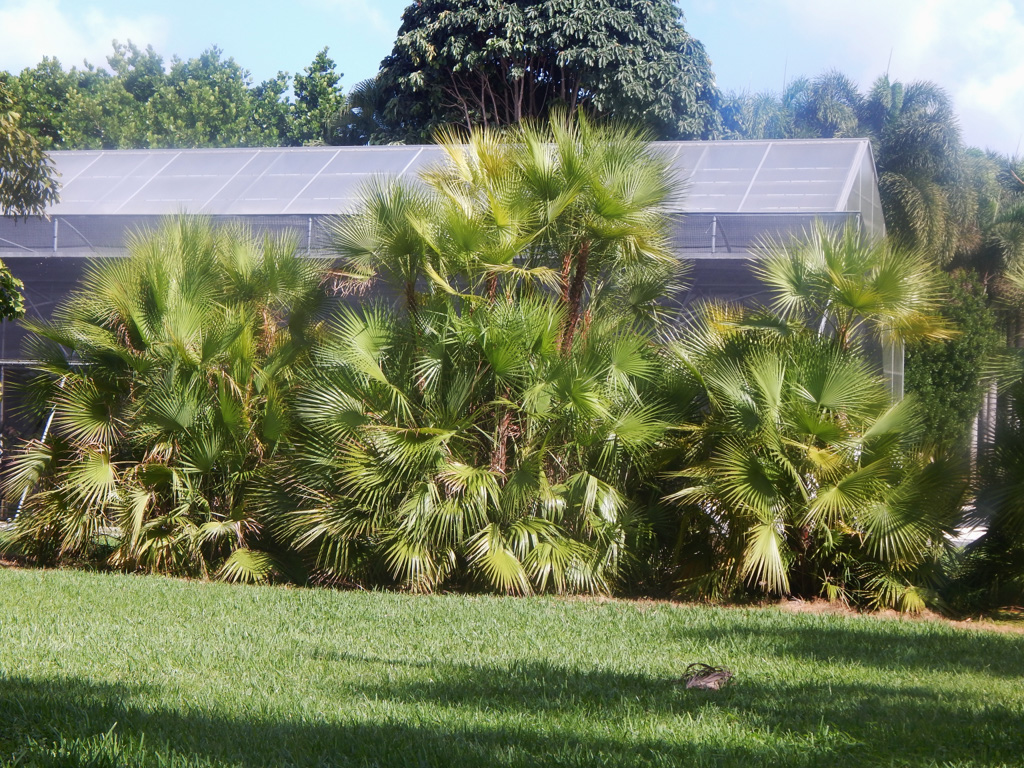
ACTINOKENTIA DIVARICATA
THE MINIATURE BLUSHING PALM
| Locality of Origin: New Caledonia Type of Palm / Leaf Type:Pinnate Solitary / Suckering: Solitary Plant Height Mature:15 to 20 feet Comments on Trunk: Thin and crown shafted Sun Requirements: Filtered light or a bit of sun Cold Tolerance: To 32 degrees F. or a bit lower – Best for warmer coastal areas Speed of Growth: Extremely slow Particular Characteristics: Narrow trunk, new leaf somewhat red Rarity: Extremely rare General Description / Comments: This is a very hard species to find. Growth rate is extremely slow. Definitely treat it as an understory species. |
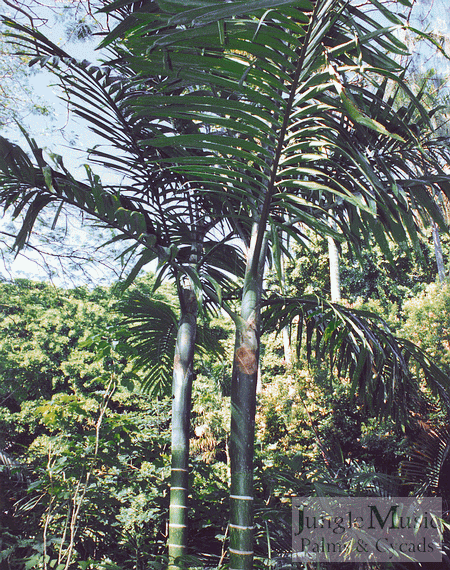
ALLAGOPTERA ARENARIA
THE BEACH PALM, SAND PALM
| Locality of Origin: Brazil and Argentina Type of Palm / Leaf Type: Pinnate Solitary / Suckering: Suckering, see below Plant Height Mature: 6 feet Comments on Trunk: Minimal trunk if any Sun Requirements: Full sun Cold Tolerance: To mid to low 20’s F. Speed of Growth: Slow to medium Particular Characteristics: TA very short palm that forms rhizomes and can form other plants. But, it is not truly a suckering species. Rarity: Very rare General Description / Comments: A cute and small palm. Most specimens are a single plant. It’s rarely over your head. Leaves are short and fluffy. Good small, full sun palm. Highly recommended |
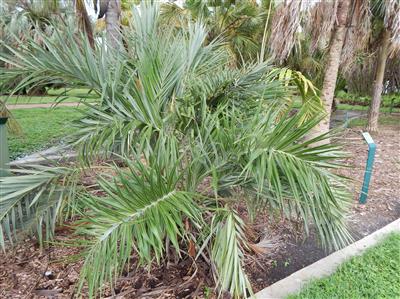
ARCHONTOPHOENIX ALEXANDRAE
ALEXANDER PALM
| Locality of Origin: Australia Type of Palm / Leaf Type: Pinnate Solitary/Suckering: Solitary Plant Height Mature: Can get over 50 feet Comments on Trunk: Medium thick, gray brown in color, very green crown shaft Sun Requirements: Full or part day sun Cold Tolerance: To about 26 degrees F. Speed of Growth: Fast growing Particular Characteristics: This is a species in the King Palm family. It has a nice, clean crown shaft. A variety “beatricea” has a swollen trunk base. It gets taller than the regular King Palm Rarity: Rare General Description/Comments: This species is a nice alternative to A. cunninghamiana and most feel is prettier. Growth requirements are about the same for both. |
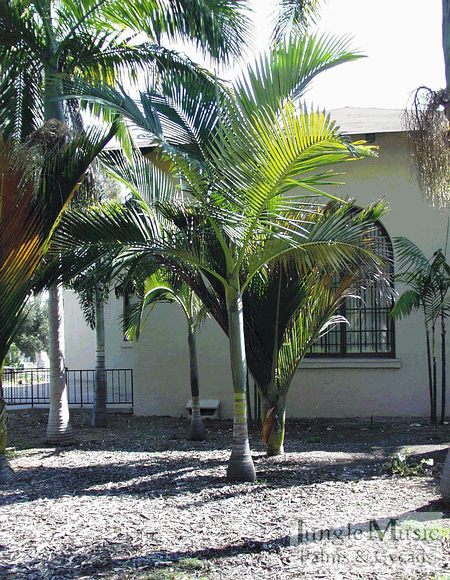
ARCHONTOPHOENIX CUNNINGHAMIANATHE CLASSICAL KING PALM
BANGALOW PALM, PICABEEN PALM
| Locality of Origin: Australia Type of Palm / Leaf Type: Pinnate Solitary/Suckering: Solitary, single trunk Plant Height Mature: 40 feet Comments on Trunk: Gray colored, faint rings, 12 to 18 inches thick Sun Requirements: Full sun near the ocean or part day sun inland Cold Tolerance: To about 25 degrees F. Speed of Growth: Fast Particular Characteristics: Often planted as “mulitples” with two or three together (photo). Such multiples grow slower than a single. This is a self pruning species with old leaves falling off on their own. The back of the leaves contain small black hairs called ramenta. It’s only seen on this species and the purpurea below. Rarity: Slightly General Description/Comments: Popular quick growing palm that likes water. It looks better if it gets about half day sun. In full sun, leaflets can brown-tip. |
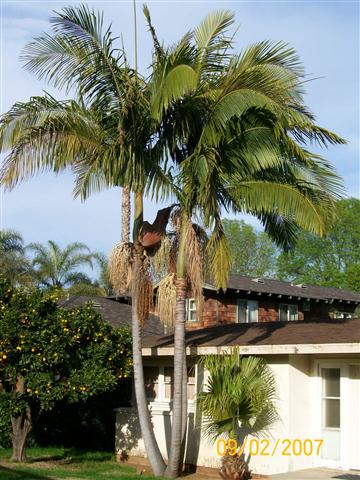
ARCHONTOPHOENIX PURPUREA
THE PURPLE CROWN SHAFT KING PALM
MOUNT LEWIS PALM TREE
| Locality of Origin: Mt. Lewis, Queensland, AU Type of Palm / Leaf Type: Pinnate Solitary/Suckering: Solitary Plant Height Mature: 30 to 40 feet Comments on Trunk: The crown shaft has a purple color. Don’t believe photos showing marked purple (photoshopped). Also, plants have to be trunking before good shaft color develops. Sun Requirements: Full or part day, especially inland Cold Tolerance: To 26 or 27 degrees F. Speed of Growth: Medium to fast Particular Characteristics: Attractive palm with silver back to leaflets and smaller crown than A. cunninghamiana. But, it’s not quite as cold hardy as the latter. The back of the leaflets has tiny dark hairs called “ramenta”. Rarity: Moderately rare General Description/Comments: This is an attractive species that most can grow in coastal areas. It has a smaller crown and overall appearance compared to the common King Palm. |
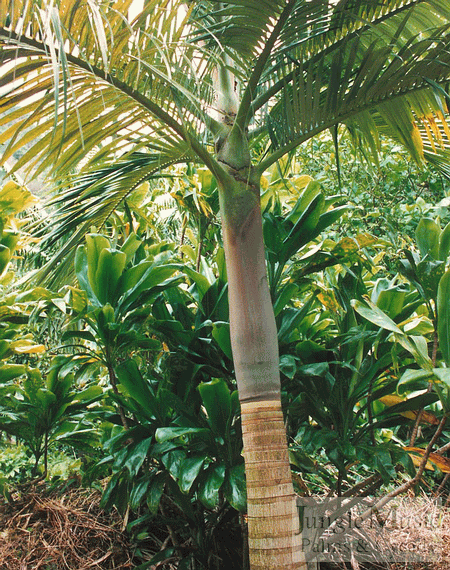
ARCHONTOPHOENIX MAXIMA
WALSH RIVER KING PALM
| Locality of Origin: Atherton tablelands, Australia Type of Palm / Leaf Type: Pinnate Solitary/Suckering: Solitary Plant Height Mature: 80 feet Comments on Trunk: 12 to 18 inches, medium green crown shaft, self-pruning Sun Requirements: Filtered to full sun Cold Tolerance: To about 25-27 degrees F. Speed of Growth: Medium Particular Characteristics: Long leaves that, along their axis, can twist a little. Minimal silver if any to back of leaves. New leaves can have a faint red color. Rarity: Moderately rare General Description/Comments: This is a very tall and large form of King Palm. It can dwarf a regular King Palm. It is attractive and seems to be easy to grow in our area. Photo by L.N. |
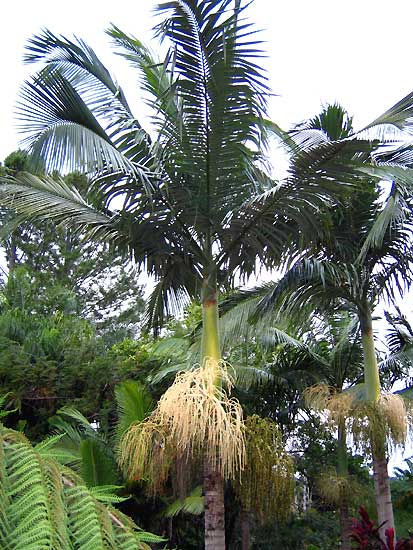
ARCHONTOPHOENIX MYOLENSIS
THE MYOLA PALM
| Locality of Origin: NW Queensland, Australia Type of Palm / Leaf Type: Pinnate Solitary/Suckering: Solitary Plant Height Mature: 50 to 60 feet Comments on Trunk: The most prominent thing is the green, sometimes blue-green, very clean crown shaft. It’s super attractive. Sun Requirements: Part to full sun Cold Tolerance: To about 25 to 26 degrees. Almost as cold hardy as the classic King Palm Speed of Growth: Moderately fast Particular Characteristics: As above, a gorgeous crown shaft. Silver underside to leaflets which can hang downwards. Rarity: Moderately rare General Description/Comments: This is often a favorite among enthusiast because of the gorgeous crown shaft. The leaves have a gentle arch downwards. Highly recommended |
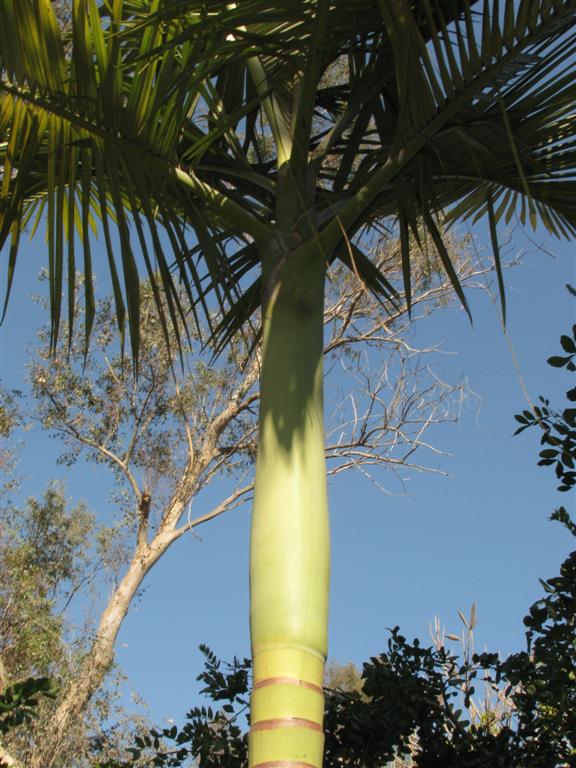
ARCHONTOPHONIX “TERACARPA”LARGEST KING PALM EVER – DOESN’T BROWN TIP
| Locality of Origin: Not positive, but probably Australia Type of Palm / Leaf Type: Pinnate Solitary/Suckering: Solitary Plant Height Mature: Unknown, probably 6o to 80 feet Comments on Trunk: This type of King Palm has a massively wide trunk that almost looks like a Royal Palm. Gray in color. Crown shat is blue-green with a hint of yellow. Sun Requirements: Full sun – inland part sun Cold Tolerance: Uncertain, probably 25 degrees F. Speed of Growth: Very Fast. It towers over regular King Palms of the same age in the ground. Particular Characteristics: It’s amazing how this “species” is so big, fast, with huge dark green leaves and NO brown-tipping on the leaflets in full sun. Customers growing inland tell us the same! It is highly recommended. Rarity: Very rare General Description/Comments: This is a species we gave the name “teracarpa” to describe how it has a “large body”. It’s fast growing, takes our full sun and has been called “The Best King Palm to buy”. No one can identify it. Seeds come from the specimen shown here in our garden. It’s a spectacular palm and is highly recommended. |
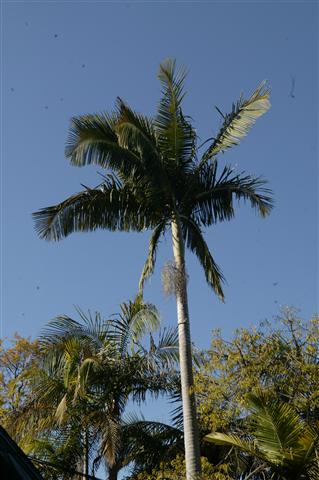
ARENGA ENGLERI
THE DWARF SUGAR PALM
THE FORMOSA PALM
| Locality of Origin: Taiwan and Ryukyu Islands Type of Palm / Leaf Type: Pinnate Solitary/Suckering: Suckering Plant Height Mature: 8 to 12 feet Comments on Trunk: 6 inch diameter and fibrous Sun Requirements: Filtered light, partial sun or full sun along the coast Cold Tolerance: To about 18 degrees F. Speed of Growth: Slow Particular Characteristics: Slowly over time will form suckers to make clumping palm. Leaflet tips are jagged while backside of leaflets are silver. Has very fragrant blossoms. Each stem is monocarpic, dying after blossoming. Rarity: Rare General Description/Comments: This is a fairly rugged and durable species for part sun in most areas. It provides privacy but doesn’t get overly tall. Cold hardiness is good and is being grown well in Northern California. Highly recommended |
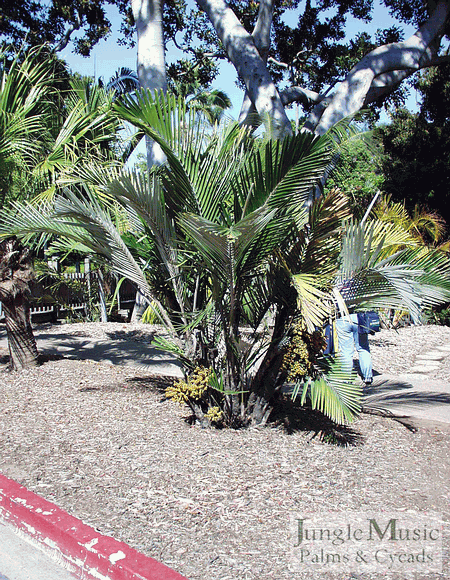
ARENGA PINNATA
THE SUGAR PALM
THE BLACK SUGAR PALM
| Locality of Origin: India south through Indonesia Type of Palm / Leaf Type: Pinnate Solitary/Suckering: Solitary Plant Height Mature: 30 feet or taller Comments on Trunk: Thick and fibrous Sun Requirements: Full sun Cold Tolerance: To about 28 degrees F., possibly a bit colder Speed of Growth: Moderate Particular Characteristics: This is a thick trunked, monocarpic species that dies after flowering. Back side of leaflets is silver. Rarity: Rare General Description/Comments: This is a medium to large single trunk feather palm that takes a freeze and a bit colder. It needs room to grow and can take full sun in most coastal areas. |
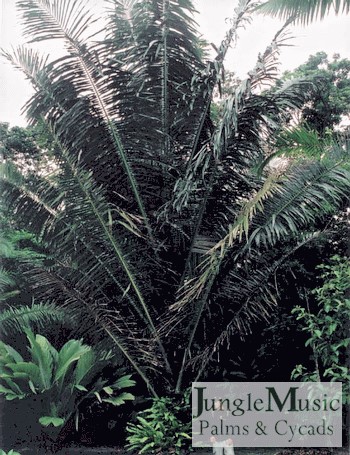
ARENGA MICRANTHA
NEWLY DISCOVERED SPECIES
| Locality of Origin: Southeast Asia at very high elevations, over 5000 feet Type of Palm / Leaf Type: Pinnate Solitary/Suckering: Suckering Plant Height Mature: 20 feet mature Comments on Trunk: Thicker than A. engleri and fibrous Sun Requirements: Full or part sun Cold Tolerance: To upper teens with reports of it surviving 16 degrees F. Speed of Growth: Moderate Particular Characteristics: Twice as tall as Arenga engleri. Large flat leaves, evenly spaced with prominent white on the underside. Rarity: Extremely rare General Description/Comments: This is a newly discovered and describe suckering species that is the most cold hardy of all the Arenga. It does sucker and get to 20 feet tall. This is a species that should prove to be ideal for those in colder areas. Photo by richnorm at Palmtalk. |
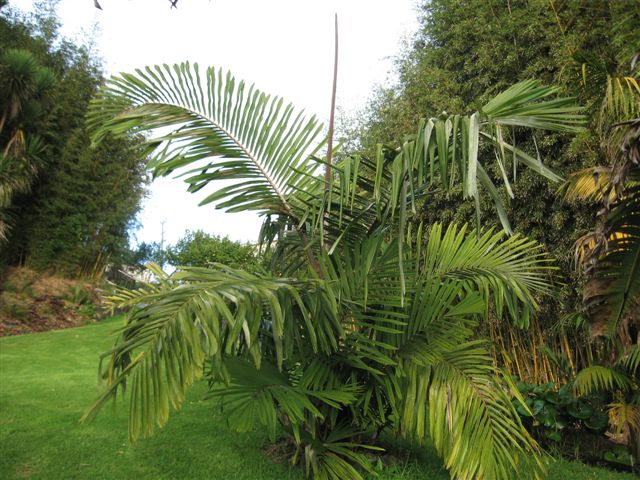
BECCARIOPHOENIX ALFREDII
HIGH PLATEAU COCONUT PALM
BECCARIOPHOENIX “WINDOWS FORM”
| Locality of Origin: Madagascar – above 3000 feet Type of Palm / Leaf Type: Pinnate Solitary/Suckering: Solitary – no suckers Plant Height Mature: 40 feet or more Comments on Trunk: About 12 inches thick and smooth, ringed Sun Requirements: Full sun coastal areas Cold Tolerance: To about 20 degrees. Most cold hardy of the genus Speed of Growth: Moderate Particular Characteristics: Recently discovered. Closely related to Cocos nucifera, the Coconut Palm. Long green leaves, droopy leaflets. This palm is highly recommended Rarity: Very rare General Description/Comments: This is a great new introduction to the market and difficult to find. Many feel it is similar appearing to the Coconut Palm. It’s a larger palm and needs room but is spectacular appearing and highly recommended. Photo by TS at RPS |
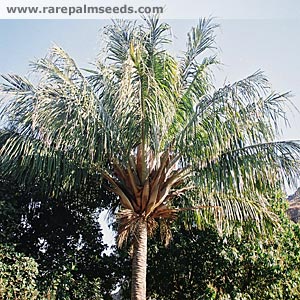
BECCARIOPHOENIX FENESTRALIS
MADAGASCAR WINDOW PALM
BECCARIOPHOENIX “WINDOWS” FORM
| Locality of Origin: Madagascar Type of Palm / Leaf Type: Pinnate Solitary/Suckering: Solitary Plant Height Mature: 20 to 30 feet or more Comments on Trunk: About 12 to 16 inches. Retained leaf bases fall off to make smooth trunk over time Sun Requirements: Full sun Cold Tolerance: Not as cold hardy as alfredii – probably upper 20’s F. Speed of Growth: Slow to medium Particular Characteristics: Spectacular larger palm when grown well but suffers with significant cold. It got it’s name from the open “windows” on juvenile plants. Large crown of leaves. Rarity: Very rare General Description/Comments: This is an interesting palm that was discovered about two decades ago. If one can grow it, it is spectacular. The main issue is how cold your garden gets. Photo by the late Ray Baker |
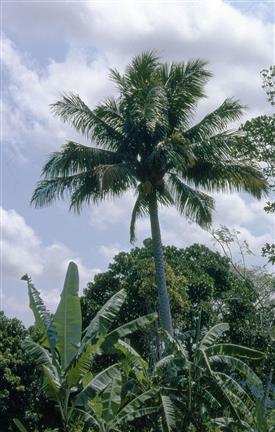
BISMARCKIA NOBILIS
THE BISMARCK PALM
| Locality of Origin: Madagascar Type of Palm / Leaf Type: Blue fan palm Solitary/Suckering: Solitary Plant Height Mature: 40 feet or more Comments on Trunk: 14 to 18 inches, smooth over time Sun Requirements: Full sun Cold Tolerance: To mid, possibly low 20’s F. Speed of Growth: Moderate Particular Characteristics: Spectacular blue fan palm that is a statement palm. Loves heat and sun. Leaves are broad and slightly wavy. This species can hold 20 leaves or more. It is very subject to root damage (causes demise) and can die when juvenile if roots at bottom of pot are torn. Rarity: Fairly rare General Description/Comments: This is a definite statement, “show stopper” palm that requires room to grow and for viewing. Give it adequate sun and room to grow. It is subject to damage or death by gophers. The blue form (photo) is most popular but there is a green variety as well. This palm is highly recommended. |
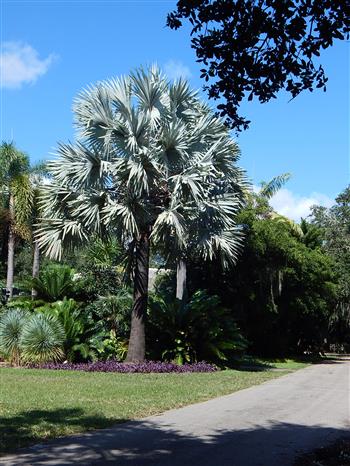
BISMARCKIA SPECIES MAYOTTE ISLAND
THE GREEN BISMARCKIA
| Locality of Origin: Comoros Archipelago Type of Palm / Leaf Type: Palmate, fan palm Solitary/Suckering: Solitary Plant Height Mature: 30 to 40 feet Comments on Trunk: Trunk diameter about 18 inches Sun Requirements: Full sun Cold Tolerance: To about 24-25 degrees F. Speed of Growth: Moderate Particular Characteristics: This variety of species of Bismarckia is similar in many ways to the blue form – see above. But, its leaves a green or blue green and it tolerates moist conditions better. Most people like the blue form, but if you prefer the green, this species is for you. wear Rarity: Very rare General Description/Comments: This is a green leaf form of Bismarckia. We’ve found they can take 25 degrees in containers with no problems and grow about like their blue sister. Photo by TS at RPS |

BRAHEA ARMATATHE MEXICAN BLUE FAN PALM
BLUE HESPER PALM
| Locality of Origin: Baja California, Mexico Type of Palm / Leaf Type: Fan palm Solitary/Suckering: Solitary Plant Height Mature: Can get to 40 feet but domestically, rarely over 20 feet Comments on Trunk: Younger trunks have retained leaf bases but smooth as tree matures Sun Requirements: Full hot sun Cold Tolerance: To about 15 degrees F. Speed of Growth: Slow Particular Characteristics: Medium sized blue fan palm. Leaves basically flat and about 4 to 6 feet across. If not sun grown, may die. Plants in part day sun may turn green. Mature trees more intensely blue than along the coast. Takes three decades to get 20 feet tall. Rarity: A bit rare General Description/Comments: This is a nice specimen type palm that has intense blue color in full hot sun. They dig poorly and can die from root damage. Great palm for inland or desert areas. |
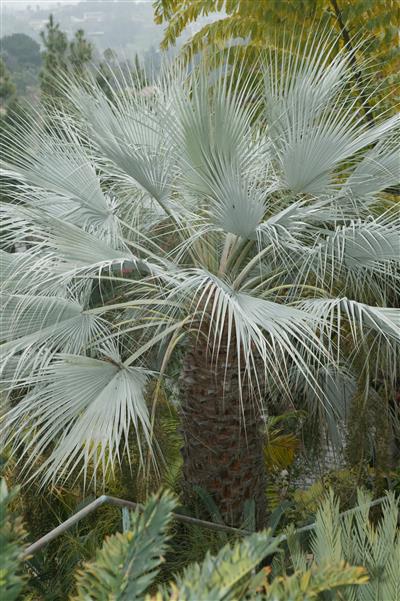
BRAHEA BRANDEGEEI
SAN JOSE HESPER PALM
| Locality of Origin: Baja California, Mexico Type of Palm / Leaf Type: Fan palm Solitary/Suckering: Solitary Plant Height Mature: 40 to 60 feet, tallest species of genus Comments on Trunk: Thin for a Brahea, about 12 inches or less Sun Requirements: Full sun Cold Tolerance: To low 20’s or upper teens F. Speed of Growth: Moderate to fast Particular Characteristics: A very attractive thin trunked and tall fan palm. Leaves are green sometimes with a hint of blue. Upper leaf bases are retained but fall off with age. Rarity: Moderately rare General Description/Comments: This is a nice choice for someone who wants a faster growing fan palm that gets some height but not as much as the Mexican Fan Palm. Looks good planted as a multiple. Head of leaves not overly large. |
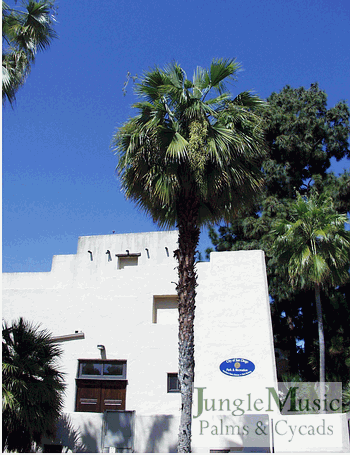
BRAHEA DECUMBENS
MEXICAN DWARF BLUE FAN PALM
SUCKERING SPECIES
| Locality of Origin: Northeast Mexico Type of Palm / Leaf Type: Dwarf fan palm Solitary/Suckering: Suckering Plant Height Mature: 6 feet or a bit more Comments on Trunk: Minimal trunk with rough surface Sun Requirements: Full sun – Won’t survive in shade Cold Tolerance: To about 16 to 18 degrees F. Speed of Growth: Extremely slow Particular Characteristics: Attractive small blue suckering fan palm. Leaves are about 3 feet across and clumps never take up too much space. Wants full sun, preferable hot sun. Rarity: Very rare General Description/Comments: This is an ideal palm for a shorter plant is needed in full sun. They are very slow to put on vertical height. This palm is highly recommended. |
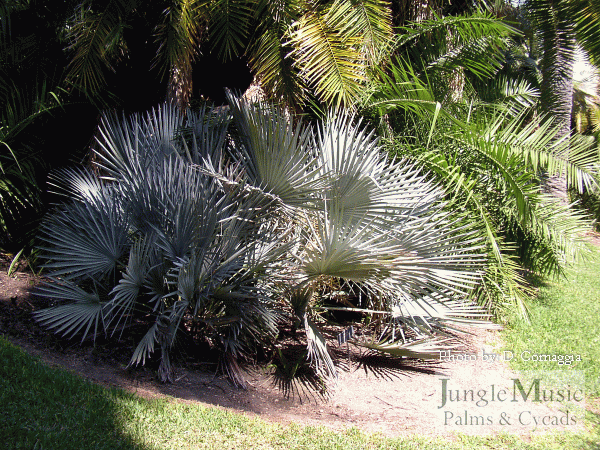
BRAHEA DULCIS
THE ROCK PALM
| Locality of Origin: From Rio Grande Valley, TX through Mexico down to Guatemala Type of Palm / Leaf Type: Fan palm, leaf color blue to green Solitary/Suckering: Solitary or suckering Plant Height Mature: Variable, are shorter forms to 8 feet, taller forms to 20 feet Comments on Trunk: See above. Rough texture Sun Requirements: Variable. Can take strong filtered light to full sun Cold Tolerance: Mid-twenties F. or a bit lower Speed of Growth: Slow to medium Particular Characteristics: This is a very variable species and can be short or small with green or almost blue leaves. Heights are variable but I’d say most are in the 10 to 12 foot range. Rarity: Very rare General Description/Comments: This is an interesting palm because it is very variable in all aspects. If you want a blue one, look for the blue variety. Most stay smaller and can tolerate some shade. The blue form is hard to find. |
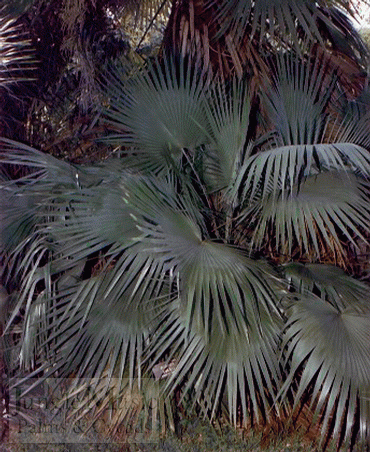
BRAHEA EDULIS
THE GUADALUPE FAN PALM
| Locality of Origin: Guadalupe Island off the coast of Northern Baja, Mexico Type of Palm / Leaf Type: Fan palm Solitary/Suckering: Solitary Plant Height Mature: 15 feet, rarely taller – in the wild to over 20 feet or more Comments on Trunk: Moderately thick trunk to 18 inches Sun Requirements: Full sun Cold Tolerance: To upper teens F. Speed of Growth: Very slow growing Particular Characteristics: Nice palm for planting along a street parkway, in a shopping center or commercial complex. This is because it’s slow growing and never gets too big. Leaves are green, trunk is smooth but checkered and fruits are black. Rarity: Moderately rare General Description/Comments: This is an attractive short to medium sized fan palm. On Guadalupe Island, native populations are endangered because introduced goats eat all the young seedlings. So, there are only mature trees in habitat. |

BRAHEA SPECIES “SUPER SILVER”
THE SILVER ROCK PALM
NEWLY DISCOVERED
| Locality of Origin: Central Mexico, high elevation Type of Palm / Leaf Type: Blue fan palm without thorns on leaf stems Solitary/Suckering: Solitary Plant Height Mature: 15 foot estimate Comments on Trunk: Smooth when mature. No domestic mature trees for study. Sun Requirements: Full sun Cold Tolerance: Unknown, but estimated upper teens F. Speed of Growth: Unknown but medium as a nursery plant Particular Characteristics: This is sort of like a thin trunked Brahea armata without spines or thorns on the leaf stems. Leaf color is reported to be very intense blue. Note, like Brahea decumbens, these are green when juvenile. Rarity: Extremely rare- undescribed and recently discovered General Description/Comments: This is an exciting new species with blue color. Enthusiasts are excited but there is little data about this species. Photo c/o Tobias Spanner RPS |
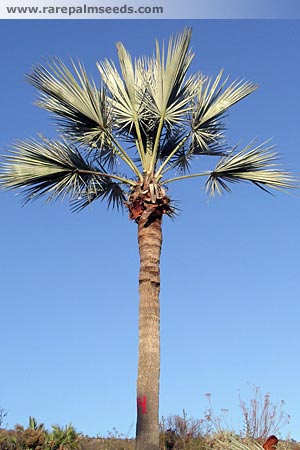
BURRETIOKENTIA HAPALA
NO ACCEPTED COMMON NAME
| Locality of Origin: New Caledonia, typically on slopes Type of Palm / Leaf Type: Pinnate Solitary/Suckering: Solitary Plant Height Mature: 30 feet plus Comments on Trunk: Thin for height, green, prominently ringed, brown furry blossoms Sun Requirements: Strong filtered light or some sun Cold Tolerance: Mid-twenties F. Speed of Growth: Medium. Easiest species of genus to grow Particular Characteristics: Super attractive medium height palm with thin trunk. Being grown by many. Flat green leaves with green to brown crown shaft and ringed trunk. Be careful with sun far inland. Rarity: Very rare General Description/Comments: This is a highly recommended crown shafted palm that is very tropical appearing with lush green leaves. They like rich, well draining soil and plenty of water. |
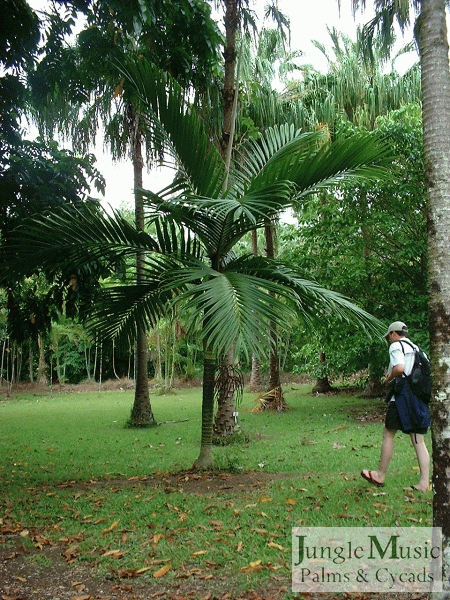
BURRETIOKENTIA KOGHIENSIS
THE MOUNT KOGHI PALM
| Locality of Origin: New Caledonia in rainforest outside Noumea on Mt. Koghi Type of Palm / Leaf Type: Pinnate Solitary/Suckering: Solitary, does not sucker Plant Height Mature: 20 to 40 feet Comments on Trunk: Thin for height, prominently ringed green trunk with silver-green crown shaft Sun Requirements: Filtered light or part day sun. Right on the Coast, perhaps full sun Cold Tolerance: To mid-twenties F. Speed of Growth: Moderate Particular Characteristics: Very attractive species with a thin trunk, silver crown shaft and prominently ringed green trunk. Rarity: Very rare General Description/Comments: This is another gorgeous New Caledonian palm that should excite any palm enthusiast. |
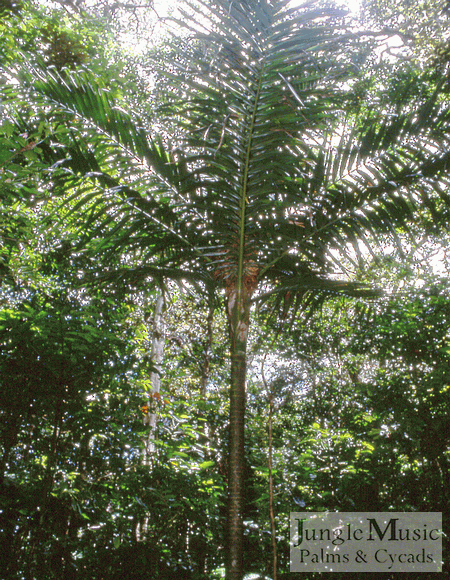
BURRETIOKENTIA VIELILLARDII
THE TIGER PALM
| Locality of Origin: New Caledonia, through the island Type of Palm / Leaf Type: Pinnate, single trunk Solitary/Suckering: Solitary Plant Height Mature: 30 to 40 feet, often piercing the canopy Comments on Trunk: Thin for overall height. Green trunk with prominent rings. The most spectacular aspect are the brown pinstripes on a lighter colored crown shaft. See second photo for details. Thus it received the name “Tiger Palm” Sun Requirements: Filter light to part day sun. Avoid full sun in far inland or desert areas. On the coast cautiously try full sun. Remember, when larger, will pierce canopy to emerge into the full sun. Cold Tolerance: Mid-twenties F. Speed of Growth: Moderate, but slower than the other two species of Burretiokentia shown above. Particular Characteristics: Note with the two photos shown here the thin trunk and the very attractive striped crown shaft. Keep up with heavy water for this species. Rarity: Very rare General Description/Comments: This is one of the finest species of palms that you can introduce into your garden. Although it gets tall, the trunk is thin and the crown of leaves is not overly large. This is a super attractive species. Second photo here by friend Rolf Kyburz. |


BUTIA CAPITATA
THE PINDO PALM – JELLY PALM
VARIABLE SPECIES – GREEN TO BLUE
| Locality of Origin: Brazil and Uruguay – Note that there are variable appearances depending on locality Type of Palm / Leaf Type: Pinnate Solitary/Suckering: Solitary Plant Height Mature: 15 feet or a bit taller Comments on Trunk: Somewhat rough with retained leaf bases at top. Diameter 18 inches Sun Requirements: Full sun all areas Cold Tolerance: To 15 or 16 degrees F. Speed of Growth: Ex Particular Characteristics: This is a confusing species as appearances change according to habitat localities. Some species are shorter, others taller and leaf color is from green to blue-green to blue. ear Rarity: Common General Description/Comments: This is a nice palm because it is durable, tolerates full hot sun and is easy to grow. As mentioned, there are various localities. Taxonomists are pushing to change the name of this species to “Butia odorata“. But, this is confusing to most. So, we stick with the historical name for now. Fruits as edible and used to make jelly. |
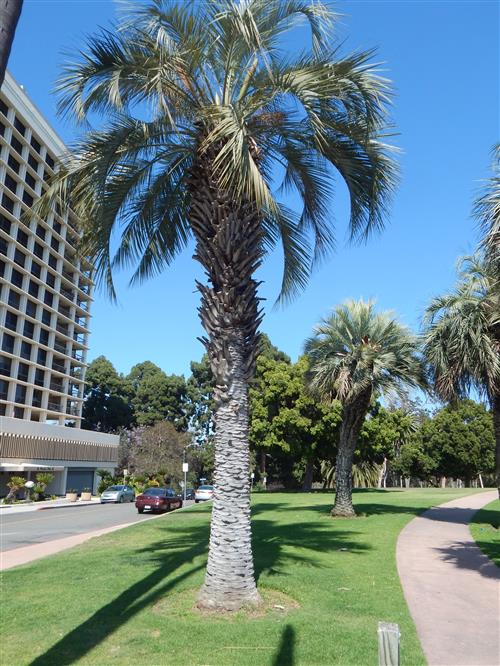
BUTIA CAPITATA
BLUE FORM
| Locality of Origin: Above Type of Palm / Leaf Type: Pinnate Solitary/Suckering: Solitary Plant Height Mature: 15 to 20 feet Comments on Trunk: 18 inches Sun Requirements: Full hot sun Cold Tolerance: 15 to 16 degrees Speed of Growth: Moderate Particular Characteristics: As above General Description/Comments: This is solely a variety of Butia capitata that is known for its prominently blue color. Otherwise, all information above applies. I’m showing it because of its increasing popularity. photo by friend, Paul Craft |

BUTIA ERIOSPATHA
THE WOOLY JELLY PALM
| Locality of Origin: Brazil Type of Palm / Leaf Type: Pinnate Solitary/Suckering: Solitary Plant Height Mature: 15-20 feet Comments on Trunk: Moderately thick and rough Sun Requirements: Full sun Cold Tolerance: To 16-18 degrees F. Speed of Growth: Moderate Particular Characteristics: Similar to Butia capitata except for wool on the spathes. This wool is rusty colored. Leaves are blue-green and re-curved. Rarity: Very rare General Description/Comments: This is a full sun plant that is hard to find, medium sized mature. |
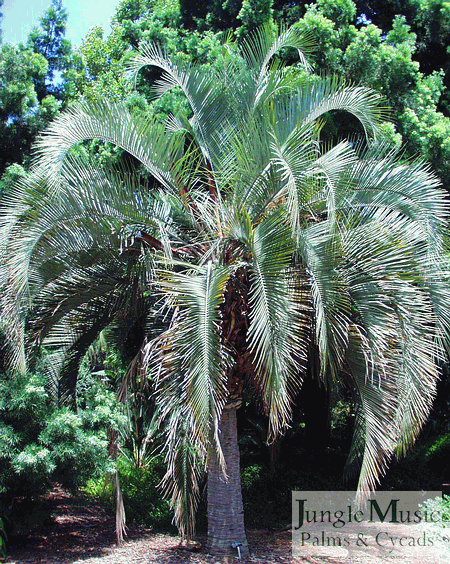
BUTIA HYBRID
BUTIA CAPITATA X SYAGRUS ROMANZOFFYANA
THE MULE PALM
| Locality of Origin: Man-made or open pollination hybrid Type of Palm / Leaf Type: Pinnate Solitary/Suckering: Solitary Plant Height Mature: 20 to 25 feet Comments on Trunk: Variable, but about 12 to 14 inches Sun Requirements: Full sun Cold Tolerance: Down to about 16 to 17 degrees Speed of Growth: Moderate Particular Characteristics: This hybrid is very popular because it has good cold tolerance, tolerates desert sun and resembles the Coconut Palm. Leaves are green, arching and the trunk is fairly smooth. There is no crown shaft. Rarity: Very rare General Description/Comments: This is a study hybrid showing “hybrid vigor”. It’s easy to grow and survives full sun in many desert areas. It’s also attractive and can be a true statement palm. This palm is highly recommended. |

CARYOTA GIGAS
THAI MOUNTAIN GIANT
THE “BLACK STEM” FISHTAIL
| Locality of Origin: Northern Thailand Type of Palm / Leaf Type: Pinnate but with bifurcation of the main leaf stem. This is known as a “bipinnate” leaf. Solitary/Suckering: Solitary Plant Height Mature: 35 feet Comments on Trunk: Thick trunk to about 30 inches, mostly at the base. Because of this and the long leaves, it has to be planted a good distance from structures. Sun Requirements: Full sun Cold Tolerance: To about 22 degrees F. Not as cold hardy as Caryota urens below. Speed of Growth: Fast growing once established Particular Characteristics: This is a big palm – not so much by height but rather by trunk diameter and leaf length and width. Leaves can be 14 feet long and equally as wide. These are bipinnate leaves with very attractive green leaflets. Rarity: Moderately rare General Description/Comments: This is the most popular Fishtail Palm and needs room away from structures. It likes rich soil and plenty of water. It is monocarpic and dies after blossom. But, for its fifteen year life, it is very beautiful and is a canopy forming species. It is highly recommended. |
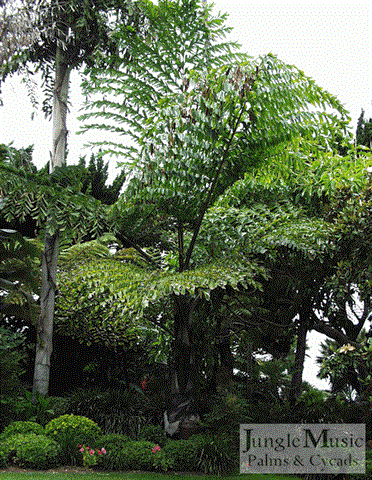
CARYOTA URENS
THE COLD HARDY MOUNTAIN FISHTAIL
| Locality of Origin: Northern Thailand and surrounding countries Type of Palm / Leaf Type: Pinnate with bipinnate leaves as described above Solitary/Suckering: Solitary Plant Height Mature: 50 or more feet tall Comments on Trunk: Thickness about 18 inches. Sun Requirements: Full sun. Because of it’s height, it has to tolerate full sun. If you see a lof of leaftip burning, it needs more water! Cold Tolerance: To about 18 degrees F. This is the most cold hardy of the Caryotas. Speed of Growth: Very quick growing once established Particular Characteristics: This is a super tall palm. It’s trunk is about the thickness of a telephone pole. Leaves are green and about 12 feet long. This plant likes water. Rarity: Rare General Description/Comments: This is probably the fastest growing palm you can buy. It does need room to grow. It establishes canopy shade. It dies when it blossoms – usually about 20 years of age. |
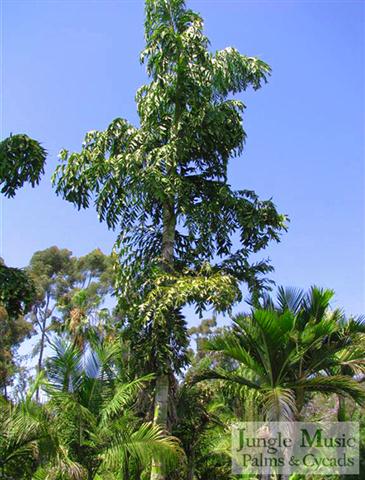
CARYOTA MITIS
THE CLUSTERING FISHTAIL PALM
| Locality of Origin: Southeast Asia including India to China and down into the Indonesian Islands Type of Palm / Leaf Type: Pinnate with bipinnate leaves Solitary/Suckering: Suckering species with multiple trunks over time Plant Height Mature: 15 to 20 feet Comments on Trunk: Thin compared to species above. Average diameter 4 to 6 inches. Sun Requirements: Filtered light, part day sun or along the coast maybe full sun Cold Tolerance: To Speed of Growth: Mid to possible low 20’s F. F. Particular Characteristics: Attractive medium height suckering Fishtail Palm. When one trunk/stem blossoms, it slowly dies but is replaced by other trunks. Rarity: Rare General Description/Comments: This is a nice palm that doesn’t get too big and is attractive. It does best in part day sun and can be used as a patio plant. |
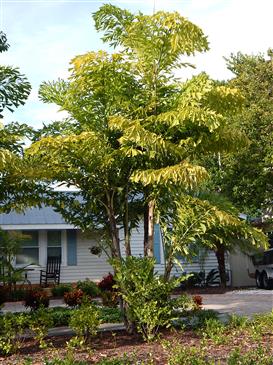
CARYOTA NO
A TROPICAL LOOKING FISHTAIL PALM
| Locality of Origin: Borneo Type of Palm / Leaf Type: Pinnate, bipinnate as described above Solitary/Suckering: Solitary Plant Height Mature: 40 to 60 feet Comments on Trunk: Thickness 18 inches Sun Requirements: Full sun Cold Tolerance: To about a freeze (32 degrees F.) Speed of Growth: Fast growing Particular Characteristics: When I first saw this palm in Indonesia, I thought it was a maidenhair fern in the sky. Leaves are green with small leaflets and a very tropical, full appearance. This is another monocarpic species that dies when it blossoms. I had one that grew to maturity and blossomed in San Diego. Rarity: Very rare General Description/Comments: This is a gorgeous palm. It does get tall but, of all the Fishtails, is the most lush and tropical appearing. The question is do you stay warm enough in winter to grow it? |
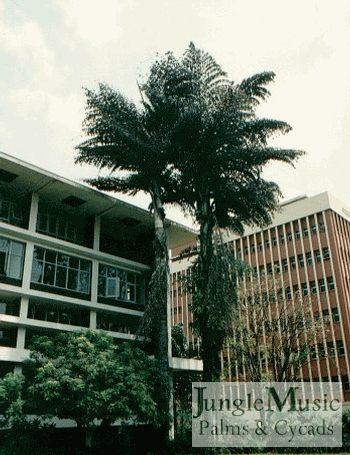
CEROXYLON QUINDIUENSE
ANDEAN WAX PALM
TALLEST PALM IN THE WORLD
| Locality of Origin: Andes Mountains in Columbia and Peru Type of Palm / Leaf Type: Pinnate Solitary/Suckering: Solitary Plant Height Mature: Can get to over 100 feet with some plants measured at near 150 feet, making these the tallest palms in the world. Comments on Trunk: Thin for height of palm. Average trunk diameter about 18 inches. Sun Requirements: Full sun. But, begin in filtered or part day sun and let it grow up into the sun. Harsh sun on young plants can kill them. Cold Tolerance: About 18 degrees F. Easy to grow in parts of Northern California. Speed of Growth: Slow at first, but better with age. Particular Characteristics: This species likes water and filtered light when young. Let it reach the sun on its own. They do not like hot dry air. If it sees this, give it extra water. Leaves are green and, if successful growing it, you’ll end up with a very tall palm. Rarity: Very rare General Description/Comments: Ceroxylon are a bit difficult to get going. But, once established, they do better and are not that slow. Just remember to water it adequately. Photo by Jeff Anderson |
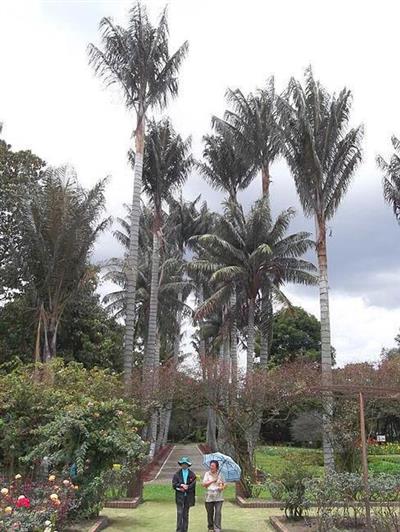
CEROXYLON OTHER SPECIES
ALL ARE TYPES OF WAX PALMS
There are about a dozen other species of Ceroxylon with native Andean habitats in Columbia, Peru, Venezuela, Uruguay, Ecuador, and Bolivia. Most live at high elevations and all are single trunk and tall. These palms are all green leafed with gray to light tan trunks that are thin for the plant height. All are dioecious, meaning that you must have a male and female tree to produce viable seeds. We have various types available from time to time but not in quantities. The tall specimen to the right is from a seedling purchased at our nursery and planted over a decade ago. Other species of Ceroxylon would include:
Ceroxylon alpinum
Ceroxylon amazonicum
Ceroxylon echinulatum
Ceroxylon parvifrons
Ceroxylon ventricosum
Ceroxylon vogelianum
and others
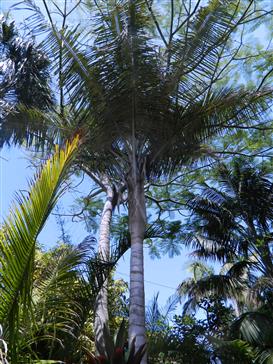
CHAMAEDOREA COSTARICANA
COSTA RICAN BAMBOO PALM
TALLER BAMBOO PALM
| Locality of Origin: Central America Type of Palm / Leaf Type: Pinnate Solitary/Suckering: Suckering forming small clumps of stems Plant Height Mature: 14 to 16 feet Comments on Trunk: Green, prominently ringed with diameters of 1 to 1.5 inches Sun Requirements: Filtered light or a bit of morning sun Cold Tolerance: To mid to low 20’s F. Speed of Growth: Moderate Particular Characteristics: This is a very attractive and satisfying Bamboo Palm to grow in the garden because it’s largely disease free and easy to grow. It has green leaves that are three to four feet long, flat and have bare leaf stems. If put into full sun, at best plants are yellow and don’t thrive. It does like adequate water. Rarity: Moderately rare General Description/Comments: This is a highly recommended understory palm. Compared to C. seifrizii, it is far superior. It’s attractive, lush, and tropical appearing. |
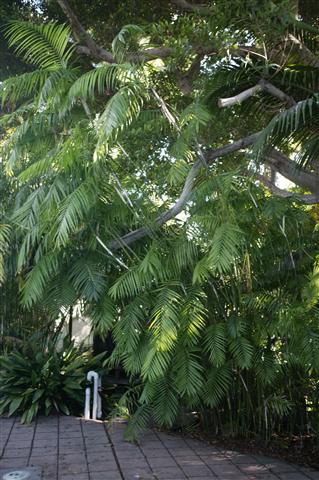
CHAMAEDOREA HOOPERIANA
ANOTHER GREAT BAMBOO PALM
| Locality of Origin: Veracruz, Mexico Type of Palm / Leaf Type: Pinnate Solitary/Suckering: Clustering Plant Height Mature: 12 to 14 feet Comments on Trunk: Thin, green, prominently ringed. Diameter about an inch. Sun Requirements: Filtered light Cold Tolerance: Mid to lower 20’s F. Speed of Growth: Moderate Particular Characteristics: Desirable species of Bamboo Palm that is a bit fuller and shorter, and has longer leaves than C. costaricana above. Leaves are green and about five feet long. Rarity: Moderately rare General Description/Comments: This is great palm named by Don Hodel after our friend, Luis Hooper from Orange County, CA. Luis was on the expedition when it was found. Well grown, it’s lush, tropical appearing and beautiful. The photo shows a mature specimen at the nursery. |

CHAMAEDOREA ERNESTI-AUGUSTI
THE DWARF WHALE TAIL PALM
ERNEST’S AUGUST PALM
| Locality of Origin: Mexico and Central American counties Type of Palm / Leaf Type: Simple leaf with no lateral leaflets – Solid or bifed leaf Solitary/Suckering: Solitary Plant Height Mature: to 6 feet Comments on Trunk: Thin, about 3/4 on an inch Sun Requirements: Filtered light Cold Tolerance: To the mid 20’s F. Speed of Growth: Slow to medium Particular Characteristics: Simple green leaves as shown. Leaf size about 12 to 18 inches. No armor. Thin stems. Flower bracts are orange, seeds black on females. Is a dioecious species as are all Chamaedorea. Rarity: Moderately rare General Description/Comments: This is a very cute understory palm that, in a decade or two, can get overhead a bit. This species looks best if planted in colonies. |
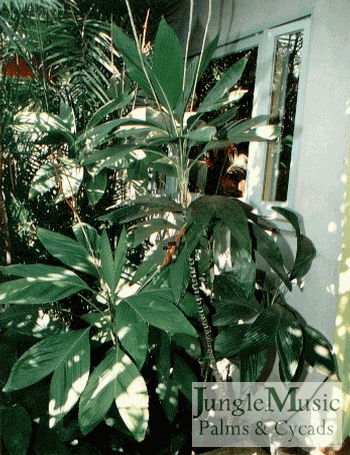
CHAMAEDOREA GEONOMIFORMIS
THE CAPUCA PALM
| Locality of Origin: Southern Mexico and Central America Type of Palm / Leaf Type: Simple, Bifed Leaf – a type of pinnate leaf without leaflet division Solitary/Suckering: Solitary Plant Height Mature: 3 to 6 feet, usually 2 to 3 feet Comments on Trunk: Thin, 1/2 inch Sun Requirements: Filtered light Cold Tolerance: Mid-twenties F. Speed of Growth: Slow Particular Characteristics: This palm is similar to C. ernesti-augusti above with the leaves are more narrow. These solid, simple leaves are green. Stems are narrow and there is no armor on this palm. Rarity: Very rare General Description/Comments: This palm is another “cute” understory palm that is easy to grow if you don’t get too cold. Possibly can be grown as an indoor palm. |
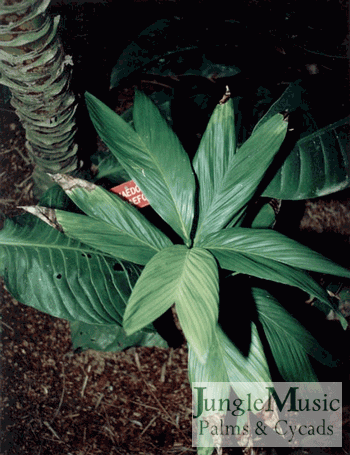
CHAMAEDOREA MICROSPADIXTHE COLD HARDY BAMBOO PALM
| Locality of Origin: Mexico Type of Palm / Leaf Type: Pinnate Solitary/Suckering: Suckering Plant Height Mature: 8 feet Comments on Trunk: Thin, 1/2 inch diameter Sun Requirements: Filtered light Cold Tolerance: Known to tolerate temperatures down to 18 degrees F. Easy to grow in many areas of Northern California Speed of Growth: Medium Particular Characteristics: Narrow green trunks, leaves 2 to 3 feet long, green in color, often with an iridescent sheen, and short, wide leaflets. There are forms with glaucous backs to the leaves. See photo to right to see the sheen. Rarity: Rare General Description/Comments: This is a shorter type of Bamboo Palm that is fairly cold hardy, easy to grow and doesn’t overwhelm an area. |
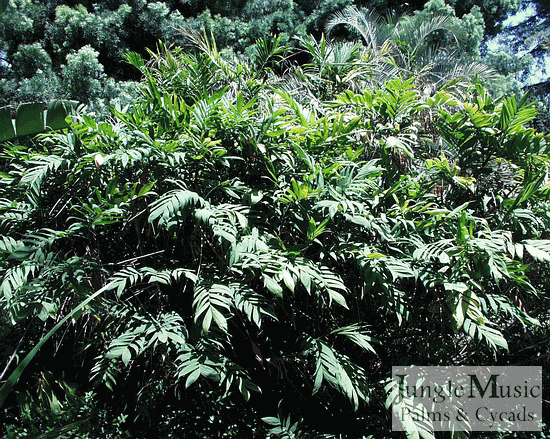
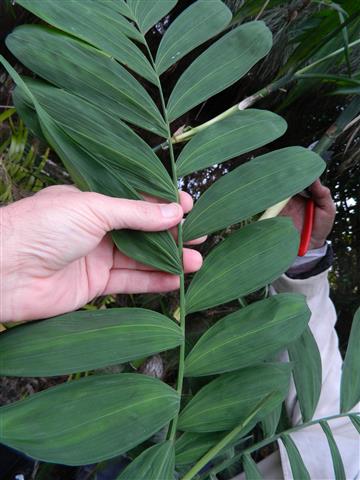
CHAMAEDOREA PLUMOSATHE BABY QUEEN PALM TOLERATES COASTAL FULL SUN
| Locality of Origin: Southeast Mexico Type of Palm / Leaf Type: Pinnate Solitary/Suckering: Solitary. Note that often sold as multiples, so people think it suckers. It does not. It’s a single trunk palm. Plant Height Mature: 14 feet Comments on Trunk: Trunk is green in filtered light. It has prominent rings and is about 3/4 to 1 inch thick. Sun Requirements: Filtered light or coastal sun Cold Tolerance: To lower 20’s F. Being grown in the SF Bay area Speed of Growth: Fast Particular Characteristics: Narrow leaflets giving leaves a fluffy, green look. Usually planted as a multiple with three to five plants. Rarity: Rare General Description/Comments: This is a great plant for a narrow planter area along the side of the house. It’ll grow in filtered light or coastal sun. It does appreciate water. By the way, I have no excuse for this common name as this plant has nothing to do with nor does it look like a Queen Palm. |
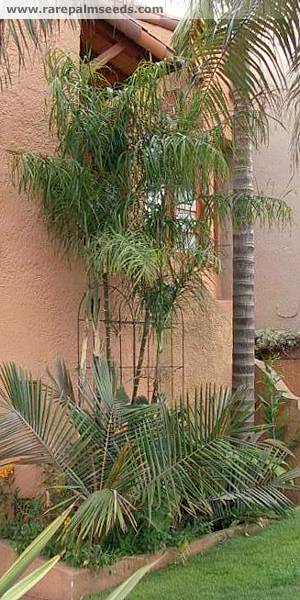
CHAMAEDOREA STOLINIFERA
THE STOLON PALM
SUCKERING DWARF UNDERSTORY SPECIES
| Locality of Origin: Chiapas, Mexico Type of Palm / Leaf Type: Simple bifid leaves Solitary/Suckering: Suckering by plants growing from stolons (stems shooting horizontally off the mother stem, rooting and then growing upwards) Plant Height Mature: 6 feet Comments on Trunk: Thin, about 3/8 of an inch, green with visible rings. Flower bracts are orange. Sun Requirements: Filtered light Cold Tolerance: To about 25 degrees F. Speed of Growth: Slow Particular Characteristics: This is an easy to grow understory palm. Over time you’ll get a nice colony of plants that are never overhead. Leaves are small and about about 8 inches long. Rarity: Very rare General Description/Comments: This species is highly recommended for an understory palm that is attractive, easy to propagate from individual stems and slowly gets bigger and fills an area. |
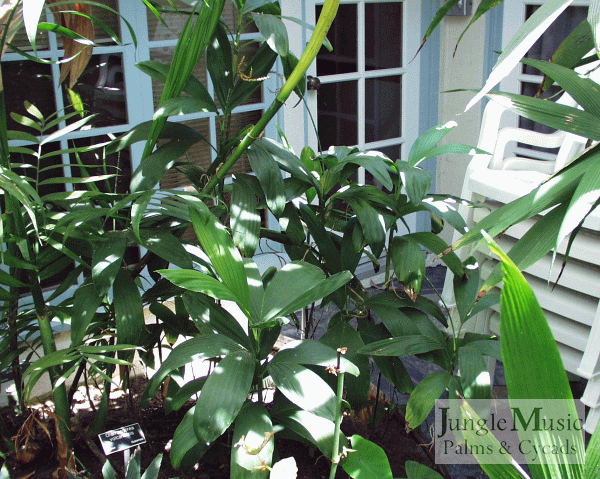
CHAMAEDOREA TENELLATHE ELFIN PALM
| Locality of Origin: Southeastern Mexico and Costa Rica Type of Palm / Leaf Type: Simple, undivided very small leaves Solitary/Suckering: Solitary Plant Height Mature: 12 inches Comments on Trunk: Super thin, pencil size Sun Requirements: Filtered light Cold Tolerance: Uncertain, probably upper 20’s F. Speed of Growth: Slow Particular Characteristics: This is a tiny single trunk plant (plantlet) for the garden floor. It’ll never get over your knees. Leaf color is green and leaves have very short stems. Rarity: Extremely rare, near impossible to find General Description/Comments: An amazingly small and attractive miniature palm. |
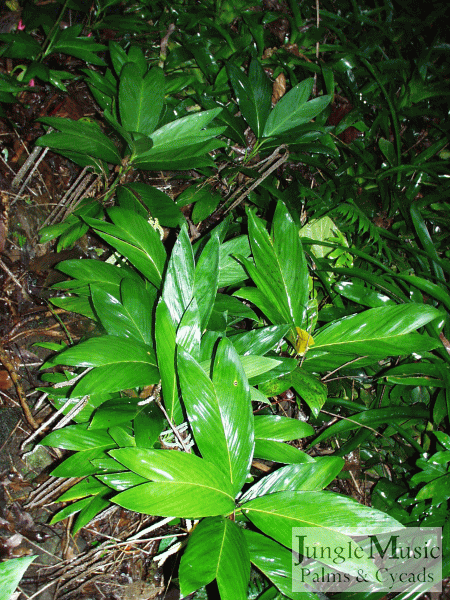
CHAMAEDOREA TEPEJILOTETHE PACAYA OR TEPEJILOTE PALM
| Locality of Origin: Southern Mexico, Central America and northern Columbia Type of Palm / Leaf Type: Pinnate Solitary/Suckering: Solitary although there is a rare suckering form (never available) Plant Height Mature: 15 feet – can get taller in tropical areas Comments on Trunk: Thick trunk, typically 1.5 inches but can be larger Sun Requirements: Filtered light. In our area this species does not tolerate direct sun. So, if your plant pierces the canopy, it’ll probably burn. Cold Tolerance: Estimated to be mid-twenties F. Speed of Growth: Medium to fast Particular Characteristics: This species has green leaves with wide leaflets. Leaf length is four to five feet. Because it gets tall and is single trunk, I’d recommend planting a small colony. It looks better. Trunks are green with nice rings and orange flower bracts. Rarity: Fairly rare General Description/Comments: This is a quick growing and satisfying understory palm that has nice color and a gorgeous trunk. If you get three or four plants, the female of the group will probably set seeds spontaneously. Seeds are fairly large for a Chamaedorea and black in color. Photo c/o Palmpedia, unknown author. This palm is highly recommended. |
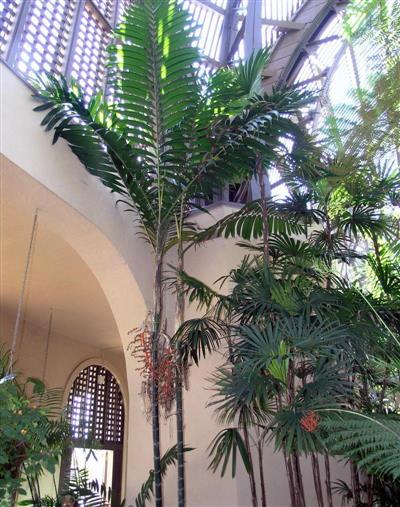
CHAMAEDOREA PALMS
OTHER SPECIES
There are over 200 species of these delightful Chamaedorea. To the right is another rare one, Chamaedorea fragrans. Unfortunately, we just can’t show all the species here. But, we have a more comprehensive article on Chamaedoea species that shows you a lot more. To see more
FOLLOW THIS LINK: CHAMAEDOREA SPECIES

CHAMAEROPS HUMILIS
THE MEDITERRANEAN FAN PALM
| Locality of Origin: Mediterranean coastal areas Type of Palm / Leaf Type: Fan palm Solitary/Suckering: Suckering Plant Height Mature: 10 – 15 feet typically. But, there are short clones and rarely taller. Comments on Trunk: usually 8 to 12 inches thick, rough with old leaf bases and fiber Sun Requirements: Full hot sun Cold Tolerance: To about 15 degrees F. Speed of Growth: Slow Particular Characteristics: Fairly common suckering fan palm that usually has green or blue green leaves with prominent spines on the stems. Mature heights are variable and can be up to twenty feet. Rarity: Common General Description/Comments: This common fan palm is not hard to spot in most communities where it’ll grow. It’s durable, cold hardy and takes the hottest of sun. When properly trimmed and clean, it can be attractive. |
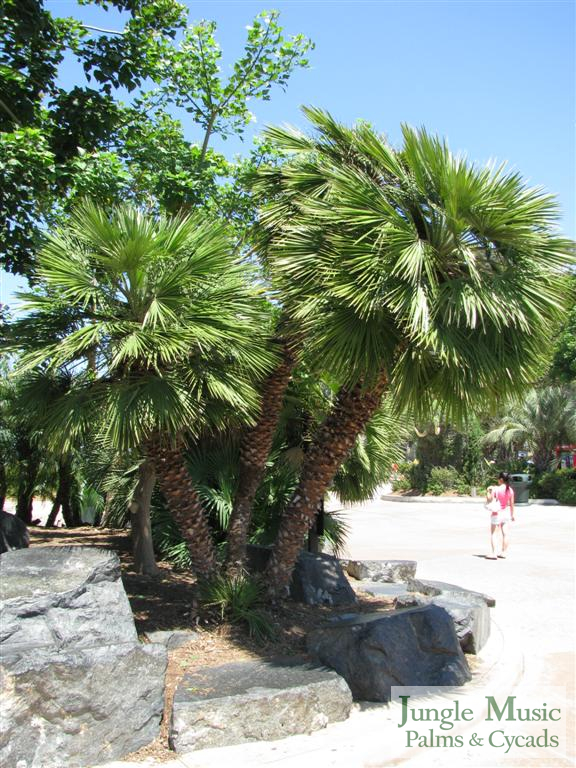
CHAMAEROPS CERIFERA
AKA CHAMAEROPS CERIFERA VAR. ARGENTEAMOROCCAN BLUE FAN PALM
ATLAS MOUNTAIN PALM
| Locality of Origin: Northern Africa Type of Palm / Leaf Type: Fan Palm Solitary/Suckering: Suckering species Plant Height Mature: 8 to 12 feet Comments on Trunk: Fibrous and rough with retained leaf bases Sun Requirements: Full sun Cold Tolerance: To estimated 15 degrees F. or possibly lower Speed of Growth: Slow to medium growth rate Particular Characteristics: This palm is similar to the regular C. humilis but it is very blue and tends to be smaller with smaller crowns of leaves. Leaf stems are armed. Rarity: Somewhat rare General Description/Comments: I Taxonomists are working on a name for this species. I figure soon it’ll have a new name. This is a smaller, blue fan palm (compared to regular humilis) that will take your hottest sun and heat. It also is super cold hardy. photo c/o TS at RPS |
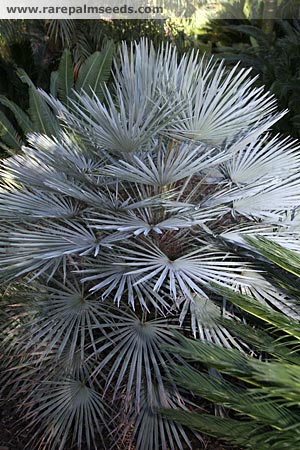
CHAMBEYRONIA MACROCARPA
THE FLAME THROWER PALM
NEW LEAVES EMERGE RED!
| Locality of Origin: New Caledonia Type of Palm / Leaf Type: Pinnate Solitary/Suckering: Solitary Plant Height Mature: 20 to 30 feet Comments on Trunk: 10 to 12 inches, rings evident Sun Requirements: Filtered light or morning sun inland, on the coast part day sun or full sun Cold Tolerance: 23-24 degrees F. Speed of Growth: Slow to medium Particular Characteristics: The most spectacular thing about this great species is the red newly emerging leaf. See the photos to the right. This last for several weeks. Leaves are dark green, 8 to 10 feet long and the leaflets are very thick to the touch. This plant really responds to adequate water. Rarity: Very rare General Description/Comments: Simply put this is a great and “must have” species. If grown right, it’s not slow but steadily gets a thicker trunk and height. This is one of those “drop dead beautiful” palms. First photo by TS at RPS. Second by BGL . This palm is highly recommended. Read more about Chambeyronia |
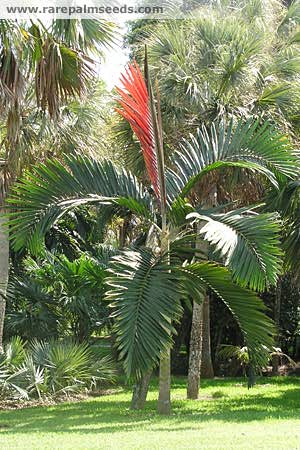

CHAMBEYRONNIA HOOKERI
THE BLOND FLAME THROWER PALM
| Locality of Origin: New Caledonia Type of Palm / Leaf Type: Pinnate Solitary/Suckering: Solitary Plant Height Mature: 20 to 30 feet Comments on Trunk: 10 to 12 inches thick Sun Requirements: Part day sun most areas but filtered light far inland Cold Tolerance: To about 22 to 23 degrees F. Speed of Growth: Slow Particular Characteristics: The main difference between this species and the macrocarpa above is the crown shaft color. All other morphological aspects are similar. But, this species is slower growing, seems to have a more intense red on the new leaves and doesn’t do as well in full coastal sun. Rarity: Very rare General Description/Comments: This species or variety of Chambeyronia is super beautiful and quite the show stopper. Most enthusiast covet this palm in their garden. Although not easily obtainable, it’s well worth the effort to get one. |
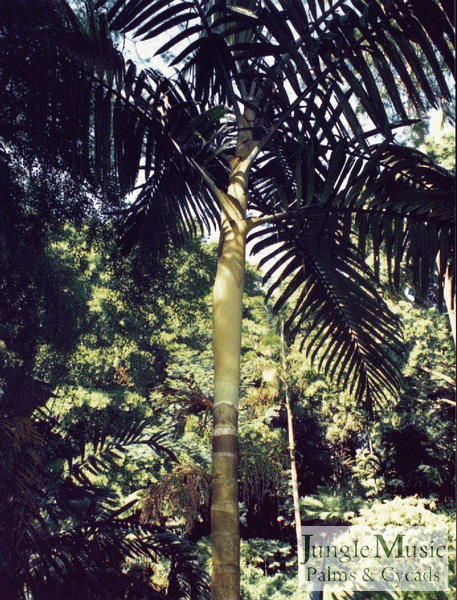
CLINOSTIGMA SAVORYANUM
PACIFIC BEAUTY PALM
STUNNINGLY BEAUTIFUL
| Locality of Origin: Bonin Islands Type of Palm / Leaf Type: Pinnate Solitary/Suckering: Solitary Plant Height Mature: 30 to 40 feet, taller in tropical areas Comments on Trunk: Clean medium sized trunk with visible rings in filtered light. Crown shaft is green and many times a silver green. Sun Requirements: Full sun. One could begin it in partial sun and let it pierce the canopy into full sun over time. Cold Tolerance: To about a freeze Speed of Growth: Moderate Particular Characteristics: Enthusiast were excited because it was found that this tropical looking palm actually does well in So California. Leaves are green, leaflets droop downwards, and the crown shaft can show a beautiful silver color. Rarity: Very rare General Description/Comments: This is simply put a gorgeous palm for the garden and stunning when well grown. Availability is always the issue. Photo c/o Palmpedia, unknown author |
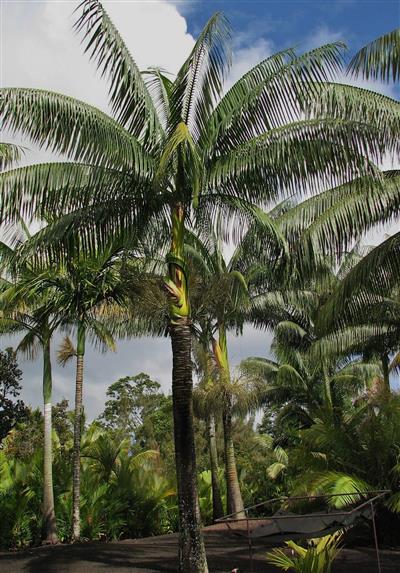
COCCOTHRINAX ARGENTATA
THE FLORIDA SILVER PALM
| Locality of Origin: Southeastern Florida, the Florida Keys, some Caribbean Islands and Columbia Type of Palm / Leaf Type: Fan palm Solitary/Suckering: Solitary Plant Height Mature: 15 – 20 feet Comments on Trunk: Tan colored with woven matting at the top. This falls off over time to give a brown woody trunk that is about 4 to 8 inches thick. Sun Requirements: Full sun Cold Tolerance: Can tolerate down into the upper twenties F. Speed of Growth: Slow Particular Characteristics: This is an attractive medium sized palm that has three foot wide leaves that are green on the top and silver underneath as shown in the photo. The trunk has an interesting woven texture toward the top. Rarity: Very rare – difficult to find General Description/Comments: This is perfect sun where a medium sized full sun palm is needed. It doesn’t get very tall. The silver undersides flash when sunlight hits them. It wants heat, sun and not to get too cold. |

COCCOTHRINAX BARBADENSIS
GREEN FAN PALM WITH NEAR CIRCULAR LEAVES
| Locality of Origin: Lesser Antilles and Trinidad and Tobago Type of Palm / Leaf Type: Fan Palm Solitary/Suckering: Solitary Plant Height Mature: 30 to 40 feet Comments on Trunk: Thin trunk for height, 6 inches average in diameter. Fibrous matting on trunk. Ages to a woody trunk. Sun Requirements: Full sun – not for the shade Cold Tolerance: To upper 20’s F. Speed of Growth: Slow at first – faster in the ground Particular Characteristics: This species has circular leaves about 4 feet across. They are green on both sides, make almost a full circle and the segments are divided 2/3 of the way toward the center. Rarity: Moderately rare General Description/Comments: This is a somewhat taller Coccothrinax that is green in color. It wants sun and heat. But, it won’t take hard freezes in the winter. |
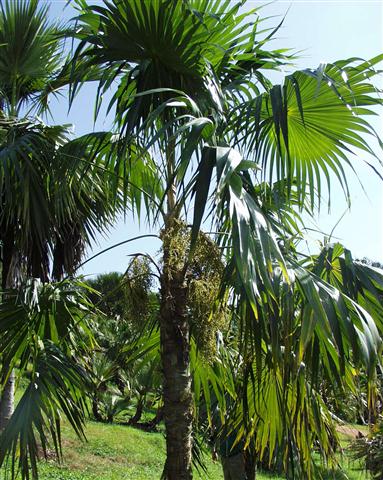
COCCOTHRINAX CRINITA
THE OLD MAN PALM
LONG SHAGGY FIBROUS HAIRS ON TRUNK
| Locality of Origin: Cuba Type of Palm / Leaf Type: Fan palm Solitary/Suckering: Solitary Plant Height Mature: Variable, from six feet to almost 20 feet Comments on Trunk: Covered with long, shaggy brown hairs that look like a long beard. Trunks are 4 to 6 inches thick but, because of the fibers, appear to be thicker. The second photo shows the true trunk diameter of this species. Sun Requirements: Full sun Cold Tolerance: Tolerant of cold down to the upper 20’s F. Speed of Growth: Slow Particular Characteristics: When people see the hairy trunk, they find it very intriguing and even reminds them of their grandpa. There is a variety (C. crinita var. brevicrinis) which has shorter hairs on the trunk. But, the true Old Many Palm looks just like an old man’s beard. Leaves are green. The second photo shows where the fibers have fallen off and you see the trunk, clean trunk. Rarity: Very rare General Description/Comments: The Old Man Palm is a great palm for the garden. It’s not too tall and takes all the sun and heat you have. But, like with other Coccothrinax, you can’t get too cold in winter. |
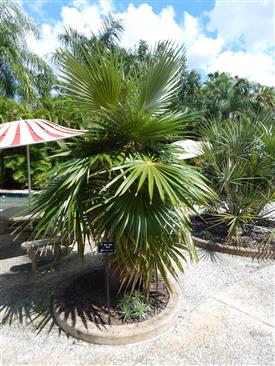
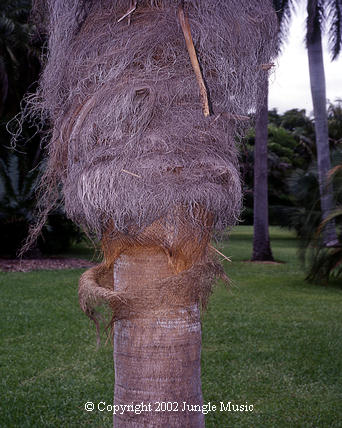
COCCOTHRINAX MIRAGUAMA
THE MIRAGUAMA PALM
NICE WOVEN FIBERS ON TRUNK
| Locality of Origin: Cuba Type of Palm / Leaf Type: Fan palm Solitary/Suckering: Solitary Plant Height Mature: 30 feet Comments on Trunk: The trunk (bare) is 4 to 6 inches thick. The upper trunk is covered with an organized and patterned fibrous coating. This ages over time to reveal a gray to tan colored more narrow trunk. See second photo. Note the swirls of fibers around the trunk with remaining stubs of old leaf stems. Sun Requirements: Full sun Cold Tolerance: Down to the upper 20’s F. Speed of Growth: Slow to Medium Particular Characteristics: Leaves of this species are almost a full circle. Leaflets are divided almost all the way to the center. Leaflets are stiff and the central leaf has a yellowish color. These leaves are very attractive when viewed. Rarity: Very rare General Description/Comments: This is great and interesting palm for full sun. It does get well overhead but you can see the leaves overhead with their silver undersides. The weaving (second photo) is very interesting to look at and touch. It actually has a thick and rugged texture when to feel it. This is a nice plant to try. |
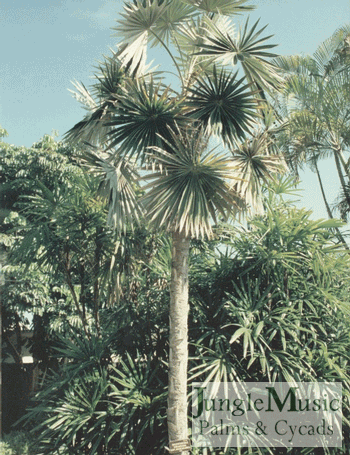
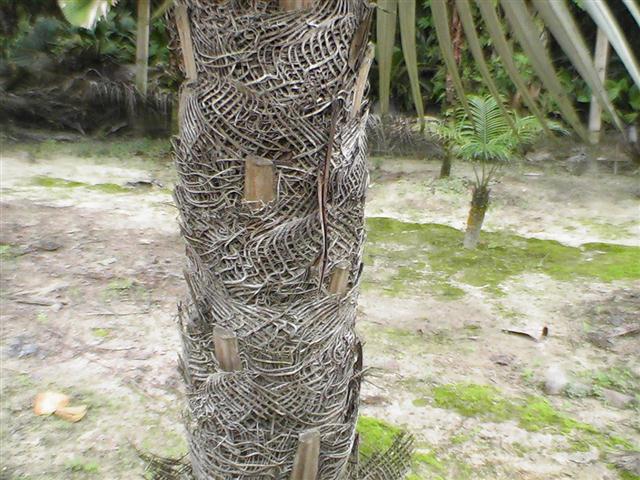
OTHER COCCOTHRINAX SPECIES
VERY APPEALING GENUS OF FAN PALMS
MANY MORE SPECIES EXIST
All Coccothrinax are New World species found from Florida south through all areas into northern South America. All are fan palms and most are medium size mature. But, there are a few that approach fifty feet. Overall, more than 50 species have been described.
A friend of mine for 40 years, Paul Craft, is an expert on Coccothrinax, especially those from Cuba. There are even some newly described species. In Paul’s new Encyclopedia of Cultivated Palms he has some great photos of super rare and unusual species. Also, he just published a book The Palms of Cuba.
The plant shown to the right is Coccothrinax proctorii.
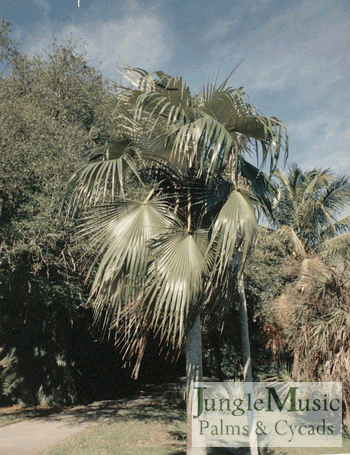
COPERNICIA ALBA
MOST COLD HARDY COPERNICIA
| Locality of Origin: Argentina, Brazil, Paraguay and Bolivia Type of Palm / Leaf Type: Fan palm Solitary/Suckering: Solitary Plant Height Mature: 30 feet with reports of taller trees in habitat Comments on Trunk: Thin, gray, smooth over time. Diameter about 10 inches Sun Requirements: Full sun Cold Tolerance: Tolerates temperatures down to the mid to lower 20’s F. Speed of Growth: Moderate Particular Characteristics: Has a crown consisting of a full circle of silver-green leaves. Forms a petticoat of old leaves below the crown but these usually fall off. Old leave base remnants can remain on the trunk in some areas. Rarity: Moderately rare General Description/Comments: This is a tall silver-green fan palm with a different look, thin trunk and circular crown of leaves. It is also quite cold hardy and easy to grow. |
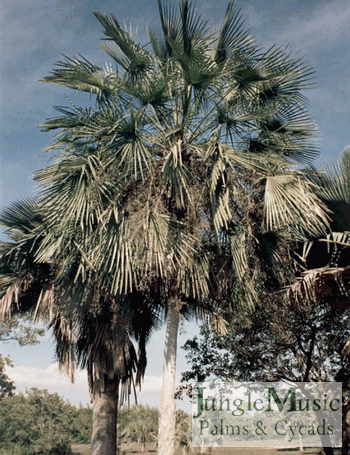
COPERNICIA BAILEYANA
BAILEY FAN PALM
| Locality of Origin: Cuba Type of Palm / Leaf Type: Fan palm Solitary/Suckering: Solitary Plant Height Mature: 30 feet Comments on Trunk: Thick, smooth, light gray to tan, columnar, 18 to 24 inches. Look like concrete freeway pillar. Sun Requirements: Full hot sun Cold Tolerance: Surprisingly cold hardy – to mid-twenties F. Many in our area are growing it without a problem Speed of Growth: Very slow, especially when juvenile Particular Characteristics: This is a super attractive fan palm with a large, fat light colored trunk and crown of near totally circular green to blue green leaves. The leaves and flat, minimally divided and the crown holds a large number of leaves. The leaf stems are armed and very white in color. Rarity: Very rare General Description/Comments: C. baileyana is a treat to have in the garden. It is different looking, large, different and a real statement plant. As it’s very slow growing, one must struggle through the first ten years. It takes this long to form some trunk. The second photo here shows a juvenile local tree with it’s impressive white petioles. Even at this stage it’s very attractive and satisfying to the grower. |
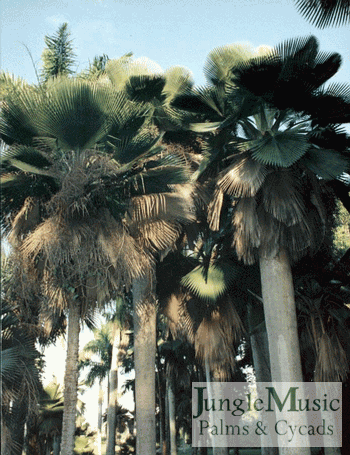
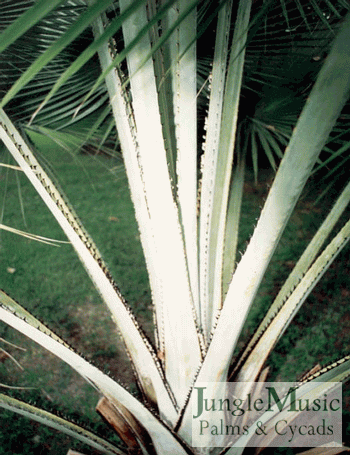
COPERNICIA MACROGLOSSA
THE PETTICOAT PALM
| Locality of Origin: Cuba Type of Palm / Leaf Type: Fan palm Solitary/Suckering: Solitary Plant Height Mature: 30 feet, often shorter because slow growing Comments on Trunk: Thin trunk with a skirt of old dead leaves below the crown. Diameter about 8 inches. Sun Requirements: Full sun Cold Tolerance: To just below a freeze Speed of Growth: Slow Particular Characteristics: Although not as cold hardy as C. baileyana, it is totally different looking with a small trunk and less mature height. Leaves are circular, green and have almost non-existent leaf stems giving it a tight crown with flat leaves. Rarity: Very rare General Description/Comments: This is an attractive fan palm with a thin trunk. It looks better when the petticoat of dead leaves is removed. This shows off the attractive leaves and makes it more appealing in appearance. |
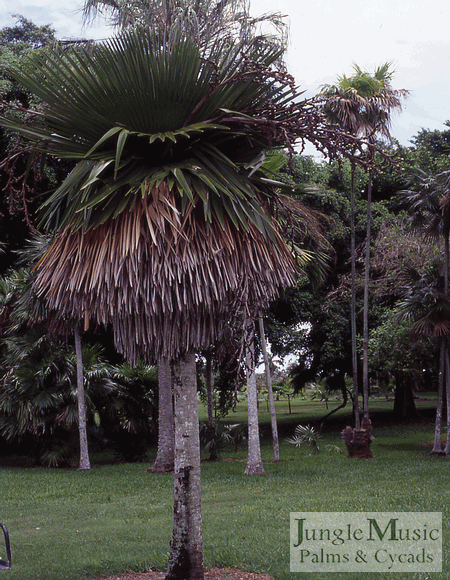
COPERNICIA, OTHER SPECIES
OVER TWO DOZEN DIFFERENT SPECIES
Copernicia is a genus of fan palms, many on the small to medium size, with interesting flat, circular leaves and a circular crown of leaves. There are 27 species native to Cuba, the Lesser Antilles, possibly Central America and South America. Some are cold sensitive but many can be grown in Southern California. Most are slow growing. All are quite different appear. Below is a list of some of the recommended species that you might want to investigate on your own. There are quite a few more than shown below. It’s just not practical to show all species here. To the right I’m first showing a Copernicia ekmannii that is not yet mature but has nice blue leaves. The second species is another blue one that is quite the popular and sought after species, Copernicia fallaense.
Copernicia berteroana
CoperniciacowelliiCoperniciaekmanniiCoperniciafallaensis Copernicia gigas
Copernicia hospitaCopernicia pruniferaCopernicia yaray
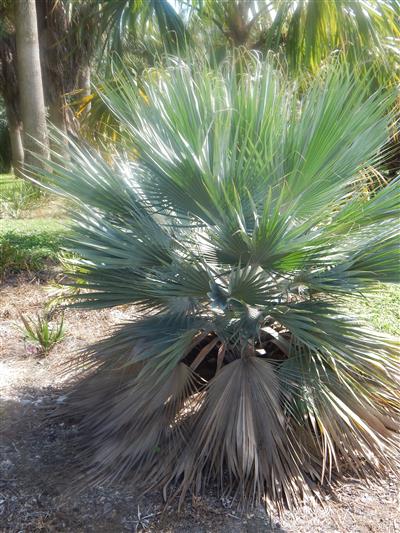
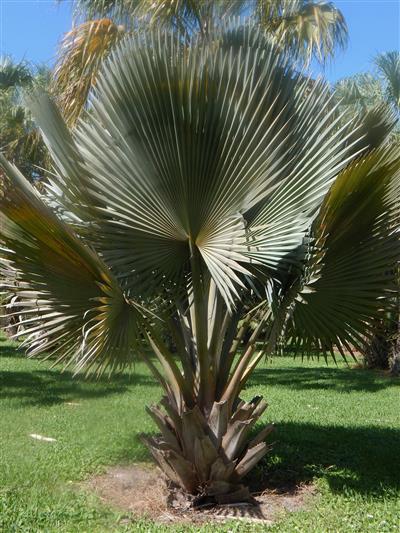
CYPHOPHOENIX ELEGANS – THE ELEGANT PALM
| Locality of Origin: New Caledonia Type of Palm / Leaf Type: Pinnate Solitary/Suckering: Solitary Plant Height Mature: 20 to 25 feet Comments on Trunk: Thin trunk with green crown shaft. There may be some white to blue-green color in the mid and upper trunk Sun Requirements: Full sun possible right on the coast. Or, part day sun. Inland areas should consider strong filtered light. Cold Tolerance: Very good for a New Caledonian palm. Can take down to about 25 degrees F. Speed of Growth: Slow Particular Characteristics: Nice full set of green arching leaves. Leaf length six feet or a bit more. Oppose this to the stiff, upright leaves of C. nucele. Bare leaf stems are short. Rarity: Very rare General Description/Comments: This is a great palm for Southern CA gardens and highly recommended. It, like all New Caledonian species, prefers lots of water to look its best. It is very attractive with a smaller crown of leaves.. Note how arching these leaves are. |
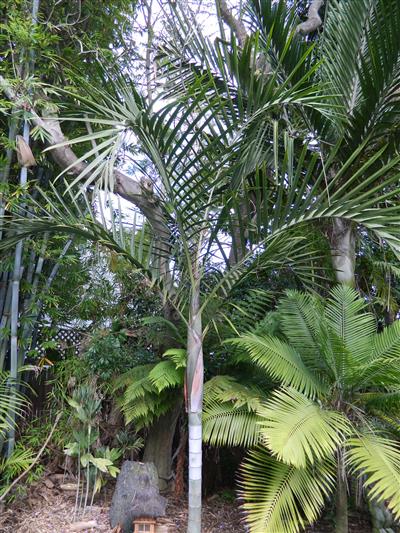
CYPHOPHOENIX NUCELE
NEW CALEDONIAN PALM WITH UPRIGHT LEAVES
| Locality of Origin: New Caledonia, Loyalty Islands Type of Palm / Leaf Type: Pinnate Solitary/Suckering: Solitary Plant Height Mature: About 20 feet or a bit more. In habitat, plants are taller. Comments on Trunk: Thin, green with rings, diameter 6 to 8 inches Sun Requirements: Part day sun or perhaps full sun right near the ocean. Inland areas should give filtered light or a bit of sun. Cold Tolerance: To about 30 degrees F. Speed of Growth: Moderate Particular Characteristics: Nice crown of very upright green leaves. Leaves are flat in cross section and the leaf stem is a short 2 feet. Crown shaft is often near white. This species likes adequate water. Rarity: Extremely rare General Description/Comments: This is fairly quick growing palm that is super tropical appearing and being grown by many in Southern California. Its leaves are very upright as opposed to the arching leaves of C. elegans. This species is also highly recommended. |
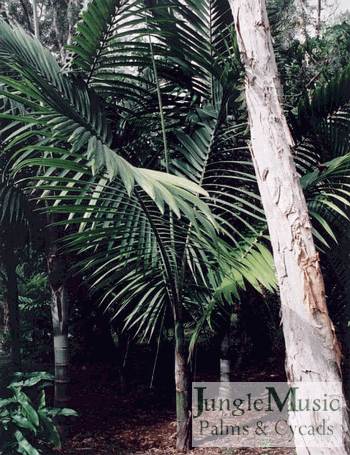
DICTYOSPERMA ALBUM
HURRICANE PALM, PRINCESS PALM
| Locality of Origin: Mascarene, Reunion and Mauritius Islands Type of Palm / Leaf Type: Pinnate Solitary/Suckering: Solitary Plant Height Mature: 30 feet Comments on Trunk: About 6 to 8 inches Sun Requirements: Full sun along the coast. If cold permits, part day sun inland. Cold Tolerance: Estimated at just below a freeze, perhaps to 28-30 degrees F. Speed of Growth: Moderate Particular Characteristics: Medium sized palm with arching green leaves. Crown shaft can have some white color. Juvenile plants may show red in the leaves. Rarity: Fairly rare General Description/Comments: This genus has been described as monotypic with only one species. Taxonomists are still working on this. This species can be grown here and is attractive and not overly large. Oppose this to the species below. |
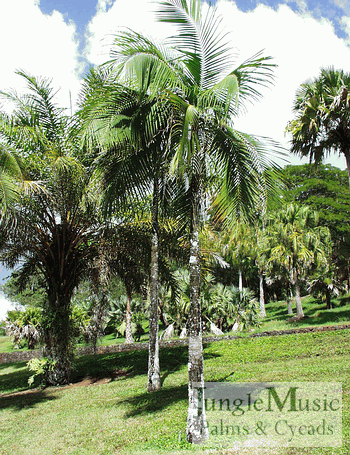
DICTYOSPERMA FURFURACEUM NEW NAME – DICTYOSPERMA CONJUGATUM
SHORTER SPECIES WITH WHITE CROWN SHAFT
| Locality of Origin: Only on Round Island, Indian Ocean Type of Palm / Leaf Type: Pinnate Solitary/Suckering: Solitary Plant Height Mature: 15 feet or less Comments on Trunk: Medium thickness, about 6 to 8 inches, with a somewhat bulging snow white crown shaft. It is super attractive. Sun Requirements: Full sun on the coast – inland areas less sun Cold Tolerance: Uncertain, but perhaps slightly below a freeze Speed of Growth: Slow to medium Particular Characteristics: Green to gray-green leaves with droopy leaflets and a white crown shaft. This is the shortest variety of this genus. Rarity: Extremely rare, expensive General Description/Comments: This is the shortest variety of this monotypic species. It’s surprising that it doesn’t have species status as it’s totally different. If you can find one, it’s well worth the expense to get it. It’ll be one of the most unusual plants in your garden. Photo by Tim Rann |
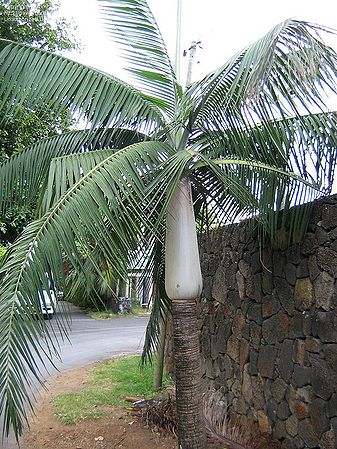
DYPSIS AMBOSITRAE
MADAGASCAR PALM – SINGLE TRUNK OR SUCKERING
| Locality of Origin: Madagascar Type of Palm / Leaf Type: Pinnate Solitary/Suckering: Variable, sometimes single trunk, other forms suckering Plant Height Mature: 15 – 20 feet Comments on Trunk: Thin trunks that are green to silver green in color. Crown shaft can be white and powdery. Trunk thickness 4 to 6 inches. When it suckers, there are a minimal number of trunks – perhaps 2 to 3. Sun Requirements: Full or part sun along the coast. Inland areas less sun. Cold Tolerance: To about 27 degrees. The plant shown here is locally grown and saw low 20’s in 2007. Speed of Growth: Slow to moderate Particular Characteristics: Great new species from Madagascar. Super attractive with arching leaves and nice trunk and crown shaft color. And, it’s not overly large. Leaves are green and deeply keeled. Rarity: Very rare General Description/Comments: This is a spectacular new species to try and fairly cold hardy. Sometimes you’ll see red color in the leaf stems. Note the leaves are keeled and arching. This palm is highly recommended. |
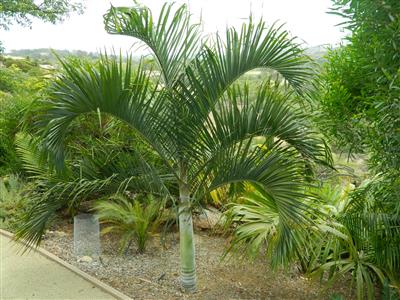
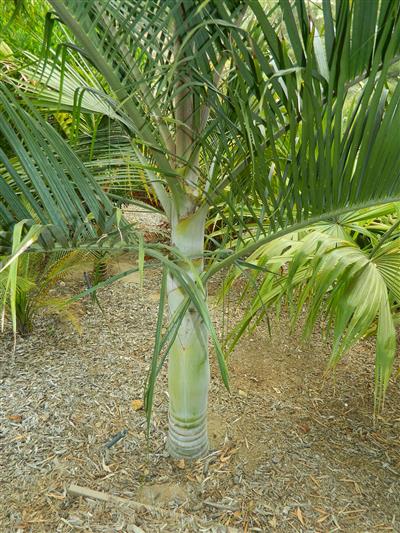
DYPSIS BARONII
SUGAR CAN PALMSUCKERING NEW MADAGASCAR PALM
| Locality of Origin: Madagascar Type of Palm / Leaf Type: Suckering pinnate palm – rarely single trunk. Like all Dypsis, there is variation among specis. Solitary/Suckering: Suckering – rarely single trunk Plant Height Mature: 15 – 20 feet Comments on Trunk: Thin with prominent rings, 3 to 4 inches thick and white or green crown shafts. Single trunk plants tend to have thicker trunks. Sun Requirements: Part day sun or filtered light along the coast. Inland areas filtered light. This is not a good palm for full sun. Cold Tolerance: About 26 to 28 degrees F. Speed of Growth: Slow Particular Characteristics: This is a variable species with green leaves, ringed trunk and some silver to the crown shaft. Leaves are keeled. Rarity: Rare, hard to find in larger sizes General Description/Comments: This is a variable appearing species. When young, one may see a variety of colors in the inner crown and leaf stem. As time ages, this may disappear. It is a smaller caned palm that gets some height but doesn’t take up too much room on the ground. Recommended. |
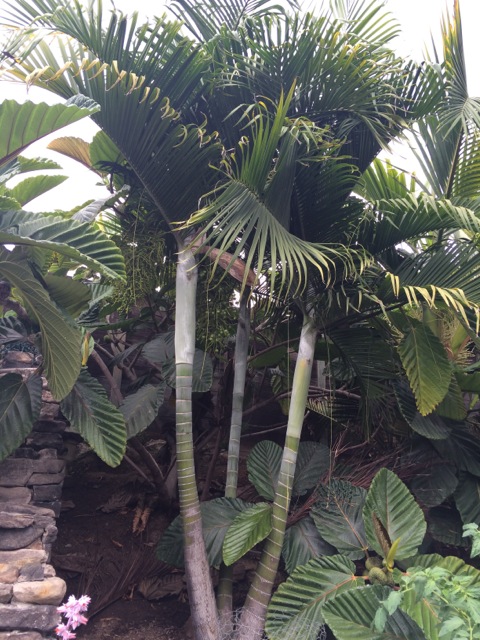
DYPSIS CABADAE
THE CABADAE PALM
| Locality of Origin: Comoros, but exact origin uncertain Type of Palm / Leaf Type: Pinnate Solitary/Suckering: Suckering Plant Height Mature: 15 – 20 feet Comments on Trunk: Thin, 4 inches or more, but typically thicker than D. baronii above Sun Requirements: Full or part day sun. Inland areas less. Cold Tolerance: To about a freeze – 32 degrees. Speed of Growth: Slow to moderate Particular Characteristics: Medium sized overall, green keeled leaves, green ringed trunks, green to silver-green crown shaft. Rarity: Very rare General Description/Comments: This is somewhat cold sensitive species species that can be grown in better microclimates throughout the coastal strip. When successful, attractive and medium sized. |
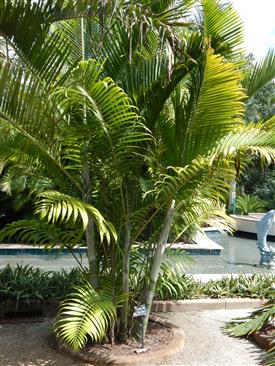
DYPSIS DECARYI
THE TRIANGLE PALM
| Locality of Origin: Madagascar Type of Palm / Leaf Type: Pinnate Solitary/Suckering: Solitary Plant Height Mature: 20 feet or somewhat taller Comments on Trunk: Thickness about 12 inches with variable color in a triangular crown shaft. The latte contains purple, gray and brown colors with speckling. The shape of the crown shaft gives this palm its common name. Sun Requirements: Full sun most areas Cold Tolerance: To 25 degrees. Colder will burn and 22 degrees F. will kill it. Speed of Growth: Medium Particular Characteristics: Keeled gray-green leaves that are 8 to 10 feet long. The crown shaft is quite wide and three sided. This is a very unusual appearing palm. Rarity: Rare General Description/Comments: This is a popular palm that has been around for over 30 years. It’s a medium sized species with a fairly wide crown of leaves. Most people are marveled by the shape and color of the crown shaft. Loves full hot sun! Highly recommended |
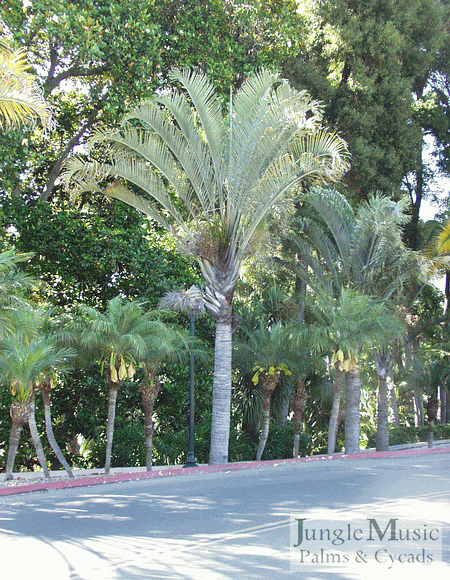
DYPSIS DECIPIENS
THE MANAMBE PALM
STRIKINGLY DIFFERENT
| Locality of Origin: Madagascar Type of Palm / Leaf Type: Pinnate Solitary/Suckering: Usually single trunk but can sucker – like many Dypsis Plant Height Mature: 30 to 35 feet Comments on Trunk: The trunk is one of the most interesting things about this species. It is cigar shaped, with the central portion of a mature palm often thicker than the base. The crown shaft is variable in color from white to green and is often smaller than the mid-trunk. White example shown in second photo. Thickness of the maximal trunk diameter can be up to 24 inches. Sun Requirements: Full sun except when juvenile Cold Tolerance: To about 18 degrees F. For this reason, it’s growing up in Northern California and is very sought after there. Speed of Growth: Extremely, unbearably slow Particular Characteristics: This species is variable and there are forms with white crown shafts. Also, leaf color is variable from green to blue green. Also, some leaves are flat, others keeled and some almost plumose in appearance. As mentioned, Dypsis are very variable in their appearance. Rarity: Very rare and impossible to find with size because of the slow growth rate General Description/Comments: This is a coveted, revered and sought after species by palm enthusiasts. Even in the ground it is an extremely slow growing species. But, it’s worth the wait. To get 10 feet of trunk may take 10 to 20 years. It’s recommended to protect this species from gophers and provide it with full coastal sun when it’s large enough (15 gallon or larger). Also, acclimate acquired nursery plants to your sun slowly. Highly recommended. |
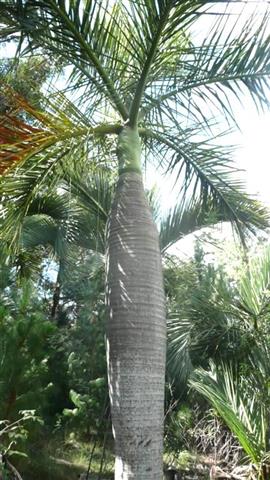
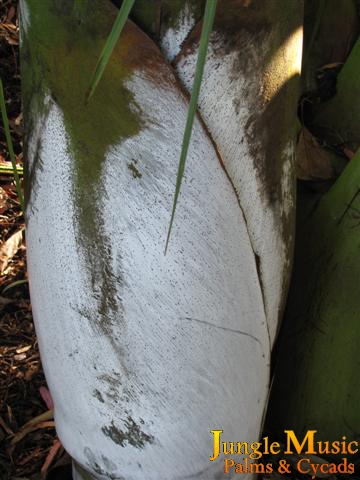
DYPSIS LANCEOLATA
BEAUTIFUL SUCKERING MADAGASCAR PALM
| Locality of Origin: Comoro Islands Type of Palm / Leaf Type: Pinnate Solitary/Suckering: Almost always clustering. Remember, Dypsis are variable. Plant Height Mature: 15 feet Comments on Trunk: Thin trunks 3 to 4 inches thick. Crown shaft often white or green-silver. Crown shaft elongated and smooth. Sun Requirements: Filtered light. This species may burn in full sun. If you must try sun, only give it a little morning sun. Cold Tolerance: To a freeze or a bit loer Speed of Growth: Slow to medium Particular Characteristics: This species has wide leaflets and arching leaves. Leaf color is green and leaves are keeled. It looks similar to D. pembana but more diminutive in size. Rarity: Very rare General Description/Comments: This is a sought after species and loved by almost all enthusiasts. The only mistake you can make with it is to try to grow it in full sun. Reports from customers is that it has trouble with too much sun. Highly recommended |
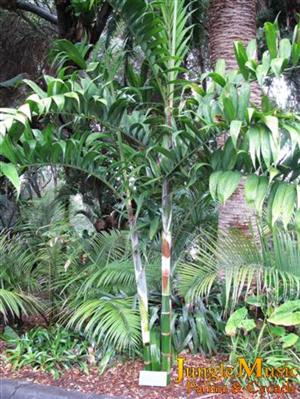
DYPSIS LEPTOCHEILOS
THE TEDDY BEAR PALM
RUSTY BROWN, FURRY CROWN SHAFT
| Locality of Origin: Madagascar Type of Palm / Leaf Type: Pinnate Solitary/Suckering: Solitary Plant Height Mature: 20 – 25 feet typically Comments on Trunk: Trunk diameter is from 8 to 12 inches, prominently ringed, often silver in color with a rusty brown furry crown shaft below the leaves. Because of the latter it’s called the Teddy Bear Palm. Sun Requirements: Full or part sun along the coast – less sun inland. Cold Tolerance: To 28, possibly 26 degrees F. Speed of Growth: Average – moderate Particular Characteristics: Leaves are green, flat in cross section and have short petioles. The leaflets continue close to the stem. The most notable thing is the crown shaft. Rarity: Very rare General Description/Comments: This is a sought after and immediately liked species. It’s medium sized and very different. Note how the trunk on both specimens shown is silver-white with the different crown shaft. Highly recommended. |
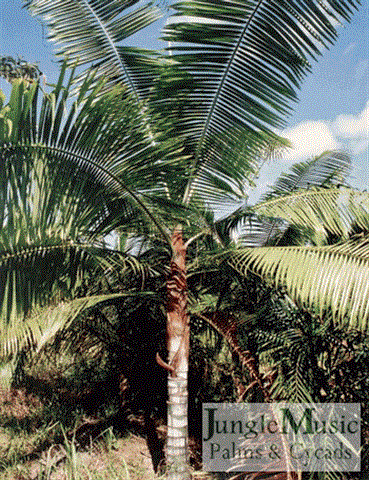
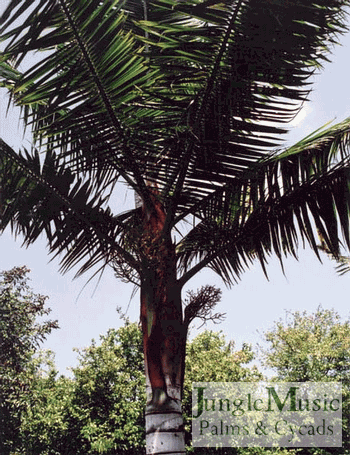
DYPSIS LUTESCENS
THE ARECA OR BUTTERFLY PALM
SUCKERING MEDIUM SIZED PALM
| Locality of Origin: Madagascar, Comoros and Reunion Island. There is some argument about the true origin of this species. Type of Palm / Leaf Type: Pinnate Solitary/Suckering: Clustering Plant Height Mature: 15 – 20 feet, taller in the tropics Comments on Trunk: Thin, 2 to 3 inches, green, silver or sometimes shades of yellow, ringed, slick Sun Requirements: Full sun along the coast – part sun or filtered light far inland Cold Tolerance: To mid twenties F. Speed of Growth: Average once planted Particular Characteristics: Narrow trunks of various colors, crown shafted, medium mature height. Leaves are keeled, green, sometimes with a hint of silver. Clumps in our area usually have four to six stems, not super full. But, the latter can occur, especially in the tropics. One thing about this species is you have to like yellow – it has quite a bit of this color on the leaf-stems and upper trunk. Rarity: Minimally rare General Description/Comments: This is a super popular species an often used as a neighbor blocking palm. It’s perfect for such a usage. Also, the ground footprint is not too large and overall height is only to 20 feet or less. Because it’s such a great biological barrier for privacy, it is highly recommended. |
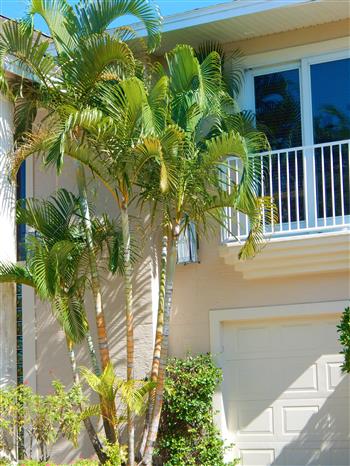
DYPSIS ONILAHENSIS
GREAT PALM SPECIES FROM MADAGASCAR
| Locality of Origin: Madagascar Type of Palm / Leaf Type: Pinnate Solitary/Suckering: Clustering – rarely solitary Plant Height Mature: 15 – 25 feet mature Comments on Trunk: Thin trunks on clustering form. Thickness 4 to 6 inches with white or silver-green grown shaft. Prominent rings and nice trunk color. Sun Requirements: Full or part day sun on coast. Far inland less sun. Cold Tolerance: To about 25 to 26 degrees Speed of Growth: Slow to medium Particular Characteristics: There is a lot of diversity in this species. Some are solitary but most cluster. Some have flat leaves whereas others droop downwards. Most have a gently arching leaf. Leaf color is always green. Rarity: Ve General Description/Comments: There is a lot of excitement about this species because it possesses more cold tolerance and takes full sun on the coast. It is also super attractive and highly recommended. Highly recommended. |
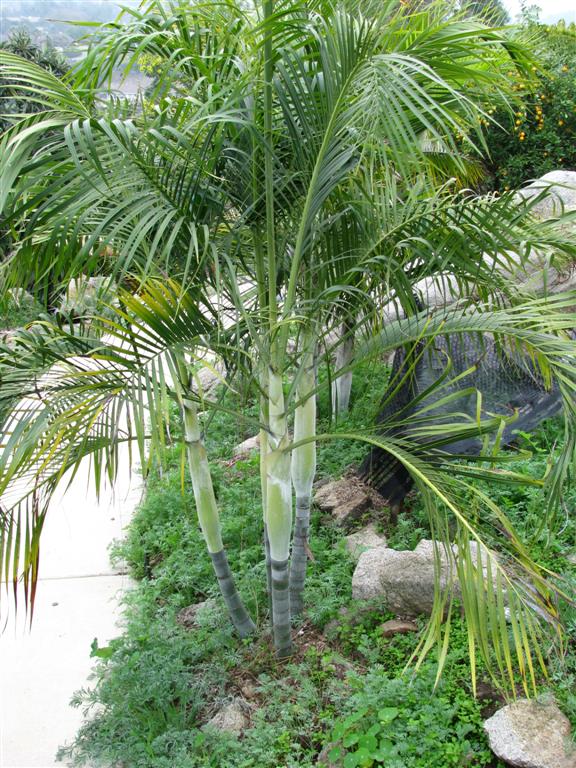
DYPSIS PEMBANA
THE PEMBA PALM
SINGLE TRUNK OR SUCKERING – TAKES SOME SUN
| Locality of Origin: Pemba Island, 40 miles east of Tanzania, Africa – In Indian Ocean Type of Palm / Leaf Type: Pinnate Solitary/Suckering: Single trunk and suckering forms Plant Height Mature: 20 to 25 feet Comments on Trunk: Trunk thickness about 4 inches, maybe a bit more. Single trunk forms are thicker. Trunk color silver-green with prominent rings, same color with crown shaft. The base of the trunks may widen somewhat. Sun Requirements: Sun or part day sun – less far inland Cold Tolerance: To upper twenties F. Speed of Growth: Slow to moderate Particular Characteristics: Leaves are green, keeled and upright. They do arch downwards and ends of leaflets may droop down. Crown shaft can be silver or white/powdery Rarity: Very rare General Description/Comments: This is one of our favorites and we highly recommend it. It’s more interesting than the Areca palm with thicker, more powerful trunks and nicer color. Some people don’t like the yellow of the Dypsis lutescens and this palm has no yellow (see last species). Highly recommended. |
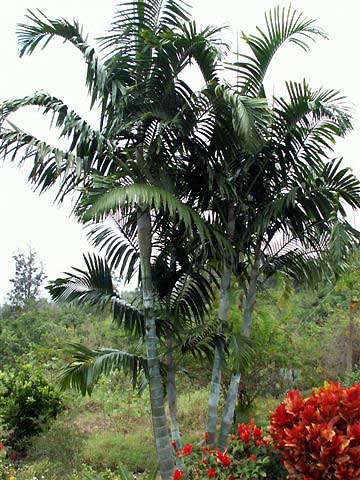
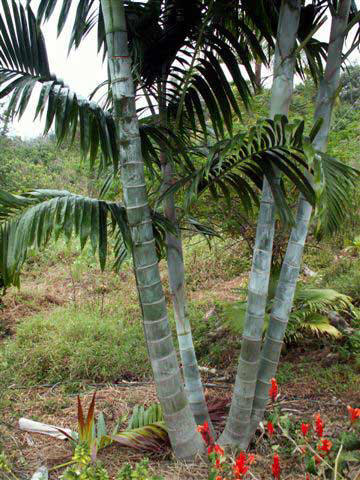
DYPSIS PRESTONIANA
DYPSIS “BIG CURLY” (BY LATE MARDI DARIAN)
LARGE SOLITARY MADAGASCAR PALM
| Locality of Origin: Madagascar Type of Palm / Leaf Type: Pinnate Solitary/Suckering: Solitary Plant Height Mature: 40 feet Comments on Trunk: Trunk 12 inches thick, silver-green in color with prominent rings, colorful crown shaft that is orange to silver-green Sun Requirements: Full sun along the coast Cold Tolerance: To 28 to 30 degrees Speed of Growth: Fastest Dypsis species Particular Characteristics: Fluffy and plumose leaves that are long and arch downwards. Leaflets may be ranked in different planes or grouped together. Rarity: Very rare General Description/Comments: This is one the up and coming favorite Dypsis grown by enthusiasts. My suspicion is that some day we’ll see a lot more of them. This species is highly recommended. First photo c/o TS RPS and second by BGL |
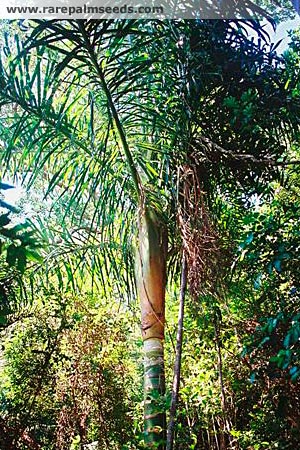
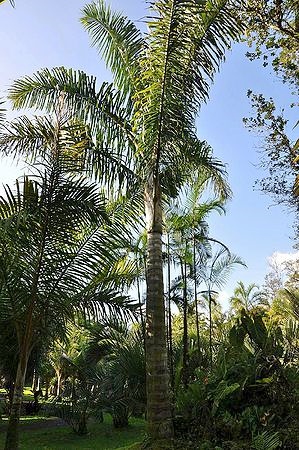
DYPSIS, OTHER SPECIES
WAY TOO MANY SPECIES TO SHOW HERE
Dypsis is one of the largest genera of palms in the world. There are at least 170 species known and described. Most of them are attractive and interesting. Some are very small, others quite large. All of them are interesting if you like palms. I am not going to list them here, but if you seek to learn more about these, I would refer you to Paul Craft’s Encyclopedia of Cultivate Palms or other references. Or, you can search through the Internet for more information. Photo to the right is Dypsis albofarinosa by AL
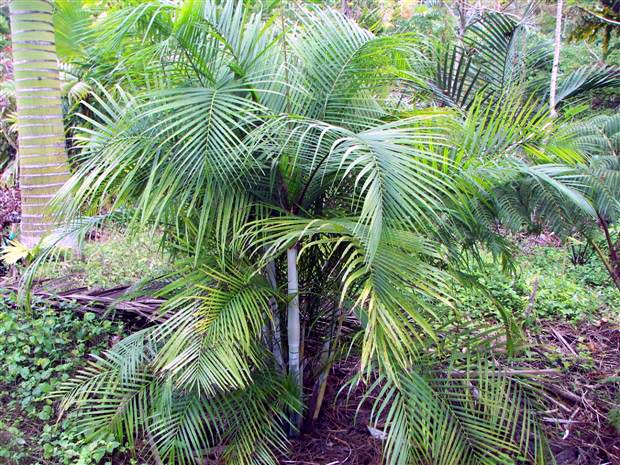
EUTERPE EDULIS
THE ASSAI PALM
THIN TRUNK, CLEAN GREEN CROWN SHAFT
| Locality of Origin: South America including Brazil and Argentina Type of Palm / Leaf Type: Pinnate Solitary/Suckering: Solitary Plant Height Mature: 25 feet or more Comments on Trunk: Thin trunk about 4 inches in diameter with elongated crown shaft that is usually green. Sun Requirements: Filter light when younger and work into/grow into coastal sun. Cold Tolerance: Down to about a freeze or a bit lower. Speed of Growth: Moderate Particular Characteristics: Narrow trunk, green leaves, leaflets somewhat drooping and long attractive crown shaft. Rarity: Moderately rare General Description/Comments: This is an attractive thin trunk with a crown of leaves that is not overwhelming. This is the only species of Euterpe that can be grown in our locality. Since I’ve been involved with palms, I’ve found this to be true. I’ve had several grow to heights of over 25 feet in San Diego and produce tons of purple fruits that germinated. Taxonomists want to lump this species together with Euterpe oleracea which won’t grow here and looks totally different as a seedling or young plant. |
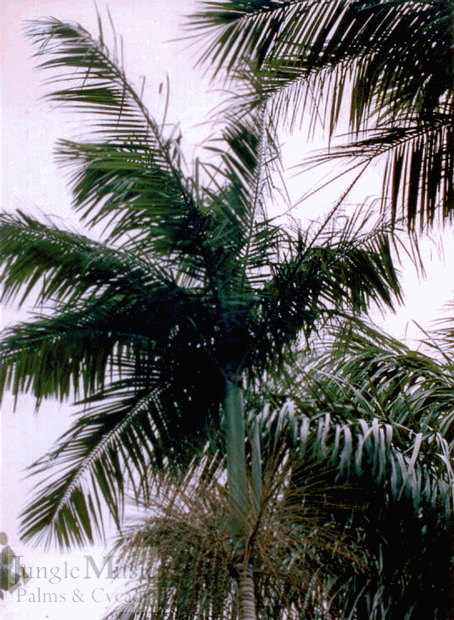
GAUSSIA MAYA
FORMALLY OPSIANDRA MAYA
THIN PALM WITH SMALL CROWN OF LEAVES
| Locality of Origin: Mexico and Central America Type of Palm / Leaf Type: Pinnate Solitary/Suckering: Solitary Plant Height Mature: Variable – from 15 to 50 feet tall Comments on Trunk: Thin, about 6 inches Sun Requirements: Full or part day sun on the coast – less far inland Cold Tolerance: To about a freeze Speed of Growth: Fairly fast growing Particular Characteristics: Thin trunk with smaller crown of somewhat plumose leaves. As a juvenile plant one may see prominent bulging of the trunk. This disappears with age. I’ve also found that this species “reaches” for the light if grown in shade. Thus, you’ll get the curve to the trunk as shown here. Rarity: Moderately rare General Description/Comments: If you live in a warmer area, this is a fun species to try. I’d give it about half day sun or even full sun. The crown of leaves doesn’t take up a lot of room. |
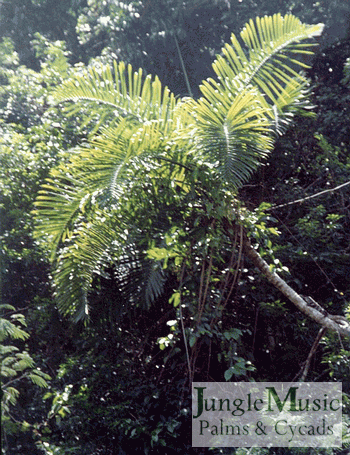
HEDYSCEPE CANTERBURYANA
THE UMBRELLA PALM
GORGEOUS MEDIUM SIZED PALM
| Locality of Origin: Lord Howe Island Type of Palm / Leaf Type: Pinnate Solitary/Suckering: Solitary Plant Height Mature: 25 feet Comments on Trunk: About 6 to 8 inches thick, silver green in shade with a white crown shaft. It almost looks like powder on the trunk. The photo to the right is of a plant in my garden. Sun Requirements: Full or part day sun. In shade they seem to stall. Inland areas would used a few hours sun or strong filtered light. Cold Tolerance: To about 25 degrees F. Speed of Growth: Very slow Particular Characteristics: Leaves are green and curved downward, thus the common name. Overall size is medium. This species makes large red fruits when mature. Rarity: Very rare General Description/Comments: This is a great palm. It take coastal sun, is absolutely gorgeous appearing, has a beautiful trunk and doesn’t get overly large. The only downside is that it’s so slow. Sometimes one can die for no reason. For this reason we tell people to plant three in different areas. One should grow well. This species is highly recommended. |
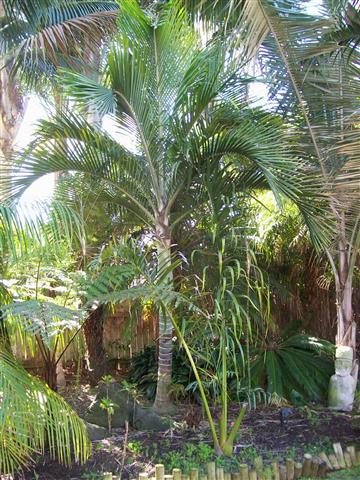
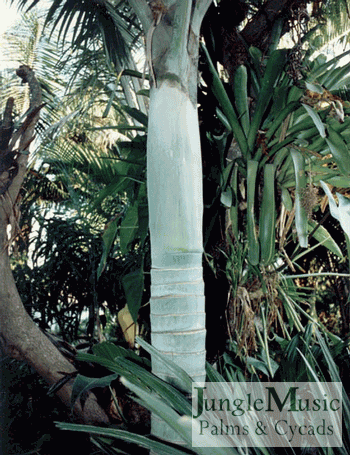
HOWEA BELMOREANA
THE BELMORE PALM
CANOPY UMBRELLA SHAPED
| Locality of Origin: Lord Howe Island Type of Palm / Leaf Type: Pinnate Solitary/Suckering: Solitary Plant Height Mature: 15 Comments on Trunk: Smooth trunk but no crown shaft. Diameter 6 to 8 inches Sun Requirements: Full or part sun, inland les sun Cold Tolerance: To about 25 degrees F. or maybe a bit lower. Speed of Growth: Slow to medium – slower than H. forsteriana Particular Characteristics: If you look at the photo, you can definitely see the umbrella shape to the very arching leaves. Leaves are green with a fairly long bare petiole. Leaflets don’t droop as much as the Kentia Palm. Flowers hang below the seeds and will make seeds that ripen to red. Overall canopy size medium. Rarity: Moderately rare General Description/Comments: This is a recommended species and is being grown by many, both domestically and in hotels and businesses. A hotel in Santa Barbara has many fruiting trees close to the ocean. Be aware that growth rate is slower than with the regular Kentia. |

HOWEA FORSTERIANA
THE KENTIA PALM
GREAT IN THE GARDEN, PATIO OR INDOORS
| Locality of Origin: Lord Howe Island Type of Palm / Leaf Type: Pinnate Solitary/Suckering: Solitary – but often grown and purchased as a “multiple” with two to five plants in one pot. Note: single plants grow faster in pots and in the ground. Plant Height Mature: 35 to 40 years Comments on Trunk: Somewhat thin, 6 to 8 inches. Much thinner than a King or Queen Palm. It has no crown shaft Sun Requirements: Full or part sun along the cost. Far inland, a few hours sun or filtered light. Cold Tolerance: To about 25 degrees F. Speed of Growth: Slow to medium growth rate. We normally tell people that a carrying size plant will be 30 feet tall in 30 years in the sun. Particular Characteristics: Leaves are green and the trunk is smooth. Leaves are not very arched. In sun, leaflets droop downwards. This species is dark green in shade and a more lime green in hot sun. Old leaves need to be manually removed unless you want to wait. They’ll eventually fall off. Rarity: A little rare General Description/Comments: This palm is super popular and often used inside the home or office. It’s a favorite house plant. But, in the garden for most people, it does develop and make a magnificent specimen. Highly recommended. Read more about Howea forsteriana |
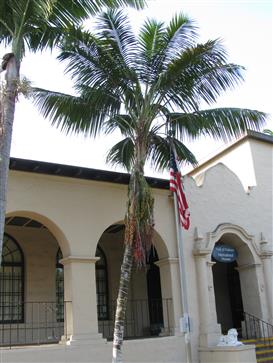
HYOPHORBE INDICA
MEDIUM SIZED – RARE SUN LOVING PALM
| Locality of Origin: Reunion Island Type of Palm / Leaf Type: Pinnate Solitary/Suckering: Solitary Plant Height Mature: 15 Comments on Trunk: Smaller, about 6 inches thick. Green smooth crown shaft Sun Requirements: Full sun – languishes in shade. Inland areas part sun Cold Tolerance: To about 27 degrees. Is more cold hardy than other types of Hyophorobes. Speed of Growth: Average Particular Characteristics: Note in the photo the very arching green leaves, the thinner trunk and the overall medium size. Also, leaves are keeled with leaflets pointed upwards. If you give it sun and don’t get too cold, it’s a great palm for the garden. Rarity: Very rare General Description/Comments: Recommended species for a sunny spot in a smaller garden where space is limited. It’s smaller than the Christmas Palm and has a similar look. Remember, it’s much easier to grow than a Spindle or Bottle Palm. The latter almost always dies outside in our area. Photo c/o Pinterest, unknown author. |
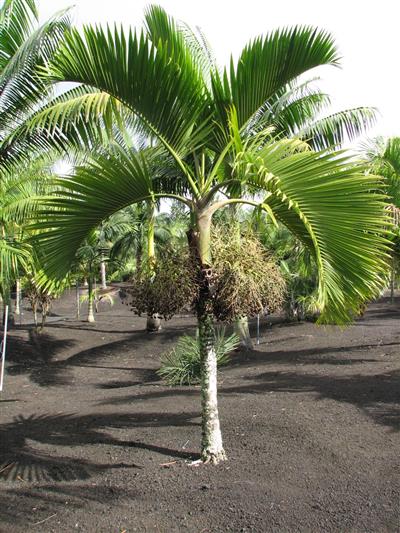
HYOPHORBE LAGENICAULIS
THE BOTTLE PALM
| Locality of Origin: Round and Mauritius Islands Type of Palm / Leaf Type: Pinnate – feather palm Solitary/Suckering: Solitary Plant Height Mature: 15 Comments on Trunk: This species has an amazing trunk. It expands at the ground level and is the thickest at the bottom. As you look further up the trunk it progressively gets more thin. Basal trunk diameters can be over two to three feet wide. Height mature ten feet. Sun Requirements: Full sun. Doesn’t do well in shade. Cold Tolerance: This species doesn’t tolerate a freeze at all. In fact, it does poorly with temperatures in the mid-thirties F. There are very few specimens of this species in Southern CA. Yes, people buy one and plant it and say (3 months later) that it’s doing fine. But, over the long run most will die or look terrible. Speed of Growth: Slow to medium Particular Characteristics: The trunk is swollen at the base, the crown shaft is small, leaves are heavily keeled with leaflets going upwards and they never get much over ten feet tall. Rarity: Fairly rare General Description/Comments: This is not a species we recommend for Southern CA because of it’s inability to withstand any cold. They are very cool, but not the best choice for here or any colder area. The Spindle Palm or the Indica are much better choices. |
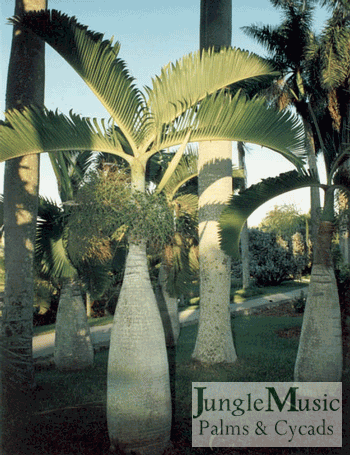
HYOPHORBE VERSCHAFELTII
THE SPINDLE PALM
THE BETTER CHOICE OVER THE BOTTLE PALM
| Locality of Origin: Mascarene Islands Type of Palm / Leaf Type: Pinnate Solitary/Suckering: Solitary Plant Height Mature: 15 – 20 feet in decades Comments on Trunk: The trunk of this species is swollen in the mid-portion, giving it a cigar shape. Oppose this to the Bottle Palm where the swelling is at the bottom of the trunk. Maximal trunk at the base is 12 to 14 inches and up the trunk 18 inches or more. Sometimes the crown shaft is wider than the trunk. Overall height is also taller than the Bottle Palm. Sun Requirements: Full sun. Does poorly in shaded conditions. Cold Tolerance: To about 27 or 28 degrees. We had one in Encinitas that survived 25 degrees F. Speed of Growth: Slow to medium Particular Characteristics: This sun loving palm has an interesting cigar shaped light trunk with a dark green crown shaft. Out of the base of the crown shaft on mature specimens you’ll see large horn-like flowers protruding upwards. This is shown in the first photo. Rarity: Very rare, hard to find General Description/Comments: This is a good choice to try in So California. It’s interesting, takes hot sun, doesn’t get too tall and is fun to grow. Winter is not its friend, but it usually survives whereas the Bottle Palm usually dies. The H. indica is cool but not nearly as interesting as this species. Highly recommended. |
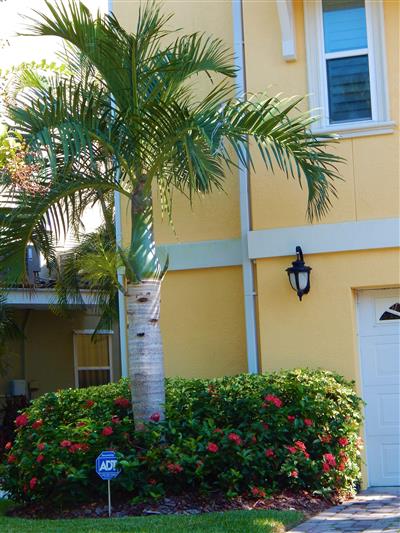
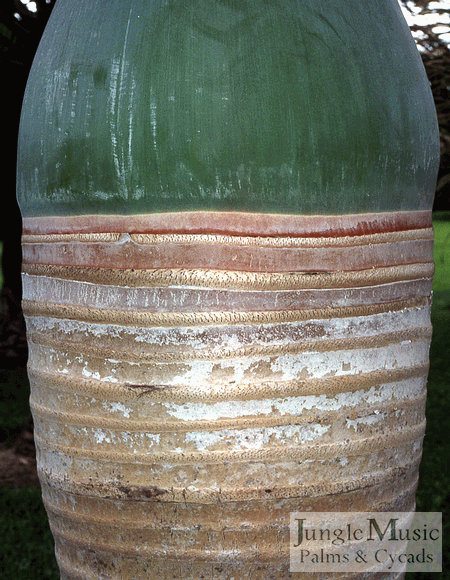
HYPHAENE SPECIES
THE BRANCHING PALMS
THE DOUM PALM, GINGERBREAD PALM AND OTHER TYPES
This is a group of branching fan palm trees from Africa that love sun and heat. It is an ideal palm for interior areas of Southern California that don’t get too cold. Colors of leaves vary from green to blue and the degree of branching varies as well. There are many growing in our locality. Cold tolerance is definitely into the mid-twenties F. They do not like the combination of cold and wet. All species want full sun in addition to heat. Also, they do not dig well from specimens in the ground.
From time to time we offer several species. I am not giving our usual presentation here as I’m discussing all species in general. Shown to the right is an example of a Hyphane palm. Note the branching above the ground on the main left trunk.
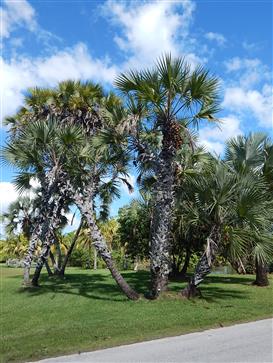
JUBAEA CHILENSIS
THE CHILEAN WINE PALM
A GREAT ALTERNATIVE TO THE CANARY PALM
| Locality of Origin: Central Chile Type of Palm / Leaf Type: Pinnate Solitary/Suckering: Solitary large palm Plant Height Mature: Up to 50 feet, maybe taller Comments on Trunk: The most intriguing thing about this species is the absolutely massive smooth trunk. It’s the “fattest” palm in the world. Measurements have shown specimens that are 4 feet in diameter. It’s nothing to find them with three feet thickness. Trunks are basically smooth. If you see a lot of retained leaf bases, it’s most likely a hybrid with Jubaea. Sun Requirements: Full sun required Cold Tolerance: To 16 degrees F. Speed of Growth: Extremely slow to put on trunk. They get “wider” before they get “taller”. Particular Characteristics: Besides the fat and very tall trunks, the leaves are typically green. Some will have a hint of blue or gray. The “Blue Jubaeas” are nothing like a prominent blue but have blue-green leaves. Leaves are about 10 feet long. Seeds are yellow and large. Rarity: Moderately rare General Description/Comments: This is great species where one has plenty of room for a statement plant. As it doesn’t form a petticoat and is immune to almost all maladies that Phoenix see, it is a better choice than a Canary Island Palm. Highly recommended if you’ve got the time. Read more about Jubaea chilensis |
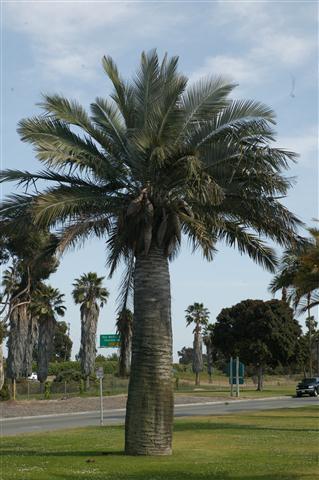
JUBAEA CHILENSIS X BUTIA CAPITATA
GREAT HYBRID PALM
SIMILAR TO JUBAEA BUT MUCH FASTER GROWING
| Locality of Origin: Hybrid, manmade or spontaneous hybridization Type of Palm / Leaf Type: Pinnate Solitary/Suckering: Solitary Plant Height Mature: 40 feet – Not as tall are pure Jubaea Comments on Trunk: Thick, almost as wide as a pure Jubaea. Estimated can reach 30 perhaps 36 inch diameter. But, not smooth surface. Retain old leaf bases as shown. Sun Requirements: Full sun mandatory Cold Tolerance: To perhaps 15 degrees or lower Speed of Growth: Faster than pure Jubaea which is super slow. As nursery plants they are at least 50% faster growing – or faster than that. I guess it’s “hybrid vigor”. Particular Characteristics: The crown of leaves is similar to a Jubaea – upright, green and long. The trunk has retained leaf bases. But it is faster growing and probably a bit more cold hardy. Rarity: Extremely rare, hard to find General Description/Comments: This is a great hybrid palm. It looks like a Jubaea but you can have a big palm in an estimated half the time. Highly recommended. |
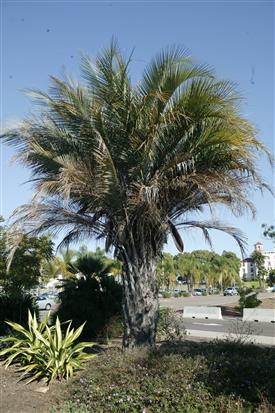
JUBAEOPSIS CAFFRA
THE PONDOLAND PALM
EXTREMELY RARE AND HARD TO FIND
| Locality of Origin: South Africa Type of Palm / Leaf Type: Pinnate Solitary/Suckering: Suckering, multiple trunks Plant Height Mature: 25 to 35 feet estimate Comments on Trunk: This slow growing palm starts with one trunk. Then it forms another as in photo #1 to the right. The second photo shows a very large specimen – probably the largest in Southern California. It grew for several decades in a private garden and was dug and moved to the Catamaran Hotel about 20 years ago. Trunks are fibrous and rough. Sun Requirements: Full sun Cold Tolerance: Uncertain, probably about 20 degrees F. Speed of Growth: Slow Particular Characteristics: People mention this species looks like a suckering Coconut Palm. It does have yellow in the stems but the trunks are not smooth at all. Also, the leaves are not as elegant as the Coconut. Leaf color is green and leaves are very long. Rarity: Very rare General Description/Comments: The only size you’ll ever see at a nursery is a small plant. And, you will seldom find one. So, you have to start small and wait. But, they slowly grow and someday you’ll have a big one. |
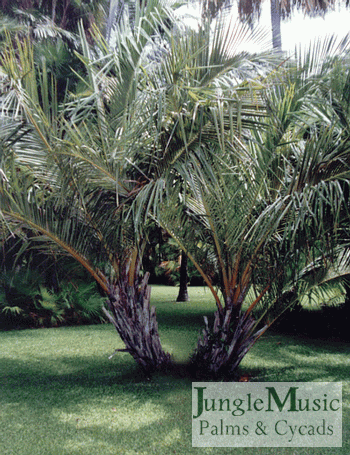
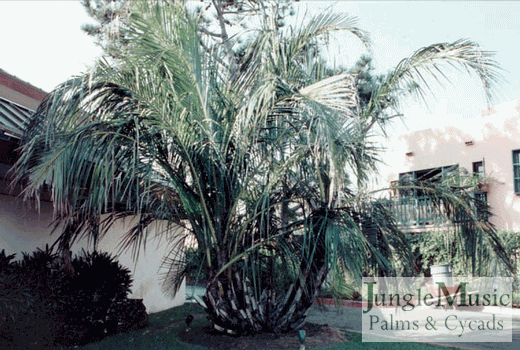
KENTIOPSIS OLIVIFORMIS
NEW CALEDONIAN PALM
A REAL WINNER FO SOUTHERN CALIFORNIA
| Locality of Origin: New Caledonia Type of Palm / Leaf Type: Pinnate Solitary/Suckering: Solitary Plant Height Mature: 30 feet Comments on Trunk: The trunk is about 10 inches thick, smooth with prominent rings and has a dark green crown shaft. Sun Requirements: Full or part day sun – less far inland Cold Tolerance: Can tolerate 25 degrees or less. o Speed of Growth: Average, not slow Particular Characteristics: This palm is just plain beautiful. It’s elegant and not overly large. The leaves are green and somewhat keeled. The trunk is fairly narrow. Leaves are upright. Overall, just a pretty palm. Highly recommended. Rarity: Very rare General Description/Comments: This is a great palm species for our area – as are many of the New Caledonian species. This species is hard to find but well worth the search. The first photo shows a plant growing not too far from our nursery. It routinely sees a freeze. |
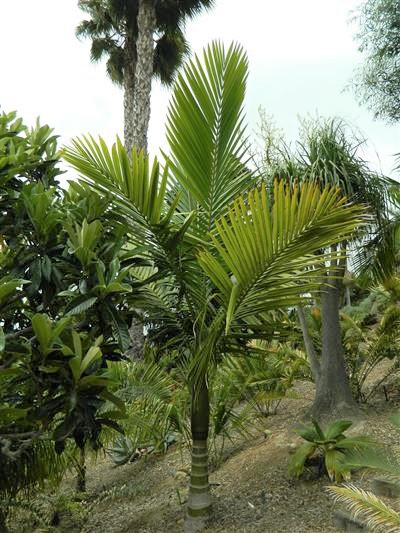
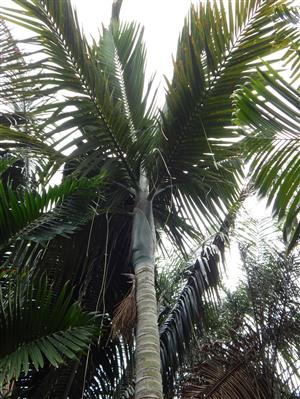
LACCOSPADIX AUSTRALASICA
THE ATHERTON PALM
A MONOTYPIC GENUS
| Locality of Origin: Queensland, Australia Type of Palm / Leaf Type: Pinnate Solitary/Suckering: Suckering Plant Height Mature: 15 feet or a bit taller Comments on Trunk: This species suckers and can have multiple trunks, each of which can get overhead in time. Note there are several varieties of this species – all variable on location. The mountain form is our recommended favorite. It grows better in our climate, suckers and doesn’t throw a new red leaf. But, it’s the best. Other varieties are a single trunk and a shorter, shiny leaf form that throws a new red leaf. The latter performs least well here. Sun Requirements: Full sun right on the coast or part sun – less sun inland Cold Tolerance: To about 26 degrees Speed of Growth: Average Particular Characteristics: Some people say this palm looks like a “suckering Kentia”. I actual agree it does, but this species is smaller. Trunks are about 4 inches, leaves six feet long and overall height is less. Leaves are green. Rarity: Very rare General Description/Comments: This is a great species for our locality. It’s rare to lose one. It does need a little ground room in the garden but isn’t overly tall and takes full coastal sun. |
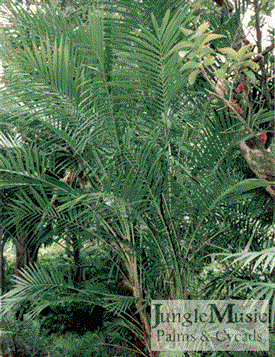
LINOSPADIX MONOSTACHYA
THE WALKING STICK PALM
SEMI-DWARF AND VERY CUTE
| Locality of Origin: New South Whales and Queensland, Australia Type of Palm / Leaf Type: Pinnate Solitary/Suckering: Solitary Plant Height Mature: 8 to 10 feet Comments on Trunk: Thin and fibrous. It’s about the size of a cane for walking. Sun Requirements: Filtered light Cold Tolerance: To the mid twenties F. Speed of Growth: Slow Particular Characteristics: This palm has short green leaves with short petioles. Leaves are a bit irregularly placed on the stem with irregular widths. The overall crown size is about five feet across. This is a very small, petite palm. Rarity: Very rare General Description/Comments: This is a cute species that can be used in the garden or patio. I have no experience inside the house. It likes filtered light. It is very hard to find and we have them available from time to time. |
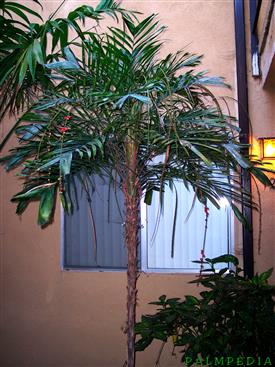
LICUALA ELEGANSLICUALA PELTATA VAR. SUMAWONGENSIS
A GORGEOUS TROPICAL FAN PALM
| Locality of Origin: Southern Thailand and Malaysia Type of Palm / Leaf Type: Palmate, Fan Palm Solitary/Suckering: Solitary Plant Height Mature: 10 to 15 feet mature Comments on Trunk: Trunks are narrow and fibrous. They support long petioles which attach to the circular leaves. Sun Requirements: Filtered light Cold Tolerance: To about a freeze. Many have grown this species in protected areas of So Cal. Speed of Growth: Slow Particular Characteristics: This palm has near circular, very flat green leaves attached to a long green leaf stem. The leaves are gently pleated and have minimal openings at the ends of their segments. Thus, it looks like a big flat circular leaf. They are very striking and beautiful. Rarity: Very rare General Description/Comments: This is a fantastic species to try in a protected area with filtered light. Highly recommended from a beauty point of view but there’s always a bit of cold risk. The photo was taken in Vista, CA. |
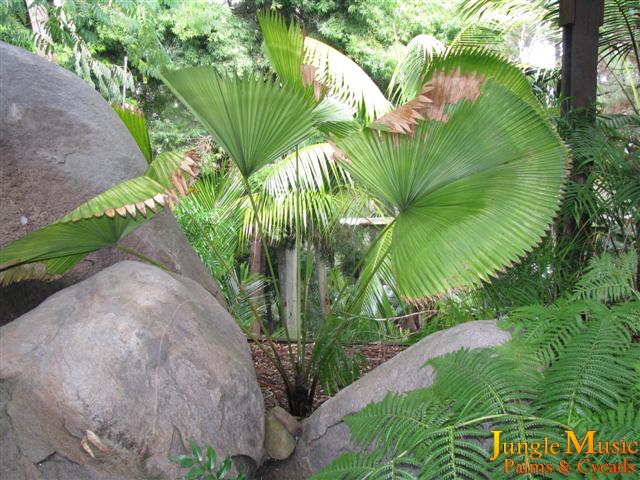
LICUALA RAMSAYI
AUSTRALIAN OR QUEENSLAND FAN PALM
| Locality of Origin: Queensland, Australia Type of Palm / Leaf Type: Palmate, Fan palm Solitary/Suckering: Solitary Plant Height Mature: 30 feet or taller in habitat – much shorter domestically. Comments on Trunk: Fibrous trunk Sun Requirements: Filtered light or some sun along the coast. Protect from direct sun inland Cold Tolerance: To perhaps a freeze Speed of Growth: Slow Particular Characteristics: If you are warm enough to grow this species along the coast, it is quite nice. We’ve found that plants in shade seem to stall. But, given a few hours of sun, they respond and grow. In habitat, the larger plants are in full sun. Leaves are green and large. They are circular with divided segments. Rarity: Very rare General Description/Comments: This is a somewhat challenging species to grow but it can be done. Unlike other Licuala, this species want some sun. |

LICUALA SPINOSA
MANGROVE FAN PALM
| Locality of Origin: Southeast Asia down to Indonesian Islands Type of Palm / Leaf Type: Palmate, fan palm Solitary/Suckering: Suckering Plant Height Mature: 10 to 15 feet Comments on Trunk: Thin and rough with fibers Sun Requirements: Filtered light Cold Tolerance: Lower 30’s F. Speed of Growth: Slow Particular Characteristics: Well grown, this suckering fan palm is attractive. The problem is, that because of it’s inability to tolerate cold weather, they sometimes look shabby. But, in the right location, it can be nice looking. Leaves are green, circular and divided. Leaf width is about two feet. Leaf stems are spiny. Rarity: Rare General Description/Comments: This is an attractive and tropical species that some can grow. I’ve known of quite a few nice specimens in our area. But, it needs a warm and protected location. |
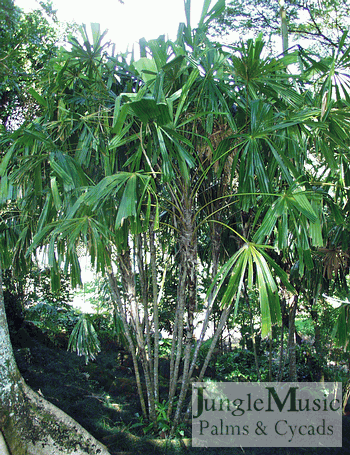
LIVISTONA AUSTRALIS
THE CABBAGE TREE PALM
| Locality of Origin: Australia Type of Palm / Leaf Type: Fan palm Solitary/Suckering: Solitary Plant Height Mature: Over 50 feet in habitat Comments on Trunk: Thin for height, about 12 inches. Clean but a bit rough to the touch Sun Requirements: Full sun Cold Tolerance: To about the mid-twenties F. or a bit lower Speed of Growth: Eedium Particular Characteristics: Leaves are circular but not a complete circle. Segments are divided and leaf color is green. Leaf stems are armed. Rarity: Rare General Description/Comments: This is a fairly easy species to grow and wants full sun. It is similar to Livistona decora which is more commonly seen. It likes sun and heat. Photo by John Dowe |

LIVISTONA CHINENSIS
CHINESE FAN PALM, THE FOUNTAIN PALM
| Locality of Origin: China, Japan, Taiwan and other localities Type of Palm / Leaf Type: Palmate, fan palm Solitary/Suckering: Solitary Plant Height Mature: 20 to 30 feet in many decades Comments on Trunk: Thickness 12 inches, smooth below any old attached leaves. This species is very slow to put on trunk height. Sun Requirements: Full or part sun. In deserts less sun Cold Tolerance: To a low of 18 degrees, most likely lower Speed of Growth: Extremely slow Particular Characteristics: Leaves are green, droopy at the ends and leaf stems are armed. Leaf segments are divided and leaves are glossy. Old leaves can remain after turning brown. Rarity: Minimally rare General Description/Comments: This fan palm is fairly common to see. It takes full coastal sun but can be used in part sun or strong filtered light. It is slow growing and very cold hardy. |
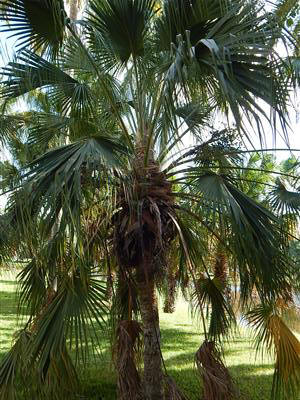
LIVISTONA DECIPIENS
NEWER NAME LIVISTONA DECORA
THE RIBBON FAN PALM
| Locality of Origin: Northeastern Australia Type of Palm / Leaf Type: Palmate, fan palm Solitary/Suckering: Solitary Plant Height Mature: 50 or more feet – takes many decades to achieve heights more than 40 feet Comments on Trunk: Thin trunk for height. Is smooth with some attached dead leaves below crown. Sun Requirements: Full sun Cold Tolerance: Tolerates temperatures into the upper teens. Low about 18 degrees F. Speed of Growth: Moderate Particular Characteristics: For fan palms, this species is attractive because it has very thin leaf segments. These remind one of “ribbon”, especially when they hang down from the leaf edges. Therefore, the leaves are very droopy as shown. Rarity: Rare General Description/Comments: This is a durable and attractive palm for full sun both along the coast and in hotter desert areas. It’s also a good growing palm. Although the trunk is thin, the crown width is about 15 feet wide. Of the Livistona, this species is highly recommended. |

LIVISTONA NITIDA
THE CARNAVON GORGE PALM
VERY TALL, THIN TRUNK
| Locality of Origin: Queensland, Australia Type of Palm / Leaf Type: Palmate leaf, fan palm Solitary/Suckering: Solitary Plant Height Mature: Over time will grow to more than 80 feet Comments on Trunk: Thin, smooth Sun Requirements: Full sun Cold Tolerance: Possibly will tolerate upper teens but for sure will take low 20’s F. It has been reported to come back from a blanket of snow on the leaves. Speed of Growth: Moderate Particular Characteristics: This species is very tall with a medium size crown of green leaves. These leaves are deeply divided, green in color and somewhat droopy at their ends. It has long armored leaf stems. Rarity: Moderately rare General Description/Comments: This species is fairly easy to grow with remarkable cold hardiness. Although the trunk is not large, the canopy of leaves is fairly large so it will produce some shade. Photo by Mike Crisp |
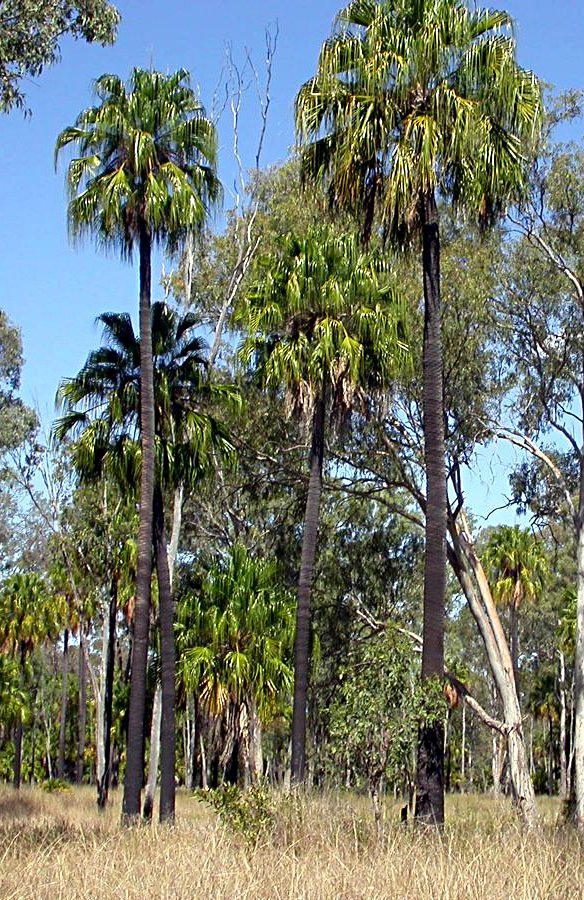
LIVISTONA SARIBUSTHE TARAW PALM
FULL CIRCULAR LEAVES
| Locality of Origin: Southeast Asia – from Malaysia down to some Indonesian Islands Type of Palm / Leaf Type: Palmate, a fan palm Solitary/Suckering: Solitary Plant Height Mature: 35 feet or more Comments on Trunk: Thin trunk for height, somewhat rough with knobs of old leaf bases. Diameter 12 inches Sun Requirements: Full sun, or part sun Cold Tolerance: To 24 to 25 degrees F. Speed of Growth: Slow at first and then moderate Particular Characteristics: The attraction of this species are the very full and near totally circular leaves. These large leaves are green and divided into segments. The leaf stems are armed with large dark spines. Fruits are an unusual blue color. Rarity: Moderately rare General Description/Comments: This palm is interesting because of the circular large leaves. It’s a good grower and a durable species. |

LIVISTONA, OTHER SPECIES OVER TWO DOZEN DIFFERENT PALMS
The genus of Livistona is moderately large with 25 to 30 known species. All of these cannot be presented here. Many of these are native to Australia and the rest are from various areas in southeast Asia. All are fan palms with green leaves although there are some more blue species from the Northern parts of Australia. Many of these can be grown in this area. With this said, there are several that are very difficult to grow here. These come from dry hot areas in Australia. The only place they might survive is in frost free desert areas. The species shown to the right is Livistona rotundifolia, a very tropical species that has some difficulties in Southern CA because of our cooler winters.
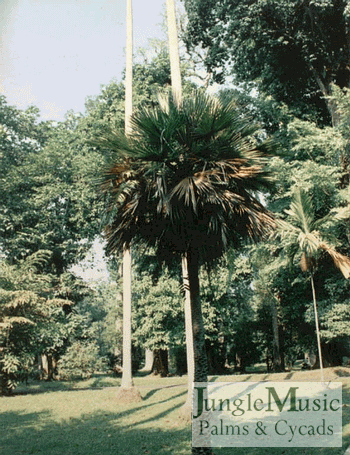
LYTOCARYUM WEDDELLIANUM
THE MINIATURE COCONUT PALM
WEDDELL’S PALM
CUTE DWARF UNDERSTORY PALM
| Locality of Origin: Australia Type of Palm / Leaf Type: Pinnate, a feather palm Solitary/Suckering: Solitary Plant Height Mature: 8 to 10 feet in decades Comments on Trunk: About 2 to 3 inches thick, somewhat smooth if old leaf bases removed. Sun Requirements: Filtered light, an understory pam Cold Tolerance: To about 28 degrees F. Speed of Growth: Slow Particular Characteristics: This is a dainty small palm that is very attractive and cute. It has a small trunk with wispy short green leaves that are only about two, maybe three feet long. It seems to thrive on neglect – not too much water, fertilizer or attention. One day you look at it again and it’s a bit bigger. There’s no data on usage as a houseplant but I’m doubtful it’d do well. Rarity: Very rare General Description/Comments: The perfect small palm for an understory area. Small crown of leaves and rarely gets overhead. |

NANNORHOPS RITCHEANA
NANNIRHOPS ARABICA, BLUE FORM
THE MAZARI PALM
COLD HARDY AND LOVES SUN
| Locality of Origin: Afghanistan, Pakistan and the Arabian Peninsula Type of Palm / Leaf Type: Palmate, fan palm Solitary/Suckering: Suckering Plant Height Mature: 10 to 15 feet mature Comments on Trunk: The trunks are fibrous but have no spines – nor do the leaf stems Sun Requirements: Full sun Cold Tolerance: To the upper teens F. Speed of Growth: Slow Particular Characteristics: This is a small clustering palm. Surprisingly, it has no spines. Leaf color is usually gray or blue green although there are whitish blue varieties available. The latter are referred to as “arabica” and some people feel it should have species status. Leaves of this species are deeply divided with petioles a few feet long. Rarity: Very rare General Description/Comments: This is a sun loving, cold tolerant and water conserving clustering palm that doesn’t get too tall. It can be a bit tricky to get started but once established, is easy to grow. |
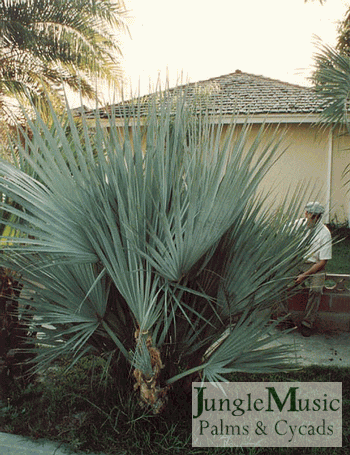
PARAJUBAEA TORALLYI
THE BOLIVIAN COCONUT
| Locality of Origin: Bolivia at 5,000 to 10,000 feet elevation in the Andes Type of Palm / Leaf Type: Pinnate Solitary/Suckering: Solitary Plant Height Mature: 30 to 40 feet or more. Comments on Trunk: The trunk is thick and rough, covered with fibers or old leaf bases. It cleans somewhat over time. Trunk diameter 18 to 24 inches by estimate Sun Requirements: Full sun in almost all areas. This is not a shade palm. Cold Tolerance: Will tolerate temperatures to 18 degrees F. Speed of Growth: Fast growing once established. Particular Characteristics: This is a powerful plant and good grower. Leaves are 12 to 15 feet long, pinnate, green on top with silver on the underside of the leaflet. Crown width is over 15 feet. There are no spines on the leaves or stems. Rarity: Very rare General Description/Comments: This is a spectacular specimen palm that takes heat, sun and is cold hardy. It can grow in inland areas but probably would be stressed in the desert. A 15 gallon will be well over the house in about four years. Availability is always an issue. The first photo is by Andrew Henderson and the second by Gaston Tores. This species is highly recommended. |
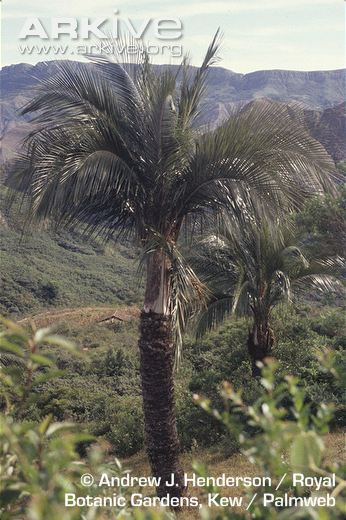

PARAJUBAEA MICROCARPUM
A SMALLER VERSION OF TORALLYI
| Locality of Origin: Bolivia, high elevation at 10,000 feet Type of Palm / Leaf Type: Pinnate, feather palm Solitary/Suckering: Solitary Plant Height Mature: 30 feet Comments on Trunk: This palm is very similar to torallyi above but smaller in terms of trunk height, caliper and overall size. It doesn’t get too tall, has a more narrow trunk and has smaller leaves and crown. Sun Requirements: Tolerates full sun including inland sun Cold Tolerance: To about the same as it’s big sister – estimate of 18 degrees F. Remember, it grows at 10,000 feet elevation in the Bolivian Andes. Speed of Growth: Fast Particular Characteristics: If you look at the photos here and compare them to the torallyi above, you’ll note a similar appearance – just smaller. Lear color green with a touch of silver to the underside of the leaflets Rarity: Very rare, hard to find General Description/Comments: This is a great palm because its smaller mature size, cold hardy, tolerance of arid conditions and is water conserving traits. And, it is fast growing. It’s a real winner. We also highly recommend this species. The first photo is of a younger tree in Encinitas, CA. The second photo is c/o TS at RPS. |
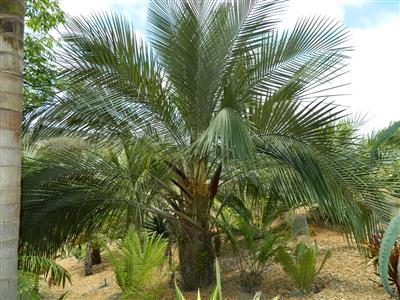
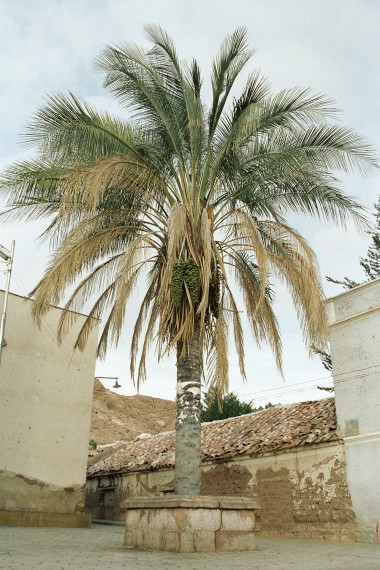
PHOENIX CANARIENSIS
THE CANARY ISLAND PALM
LARGER STATEMENT PALM
| Locality of Origin: The Canary Islands Type of Palm / Leaf Type: Pinnate Solitary/Suckering: Solitary Plant Height Mature: 40 feet and taller in many decades Comments on Trunk: Thick, rough to touch surface. Diameter 18 to 24 inches on average Sun Requirements: Full sun Cold Tolerance: To about 18 degrees F. Speed of Growth: Medium growth rate Particular Characteristics: This Date Palm has very long, armed green leaves. Figure they can be 14 feet long and have wicked spines at the proximal end. There is a gentle arch to the leaves. Leaflets are induplicate, i.e. “V shape” with the trough facing the sky. Rarity: Fairly common General Description/Comments: This is a classic large statement palm for hotels, shopping centers and mansions. It takes at least 20 year to get a trunk overhead. Almost all plants of any size and used for new planting are dug palms coming from an existing location. No nursery can wait 20 years to sell a plant. This particular species has problems with two pests and diseases – Fusarium Wilt and the Palm Weevil. Because of these two serious maladies, the popularity of this species has diminished over the past ten years. Literally, one can spend many thousands of dollars putting a big one in the yard only to have it die within a year if it’s already infected. |

PHOENIX LOUREIROI
THE MOUNTAIN DATE PALM
DWARF DATE PALM
| Locality of Origin: India, Southeast Asia and several surrounding countries Type of Palm / Leaf Type: Pinnate Solitary/Suckering: Solitary and suckering forms Plant Height Mature: Eight to Fifteen feet Comments on Trunk: Fibrous or knobby trunk about 8 to 10 inches thick Sun Requirements: Full sun Cold Tolerance: To the low 20’s F. – about 22 to 23 degrees Speed of Growth: Average Particular Characteristics: Nice palm that has a bigger Date Palm look but never gets overly tall. Leaves are about six feet long, armed and green in color. The photo shows near mature size. Rarity: Moderately rare General Description/Comments: This is an attractive smaller Date Palm that has the look and appearance of a larger Date. Availability is quite limited |
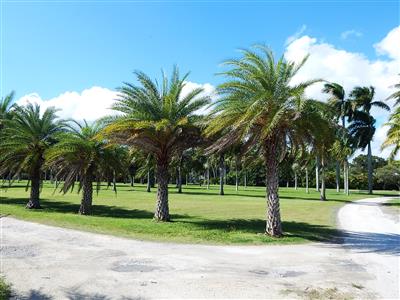
PHOENIX RECLINATA
THE SENEGAL DATE PALM
| Locality of Origin: NSouth Africa, Madagascar, Comoro Islands and the Arabian Peninsula Type of Palm / Leaf Type: Pinnate Solitary/Suckering: Suckering forming a potential large clump of stems Plant Height Mature: Variable – some to 15 feet and some to 35 feet Comments on Trunk: Trunks are fibrous, often with remnants of old leaf bases. Trunk diameters 4 to 10 inches. Sun Requirements: Full sun Cold Tolerance: To the low approximately 20 degrees F. Speed of Growth: Medium growth rate – Note that big over head, multi-stem specimens can take two decades to become this size Particular Characteristics: The leaves of this species are green but much shorter than the Canary. Average is six to ten feet. They also have wicked spines on the leaf stems and gently arch downwards. A plant can have over 20 head of leaves when mature. Rarity: Fairly common General Description/Comments: This species is quite variable when you inspect plants in different gardens. I suspect this is from long term hybridization with other Phoenix palms. But, all have the potential to become huge plants. They take up a long of garden space, both in the air and on the ground. So, you have to decide if you want this particular palm. Don’t let your gardener innocently “throw in a little one” thinking it’s cute. It’s get very large! |
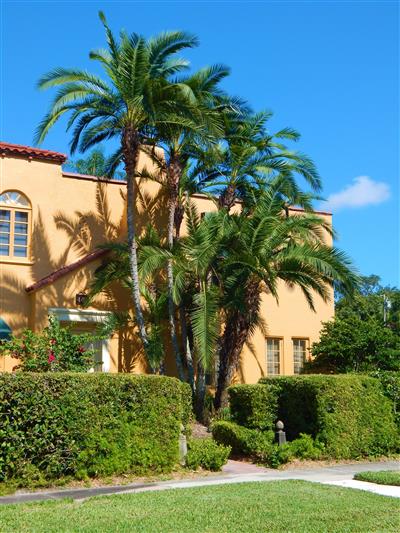
PHOENIX ROEBELENII
THE PYGMY DATE PALM
SMALL, CUTE, OFTEN PLANTED IN MULTIPLES
| Locality of Origin: Southeastern Asia Type of Palm / Leaf Type: Pinnate Solitary/Suckering: Solitary – but most commonly three are planted together so people think that it’s a suckering palm. See below Plant Height Mature: West coast about ten feet tall – More tropical locations plants get taller to about 15 feet.. Comments on Trunk: Trunks are covered with a fibrous material. After many years this can fall off to give a knobby appearance. Sometimes this is manually done prior to the sale of larger plants. Sun Requirements: Full sun. This species can die if planted in shade. Cold Tolerance: To about 22 degrees F. Definitely not the right Date Palm for colder areas. Speed of Growth: Average Particular Characteristics: Heads of leaves on this species are fairly small with 3 to 4 foot long armed (with spines) leaves. In U.S. gardens, this is usually a single trunk species. But, in habitat in Laos, there is a naturally occurring suckering species. Complicate this by the fact that most nursery plants sold are “multiples”. But, presently do realize one plant will always be just one plant. Rarity: Common General Description/Comments: This is a nice and very affordable smaller palm sold at almost every nursery. The second photo shows a single trunk plant in the foreground. |
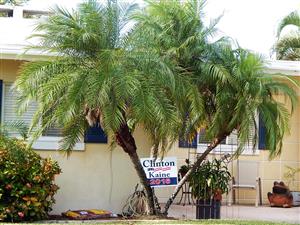
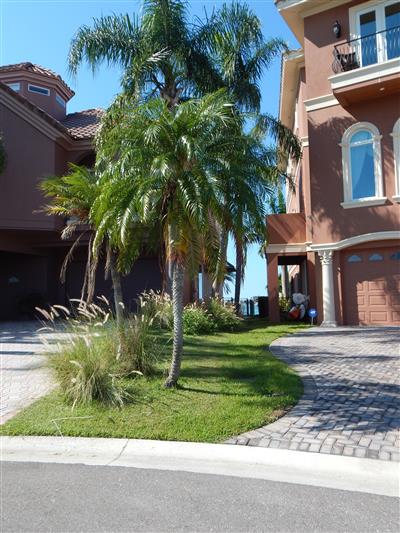
PHOENIX RUPICOLA
THE CLIFF DATE PALM
CONSIDERED TO BE THE MOST BEAUTIFUL DATE PALM
| Locality of Origin: India and Bhutan in mountainous areas Type of Palm / Leaf Type: Pinnate, feather palm with somewhat soft leaves Solitary/Suckering: Solitary Plant Height Mature: 20 to perhaps 25 feet Comments on Trunk: Thin compared to other Dates of similar height – 6 to 8 inches usually Sun Requirements: Full sun Cold Tolerance: To about 24 degrees or a bit lower Speed of Growth: Medium Particular Characteristics: This is a super nice palm for someone who wants a Date Palm. This is because the leaves are softer, more arched, shorter and super green colored. Leaves, like all Dates, do have spines. Rarity: Very rare General Description/Comments: This is a highly recommended palm because of its inherent beauty. Just look at the photo and you understand why. It’s the perfect mature height and requires a rather small garden footprint. Photo by friends M.G. and T.S. |
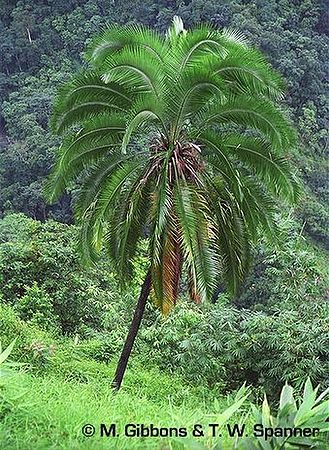
PHOENIX SYLVESTRIS
THE SILVER DATE PALM & INDIAN DATE PALM
LARGER PALM WITH A BLUE COLOR
| Locality of Origin: Various countries in southeastern Asia Type of Palm / Leaf Type: Pinnate, a feather palm Solitary/Suckering: Solitary species Plant Height Mature: To 40 feet or a bit more Comments on Trunk: This is a somewhat rough and knobby trunk. Often one sees fibrous material on the trunk. Sun Requirements: Full sun Cold Tolerance: To about 22 degrees – less cold hardy than the Canary Speed of Growth: Medium Particular Characteristics: This palm has certain things that make it desirable: A definite blue color to the leaves (photos), a thinner trunk and less height compared to the Canary. It is used heavily in the state of Florida, much more than the Canary. It is also les susceptible to Fusarium as far as we know. Leaves are armed and about 10 feet long. On the negative side, it’s less of a statement palm and is not as cold hardy. Rarity: Moderately rare on the West Coast General Description/Comments: This is great choice for someone who wants a large Date Palm in their garden but is concerned about Fusarium problems. It is very attractive appearing. |
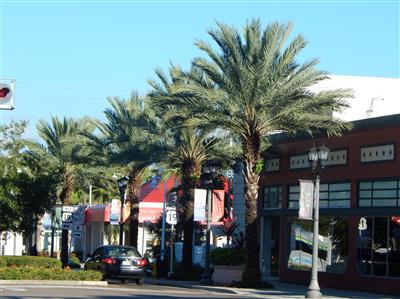
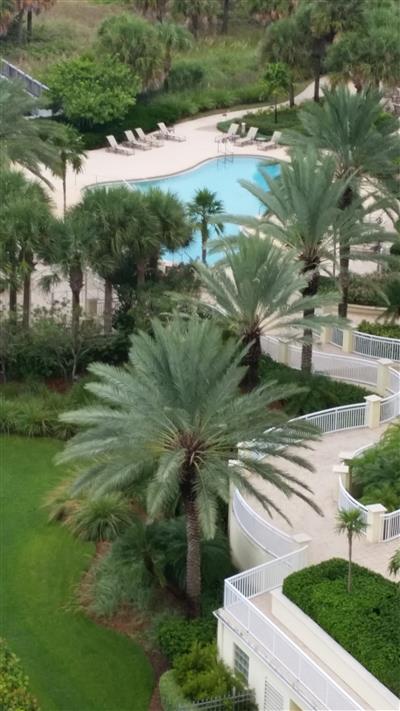
PHOENIX THEOPHRASTII
THE CRETAN DATE PALM
PROBABLY THE MOST COLD HARDY DATE PALM
| Locality of Origin: Greece and Crete Type of Palm / Leaf Type: Pinnate Solitary/Suckering: Solitary and suckering forms – single trunk specimen shown here Plant Height Mature: 40 feet Comments on Trunk: Trunks are rough or knobby Sun Requirements: Full sun Cold Tolerance: Estimate at 18 degrees or a bit lower. Little cultural feedback because it is very rare Speed of Growth: Moderate Particular Characteristics: This is a rather large Date Palm with excellent cold hardiness. It can be either single trunk or sucker. Trunks are a medium diameter with 6 to 8 foot long armed leaves. Leaf color is green to silver green with a touch of yellow in the stems. Rarity: Very rare General Description/Comments: This is another choice if you want a Date Palm. It might be your best choice if you live in a very cold area. Photo by TS at RPS |
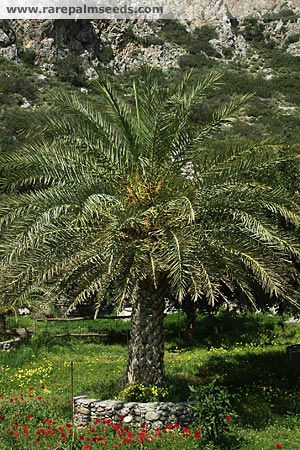
PINANGA CORONATA
IVORY CANE PALM
EXOTIC TROPICAL PALM
| Locality of Origin: Indonesia and other Pacific Islands Type of Palm / Leaf Type: Pinnate Solitary/Suckering: Suckering Plant Height Mature: 8 to 12 feet Comments on Trunk: Thin with green-blond colored crown shaft Sun Requirements: Filtered light Cold Tolerance: To about 28 degrees F. Speed of Growth: Average Particular Characteristics: Very attractive green suckering palm that is tropical and doesn’t get overly tall. Leaflets are green, repetitive in width and length for the most part – in contrast to P. kuhlii which has irregular width leaflets. Also, color on the coronata can be a little mottled. Rarity: Very rare General Description/Comments: This is a nice filtered light palm that you can grow as long as you don’t get overly cold. It is probably the easiest Pinanga for us to grow. Most find it very attractive. And, a bonus is that it sets dark purple seeds. Highly recommended |
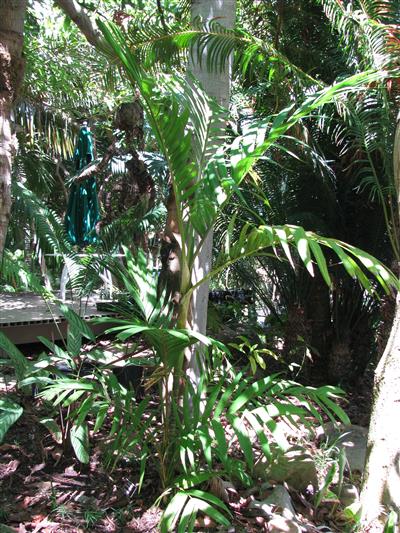
PINANGA ELMERI
ELMER’S PALM
ALSO NAMED PINANGA PHILIPPINENSIS
| Locality of Origin: Philippine Islands Type of Palm / Leaf Type: Pinnate, feather palm Solitary/Suckering: Suckering Plant Height Mature: 1Although not a true dwarf palm, this beauty is small. Typical height is 6 feet or a bit more. Comments on Trunk: Canes are thin, 1.5 inches or less. The lower portions are dark green and ringed. Crown shafts vary from gold to purple, often with multiple colors. Sun Requirements: Filtered light Cold Tolerance: To about 28 degrees F. Speed of Growth: Average Particular Characteristics: The leaves are green and fairly even in width. Plant width is four to six feet (all canes). Crown shafts are various colors and about a foot long. Rarity: Very rare General Description/Comments: This is a great and attractive palm for a filtered light area. It is rarely found for sale. |
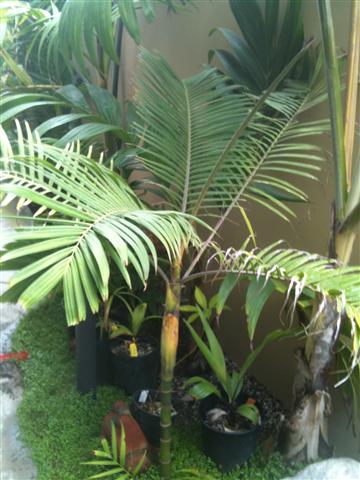
POLYANDROCOCOS CAUDESCENS RECENTLY NAMED ALLAGOPTERA CAUDEXCENS
THE BURI PALM
| Locality of Origin: Brazil Type of Palm / Leaf Type: Pinnate Solitary/Suckering: Solitary Plant Height Mature: 25 to 30 feet, possibly more Comments on Trunk: Trunk diameter 8 to 10 inches, somewhat rough with old attached leaf bases at top Sun Requirements: Full sun Cold Tolerance: To about 27 to 28 degrees F. There is a decades old mature specimen in Ventura, CA Speed of Growth: Slow Particular Characteristics: The leaves are pinnate with a crown of at least ten to fifteen leaves. The crown usually fills the upper half of the crown visual circle – with a few hanging down a bit. Petioles are short. This is a medium sized palm. Rarity: Very rare General Description/Comments: This would be a good choice where someone wants something different for a sunny open location. A treat is that the seed bracts are very unusual with tightly placed orange sherbet colored seeds. Photo by Daryl Oconnor |
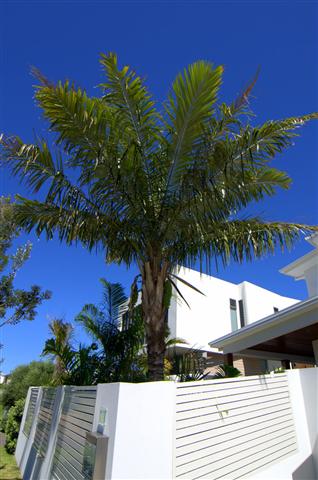
PRITCHARDIA BECCARIANA
TALL TROPICAL FAN PALM FROM HAWAIIA
LARGE FLAT GREEN LEAVES
| Locality of Origin: Big Island of Hawaii Type of Palm / Leaf Type: Palmate Solitary/Suckering: Solitary Plant Height Mature: 60 feet Comments on Trunk: Thin for mature height. Average diameter 10 inches or a bit more. Sun Requirements: Full or part sun. Far inland areas some sun or strong filtered light Cold Tolerance: To about 26 degrees F. Speed of Growth: Average Particular Characteristics: This Hawaiian fan palm is known for it’s very tall mature height and minimally pleated large, round and flat green leaves. Leaves can easily be five feet wide. It was once thought to be the most cold hardy Pritchardia but this may not be true. For most, this species is easy to grow. Rarity: Very rare General Description/Comments: Gardens that just have feather palms can be boring because of the lack of diversity of plant shapes and forms. Any Pritchardia is a good addition to add something different. This species (along with any species of this genus) takes coastal sun, is different and also very beautiful. |
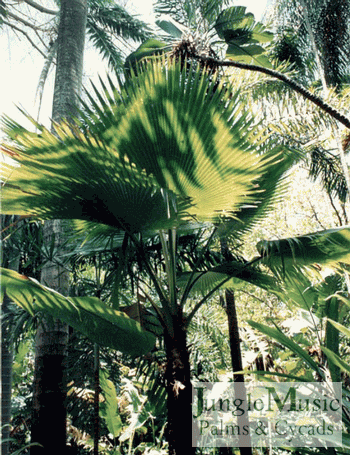
PRITCHARDIA HILLEBRANDII
HILLEBRAND’S LOULU PALM
| Locality of Origin: Molokai, Hawaii Type of Palm / Leaf Type: Palmate, fan palm Solitary/Suckering: Solitary Plant Height Mature: 20 to 25 feet Comments on Trunk: When old leaves have fallen off is a clean trunk with a rough texture, tan in color Sun Requirements: Full or part day coastal sun. Far inland part day sun or strong filtered light. Cold Tolerance: To approximately 26 to 27 degrees F. Speed of Growth: Average, not particularly slow Particular Characteristics: In sun, this species has wavy, stiff, green to blue-green leaves with a short petiole and tight crown of leaves. The first photo shows an arboretum indoor grown plant with longer petioles. But, outdoors (second photo in Orange County, CA) leaves are more compact and stiff. In some habitats in HI, there are plants with very blue leaves. But, in CA, they seem to be just blue-green. Rarity: Moderately rare General Description/Comments: This is any easy to grow fan palm that is medium height, has a thin trunk of about 8 inches and is very attractive. This species is highly recommended. |
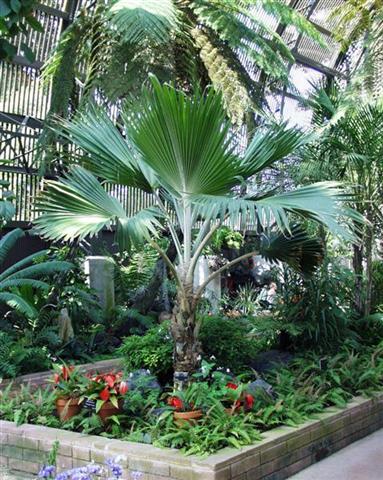
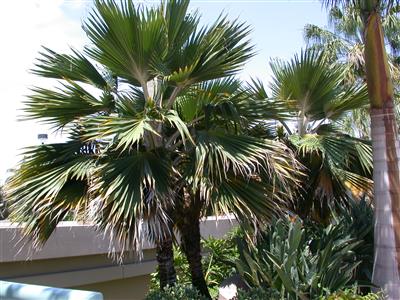
PRITCHARDIA MARTII
THE LOULOU-HIWA PALM
| Locality of Origin: Oahu and possibly Molokai, Hawaii Type of Palm / Leaf Type: Palmate, a fan palm Solitary/Suckering: Solitary Plant Height Mature: 20 to 30 feet Comments on Trunk: The trunk on this species is fairly clean with minimal if any fibrous material. Estimates for diameter are 6 inches. i Sun Requirements: Full sun along the coast although will do fine with half day sun. In far inland areas a few hours of sun or strong filtered light. Cold Tolerance: To about 26 or 27 degrees. I know of a rather large specimen grown by the late Gunther Schwartz which was about 12 feet tall and bearing fruit. Speed of Growth: Average growth rate Particular Characteristics: This species is super attractive because the leaves are fairly large, very flat, minimally divided at the leaf edges and the tree carries a large number of them. The underside of the leaves is covered with fine whitish to rusty colored hairs (see photo). So, one ends up with a large crown of leaves above a rather thin trunk. Although they can get up to 30 feet tall in the wild, I’ve never seen once this size. Rarity: Very rare General Description/Comments: This is another strikingly beautiful tropical fan palms. They are hard to find but worth the search. Remember, pretty fan palm add to the character of the garden. So, use some. Highly recommended. |
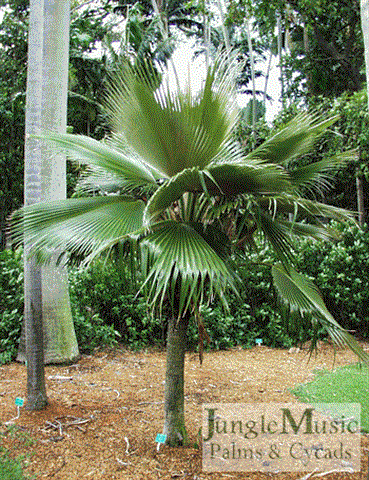
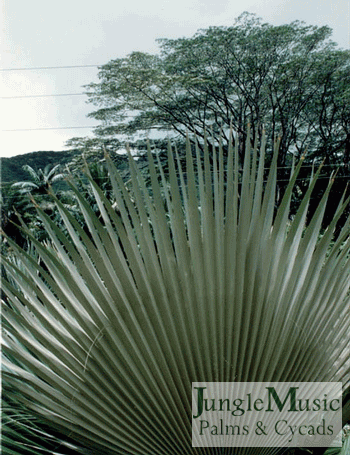
PRITCHARDIA MINOR
ALAKAI SWAMP PRITCHARDIA
| Locality of Origin: Kauai, Hawaii Type of Palm / Leaf Type: Palmate, a fan palm Solitary/Suckering: Solitary Plant Height Mature: 10 to 15 feet Comments on Trunk: Thickness 6 to 8 inches. Clean but rough, columnar Sun Requirements: Full or part sun, less sun far inland Cold Tolerance: To 26 to 28 degrees F. Speed of Growth: Slow to average Particular Characteristics: Green leaves that are not too overly large – about four feet across. They are flat with a 3 foot petiole. Of the species in this genus, this is one of the more cold tolerant. After habitat viewings, it was felt that this would be a semi-dwarf species. But, domestically grown, it is a bit bigger than expected – see photo. It tolerates coastal sun. Rarity: Very rare General Description/Comments: This is a highly recommended species and easy to grow. It’ll take full or part sun on the coast. All the Pritchardias have their own unique look. The crown on this species is not huge and it’s very attractive. Highly recommended |
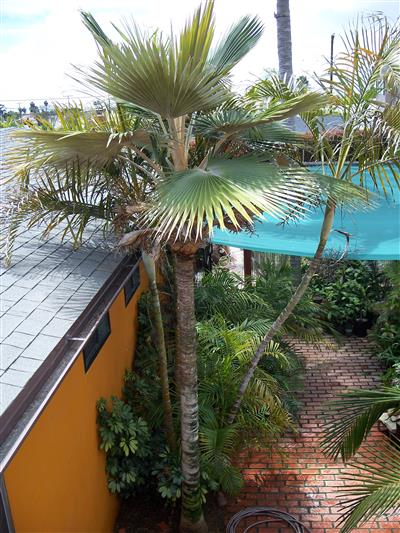
PRTICHARDIA SPECIES OF HAWAII
THE HAWAIIAN FAN PALMS
THERE ARE A LOT OF OTHERS TO CHOOSE FROM
This genus of fan palms is best known for its native locality throughout the Hawaiian Islands. But, there are a few species from the South Pacific. For those of us in Southern California, you want to stay away from from the South Pacific because they don’t grow as well and don’t take our winter temperatures. But, all of the Pritchardias from Hawaii do well in our coastal areas. This includes at least 20 species native to one island or the other in Hawaii. Anticipate that you can grow them all.
Near the coast, they do fine with full sun. Partial sun is ok as well. Inland areas should consider part day sun or strong filtered light. Cold tolerance of the genus is into the mid to upper twenties area F. Heights are variable. Some never get over ten feet tall in 50 years. Others easily get over 30 feet. Differences among species includes whether the leaves are flat, whether they are wavy, whether there’s a different color on the underside of the leaf, seed size and overall stature. Trust that all or gorgeous and great additions to the garden. The plant shown to the right is the very rare Pritchardia lowreyana.
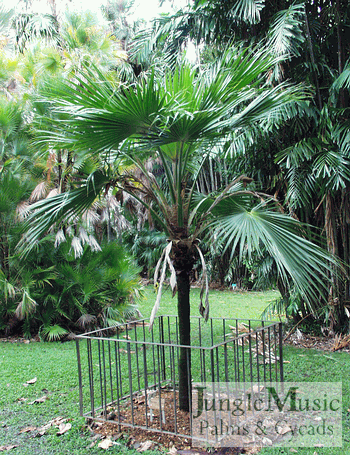
PSEUDOPHOENIX SARGENTII
THE CHERRY PALM
BUCCANEER PALM TREE
| Locality of Origin: Florida, Cuba and other Caribbean Islands Type of Palm / Leaf Type: Pinnate and crown shafted Solitary/Suckering: Solitary Plant Height Mature: 15 feet Comments on Trunk: The trunk on this species is quite interesting. Average diameter is about ten to twelve inches. Sometimes it is an attractive silver-green. It has prominent rings. Also, sometimes is has a variable width with bugling randomly throughout the trunk. Sun Requirements: Full sun Cold Tolerance: To about 26 degrees Speed of Growth: Extremely slow. From a one gallon plant to overhead leaves can take 8 to 10 years. So, be patient. Particular Characteristics: The leaves are green and slightly plumose on most trees. The crown shaft is silver green, sometimes with a strange bulging. Of the species of this genus, this is the most cold hardy. All are slow to grow. Rarity: Very rare General Description/Comments: This is a unique and very interesting palm. It’s just super slow to get to any size. But, for those who have grown it and been patient, all are very satisfied. |
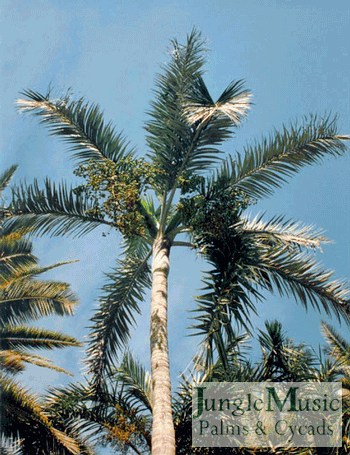
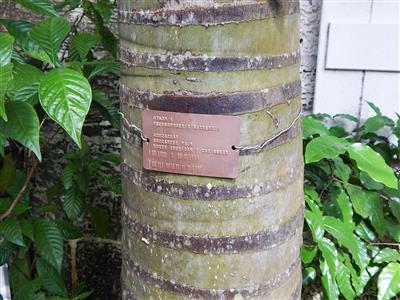
PTYCHOSPERMA ELEGANSTHE SOLITAIRE PALM
| Locality of Origin: Australia Type of Palm / Leaf Type: Pinnate Solitary/Suckering: Solitary Plant Height Mature: 25 – 30 feet Comments on Trunk: Thin, averaging 4 to 6 inches. In shade, green in color. In sun, the color is tan. Crown shaft is silver green and elongated. Sun Requirements: Full or part day sun on the coast. Inland areas part sun or filtered light, especially in desert Cold Tolerance: To about 28 degrees F. Speed of Growth: Average Particular Characteristics: This is a thin trunked yet moderately tall pinnate palm. Leaves are green and basically flat with a bit of keel. Leaf petioles are short. Leaflet ends are premose with a “chopped off” appearance. It is tropical appearing and sometimes looks good in a grouping of several together. Rarity: Fairly rare General Description/Comments: This is a desirable species and highly recommended because it’s easy to grow, takes some sun, is not overly large and is tropical appearing. It is also a nice patio plant and is possible to grow indoors. |
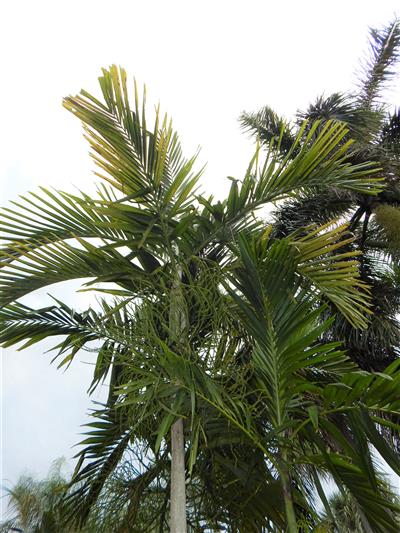
PTYCHOSPERMA LINEARE
CLUSTERING THIN TRUNKED FILTERED LIGHT PALM
| Locality of Origin: Papua New Guinea Type of Palm / Leaf Type: Pinnate Solitary/Suckering: Suckering Plant Height Mature: 40 feet Comments on Trunk: Very thin trunks with a diameter of one to two inches. Crown shafts are green sometimes with silver. Trunks are close together some it has a packed appearance to the stems. Sun Requirements: Filtered light Cold Tolerance: To a freeze or a bit lower Speed of Growth: Average Particular Characteristics: This is a super attractive and tropical appearing green clustering palm. Although fairly tall, the trunks are quite small. Leaves are premorse with jagged leaftip ends. One must live in a more mild climate to grow this species but it’s being done by many. Rarity: Very rare General Description/Comments: This is a great palm if you don’t get too cold and can offer some sun protection. If it outgrows your canopy, it’ll probably do fine with the sun. |
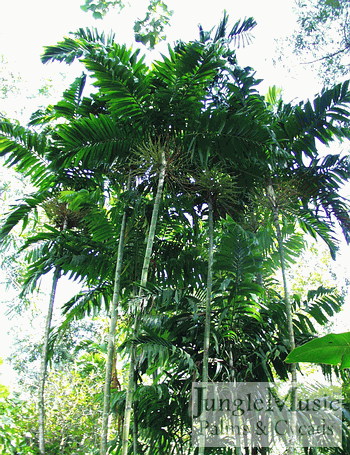
PTYCHOSPERMA SHEFFERI
SOLITARY OR CLUSTERING TROPICAL PALM
| Locality of Origin: New Guinea Type of Palm / Leaf Type: Pinnate Solitary/Suckering: Solitary or clustering forms. All have crown shafts. Plant Height Mature: 15 feet Comments on Trunk: This species has a single and clustering form. Trunks are think, w to 3 inches and mature plant height is only 15 feet. So, it’s shorter than P. elegans above. The crown shaft is green. Sun Requirements: Filtered light or part day sun. Cold Tolerance: To about 28 degrees F. Speed of Growth: Average Particular Characteristics: With either form, the leaves are green, leaflets premorse, crown size small to medium and garden footprint small. Rarity: Very rare General Description/Comments: This species can sucker or be a solitary palm. It’ll take some sun. It’s success in full sun is not known here. As it only gets to about 15 feet, it might be a great choice for someone with good winter lows who needs a shorter tropical green palm. |
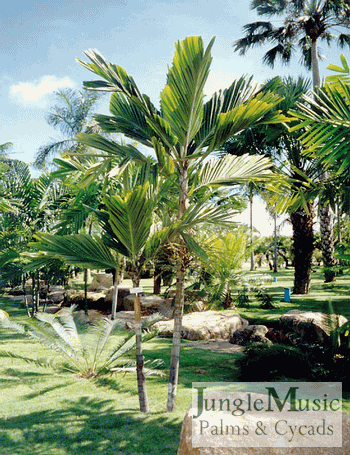
RAVENEA GLAUCA
EASY TO GROW – MEDIUM SIZED
BEAUTIFUL PALM
| Locality of Origin: Madagascar Type of Palm / Leaf Type: Pinnate Solitary/Suckering: Solitary Plant Height Mature: 15 to 25 feet (see below) Comments on Trunk: On the more narrow side, about 4 to 8 inches. Smooth but a little rough to the touch. Sun Requirements: Full sun along the coast a somewhat inland. If far inland, part day sun or strong filtered light Cold Tolerance: To 26 or 28 degrees F. Speed of Growth: Moderate Particular Characteristics: When first discovered, projections would be that this is a smaller mature tree. But, over time we’ve found that it easily gets to 25 feet, perhaps a bit more. Also, some plants have thicker trunks than others. This is probably just a cultural issue. But, now there are reports that there are two populations of this species growing in Madagascar with different appearances. Perhaps the second population will be a new similar species. With the classic description, leaves are green, there’s a whitish glaucous frost on the leaf stems and inner crown and trunk size is 4 to 6 inches. Rarity: Moderately rare General Description/Comments: This is a highly recommended species of single trunk palm that doesn’t get overly large. It has green leaves and a thinner trunk. It tolerates full sun or part sun and also survives with drought conditions. So, it’s near the perfect palm. The first photo to the right is one of my favorite palm Photos. It’s c/o Palmpedia by an unknown author. The second photo is of a juvenile tree not far from the nursery. |

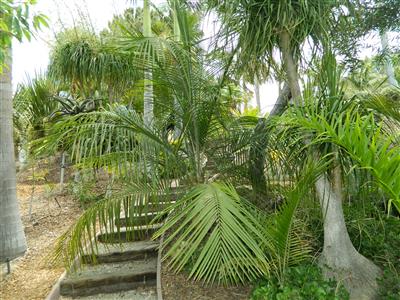
RAVENEA HILDEBRANDTII
THE DWARF MAJESTY PALM
SHORT SINGLE TRUNK TROPICAL PALM
| Locality of Origin: Comoros Islands near Madagascar Type of Palm / Leaf Type: Pinnate Solitary/Suckering: Solitary, dwarf palm Plant Height Mature: 8 feet Comments on Trunk: Thin and clean, diameter three inches Sun Requirements: Filtered light although some have grown it in sun with success Cold Tolerance: 26 to 28 degrees F. Speed of Growth: Average but remember, it’s not going to get big or tall Particular Characteristics: Leaves are green, flat and about three feet long. The crown of leaves is small, no more than five feet wide. It holds about 8 or so leaves. Rarity: Very rare, hard to find General Description/Comments: This is a sought after and great species where a dwarf single trunk palm is needed. It’s quite cute and may look good as a small colony. We highly recommend this species if you can find one. |

RAVENEA JULIETIAE
RARE MEDIUM SIZED MALAGASY PALM
| Locality of Origin: Eastern Coast of Madagascar Type of Palm / Leaf Type: Pinnate Solitary/Suckering: Solitary Plant Height Mature: 15 – 30 feet tall Comments on Trunk: Trunk diameter 6 to 8 inches, smooth over time with some old leaf debris below the crown. No crown shaft. Sun Requirements: Full or part sun along the coast, less sun far inland Cold Tolerance: Estimate of 26 to 28 degrees F. Speed of Growth: Slow to medium Particular Characteristics: Leaves are green, gently arching. Crown holds about ten leaves. Leaf length 10 feet. Rarity: Extremely rare General Description/Comments: This is a new and very pretty medium sized palm that shows promise for this area. If you’re an enthusiast, get one while you can. Photo by friend R. Kyburz |

RAVENEA RIVULARIS
THE MAJESTY PALM
| Locality of Origin: Madagascar Type of Palm / Leaf Type: Pinnate Solitary/Suckering: Solitary Plant Height Mature: 25 to 50 feet Comments on Trunk: Thick at the base, tapering to a smaller diameter to top of trunk. Smooth in appearance. Basal diameter 18 inches or more Sun Requirements: Full sun. In desert areas, part sun Cold Tolerance: To 26 to 28 degrees, possibly a bit more cold hardy than this Speed of Growth: Reasonably fast growing Particular Characteristics: Green leaves, flat in cross section, mostly upright, 8 to 10 feet long. They have a little bit of arch. This species needs adequate nutrition and water. Otherwise, leaves become anemic and yellow. Trunks are fat at the base, up to 18 inches thick. Growth rate is quick. Very close to the ocean we’ve noted many plants get crown rot. But, about a quarter of a mile from the ocean and growth is normal. This species has trouble in the desert in full sun. This species is used as a houseplant, but there are much better interior palms. Rarity: Fairly common General Description/Comments: This is a fast growing larger palm that has no spines or armor. It needs regular fertilizer and lots of water to look its best. It is not a rare palm but is quite pretty. The second photo by MR shows a group growing next to a rive in habitat. Note the dark green color of the leaves with lots of water. |
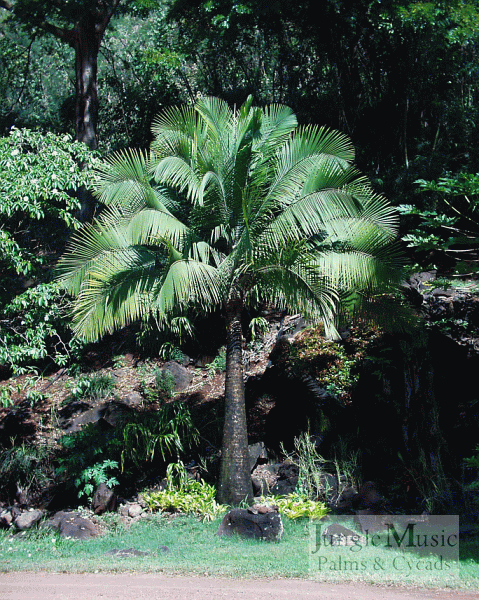
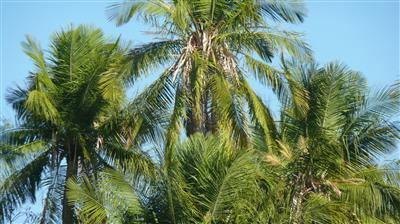
RAVENEA XEROPHILA
DROUGHT TOLERANT BLUE MADAGASCAR PALM
| Locality of Origin: South Madagascar in dry forest area Type of Palm / Leaf Type: Pinnate, blue leaves Solitary/Suckering: Solitary Plant Height Mature: 15 – 20 feet or a bit more Comments on Trunk: Trunk diameter about 10 inches. Heavy debris and old leaves hanging downward below crown. No crown shaft Sun Requirements: Full hot sun Cold Tolerance: To about 24 degrees Speed of Growth: Extremely slow growing, even in the ground. Particular Characteristics: This species is drought tolerant, blue colored and not overly large. The blue leaves are arching and 6 to 8 feet long. With removal of old dead leaves, this tree is attractive and interesting. Not, young plants have a huge primary root radical. It’s almost like a cycad root. In pots, nothing seems to speed them up. Availability of this species is very sparse. Rarity: Extremely rare General Description/Comments: This is a sought after rare palm that is drought tolerant, blue and grows in desert areas. It doesn’t get overly large and is very different appearing. The first habitat photo is by TS at RPS. The second photo is of about a ten to twelve year old tree. |
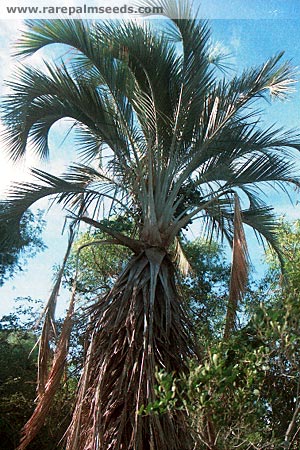
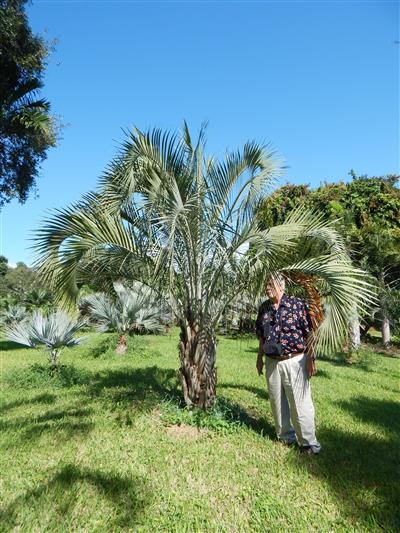
RAVENEA SPECIES OTHER
Ravenea are a group of single trunk pinnate palms from Madagascar. Most can be grown in Southern California and many species are very new to collectors. Most are very sought after. The most common species of this group is the Majesty Palm. There are about 25 different unique species described. We can’t present them all here. Reference books or the Internet will lead you to a whole world of these fantastic palms. Shown to the right, in the center of the photo, is Ravenea madagascarensis at the garden of the late Mardi Darian.
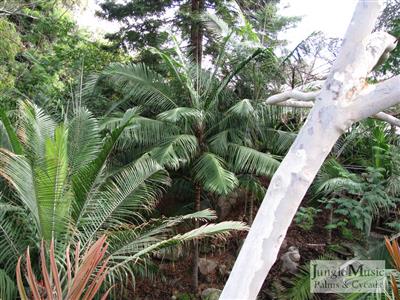
RHAPIDOPHYLUM HYSTRIX
THE NEEDLE PALM
| Locality of Origin: Southeastern U.S. Gulf States Type of Palm / Leaf Type: Palmate Solitary/Suckering: Suckering Plant Height Mature: 6 feet, maybe a few feet more Comments on Trunk: Small trunks with minimal height with leaves overhead – in a tight clump of stems. Plants are as wide as tall. Sun Requirements: Full or part sun or strong filtered light Cold Tolerance: Most cold hardy palm in the world – down to about 0 degrees F. Speed of Growth: Slow Particular Characteristics: Leaves are green on top and about 24 to 30 inches across and deeply divided. Needles are attached firmly to the trunks. These are large, sort of like a small knitting needle, brown in color. Rarity: Although growing in the wild, nurseries seldom have available. General Description/Comments: This is a remarkable species because of its cold hardiness. Most of the customers who buy this live in really cold climates. Its a shrubby plant but has its merits. |
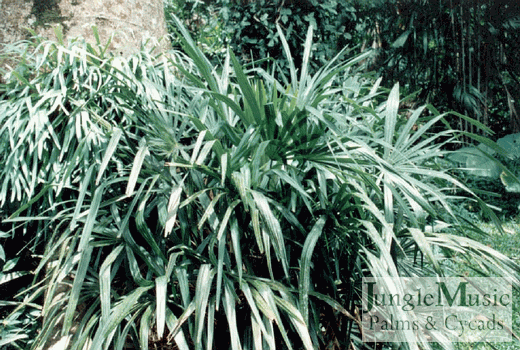
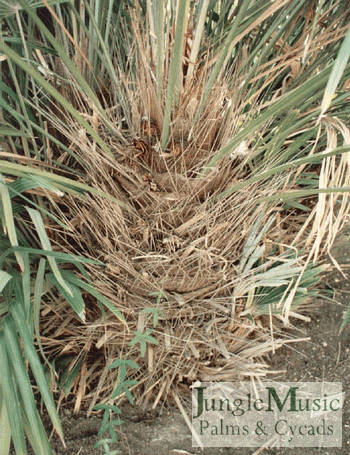
RHAPIS EXCELSA
THE LADY PALM
| Locality of Origin: China and Taiwan Type of Palm / Leaf Type: Palmate, a smaller fan palm Solitary/Suckering: Suckering forming smaller clumps Plant Height Mature: 4 to 10 feet, rarely a bit taller Comments on Trunk: Trunks are narrow, an inch thick or less. Trunks are covered with coarse brown fibers and some old leaf stems. New stalks are made from basal suckers off the bottom of existing older trunks. Sun Requirements: Filtered light – not good for full hot sun Cold Tolerance: To about 18 to 22 degrees F. Speed of Growth: Extremely slow Particular Characteristics: This is the most popular fan palm worldwide. It is used as a house or patio plant and also in the garden. Leaves are green and palmate with about four to eight leaflet segments. Leaf tips come to a blunt, jagged end. There are different clones of this species – large or short. So, mature height is hard to predict. Most are in the 4 to 6 foot range. They can burn from desiccation or too much fertilizer. Rarity: Fairly common General Description/Comments: The Lady Palm is a favorites for inside the house but makes a great garden plant for shade in this area. Everyone in this area could use one, either in the garden or on the patio. Because they are slow growing, they tend to be pricy compared to other palm species. Because of its attributes, it is highly recommended. |
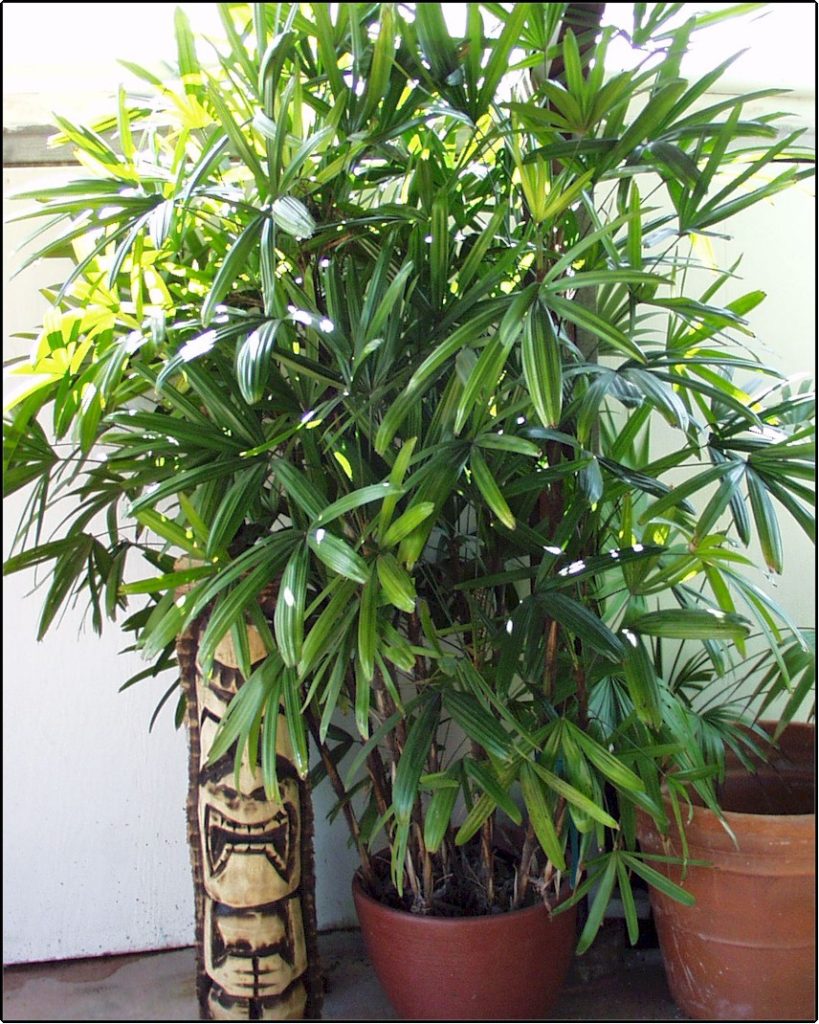
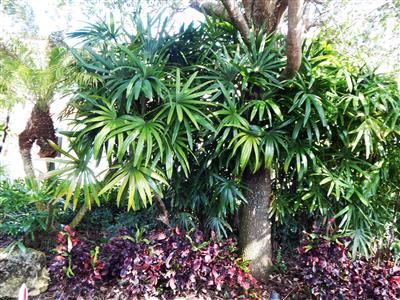
RHAPIS EXCELSA
VARIEGATED VARIETIES
| Locality of Origin: Asia, exact origin unknown. Most like originated in China or Taiwan. But, presently very popular in Japan. Type of Palm / Leaf Type: Palmate, miniature palms Solitary/Suckering: Suckering dwarf palm Plant Height Mature: 3 to 6 feet Comments on Trunk: These are small plants. Trunks are 1/2 to 3/4 inch thick but never very tall. Sun Requirements: Filtered light. Often grown inside the home. Cold Tolerance: To about 18 degrees F. Speed of Growth: Extremely slow Particular Characteristics: Small fan leaves one foot across. Variegation patterns are variable. Usually it’s yellow on a green background. Different varieties have different variegated patterns. Rarity: Extremely rare – and pricy General Description/Comments: Beautiful specimens of these variegates are coveted by collectors and often used in upscale hotels or on the desk top of CEO’s of major businesses in Japan. But, you can get one as well and grow it in the garden. We do offer them for sale. Read more about Variegated Lady Palms |
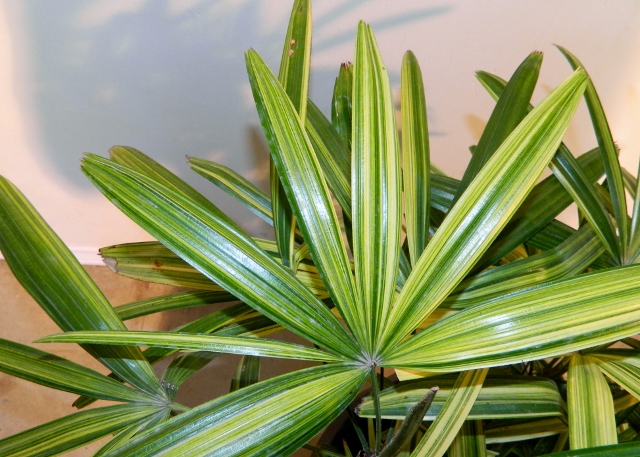
RHAPIS HUMILIS
THE SLENDER LADY PALM
TALL AND TOLERATES SUN
| Locality of Origin: Not certain but probably China or Taiwan Type of Palm / Leaf Type: Palmate Solitary/Suckering: Suckering Plant Height Mature: See below but the tall variety gets to 20 – 25 feet Comments on Trunk: Trunks are about an inch thick. They are covered with coarse brown fiber. This fiber can be removed but weakens the stem. Healthy trunks grow straight upwards but may lean after getting real tall. Sun Requirements: Filtered light or full coastal sun with this tall variety Cold Tolerance: To 18 degrees F. Speed of Growth: Very slow Particular Characteristics: With this species we are discussing the type seen in California. It’s very tall, over 20 feet, and tolerates full sun. The origins of this variety or species is unclear. But, only male plants are in existence here. This is a dioecious species. So, plants are obtained only by divisions. Therefore they are very expensive. Leaves are about 12 to 18 inches wide, have about 15 to 25 leaflets and these leaflets come to a definite point – different than R. excelsa Rarity: Very rare and hard to find General Description/Comments: This is an exceptional species and only comes from a division of an existing plant. They are the ultimate in upscale plantscape (along with rare cycads). This species is highly recommended. If you can afford one and find one, get it. Read more about Rhapis humilis Photo assistance by FM of Los Angeles Arboretum |
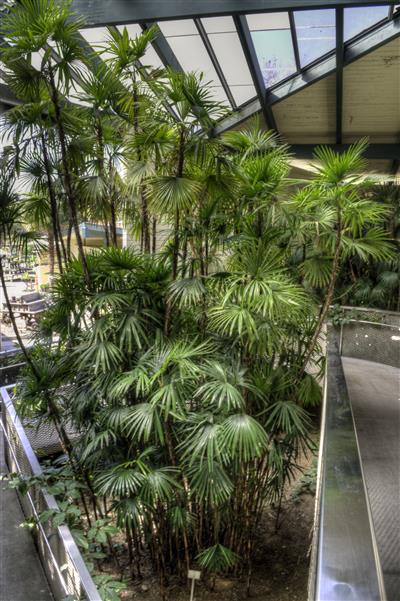
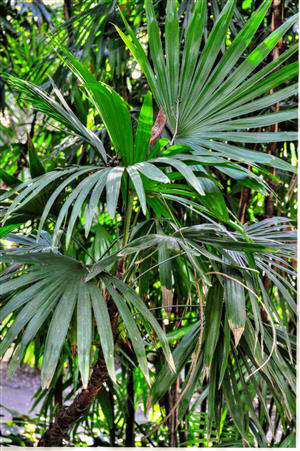
RHAPIS MULTIFIDA
THE FINGER PALM
| Locality of Origin: China Type of Palm / Leaf Type: Palmate, fan palm Solitary/Suckering: Suckering Plant Height Mature: 8 feet, ideal for the average home Comments on Trunk: Thin, diameter 1/2 inch. Covered with brown fibrous hairs. Sun Requirements: Filtered light. Can grow in sun but gets to be limy green Cold Tolerance: To lower 20’s F. Not as cold hardy as other Rhapis above. Speed of Growth: Very rare, tends to be expensive Particular Characteristics: This species is similar to R. humilis above but is not the same. It has thinner trunks, smaller leaflets and doesn’t get as tall. And, it doesn’t do well in full sun. Leaves are about 12 to 18 inches across, leaflets do come to a point and overall size is ideal for a houseplant. Leaves are dark green when well grown. Leaflet count is usually twelve to eighteen. Rarity: Very rare General Description/Comments: This is another great interior or garden plant. Most in Co Cal can grow it easily in filtered light or in the home. One must be careful not to over-fertilize it and also to give it ample water. |
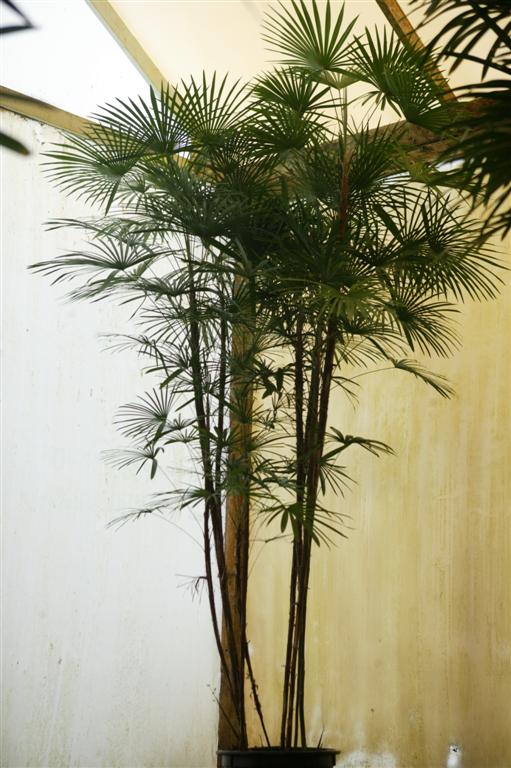
RHOPALOSTYLIS BAUERI
THE NORFOLK ISLAND PALM
| Locality of Origin: Norfolk Island (Australia) and Kermadec Islands (New Zealand) Type of Palm / Leaf Type: Pinnate, feather palm Solitary/Suckering: Solitary Plant Height Mature: 30 to 40 feet in many decades Comments on Trunk: Trunks, when grown in or protected from shade, are green with prominent rings. A minimally bulging crown shaft is below the leaves. The trunk diameter is 8 to perhaps 10 inches. Sun Requirements: Part day sun is best. Some grow it in full sun right on the ocean but it’s safest to give it less sun. Inland areas – A few hours of sun or filtered light. Cold Tolerance: To about 23 degrees f. Speed of Growth: Slow Particular Characteristics: Leaves are about ten feet long, arching with brownish tinge to the leaf stem. They are more relaxed than the very upright leaves of R. sapida. The crown shaft has a minimal amount of bulge, not nearly as pronounced as seen with the sapida. Rarity: Modeately rare General Description/Comments: Both this species and the next one are highly recommended. Most people have great success with them. Growth is slow but worth the time. Be patient. The first photo was taken in Balboa Park, San Diego and the second shows the clean green color – see second photo. Read more about Rhopalostylis |
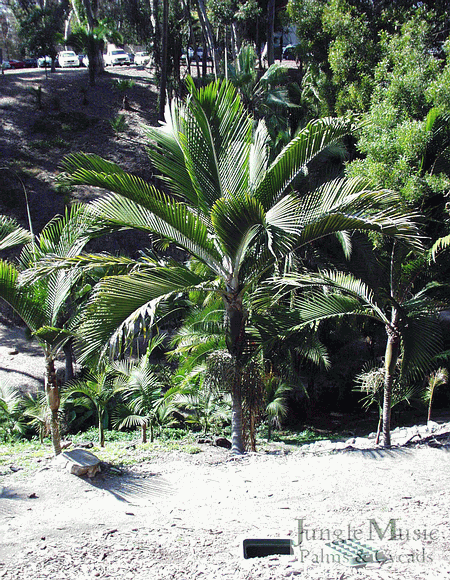

RHOPALOSTYLIS SAPIDA
THE SHAVING BRUSH PALM – FEATHER DUSTER PALM
THE NIKAU PALM
Locality of Origin: New Zealand, the only palm native to this island
Type of Palm / Leaf Type: Pinnate
Solitary/Suckering: Solitary
Plant Height Mature: 30 feet
Comments on Trunk: Trunk diameter about 10 inches with prominent bulging crown shaft
Sun Requirements: Full sun on the coast or part sun. Far inland a few hours sun only. Or, filtered light.
Cold Tolerance: To about 22 degrees F. This species is doing well in the city of San Francisco and the rest of the Bay Area.
Speed of Growth: Slow
Particular Characteristics: Compared to R. baueri above, this species has upright leaves. They will relax down over time but most go straight towards the sky as shown. The crown shaft is quite prominent, sometimes super bulging. Leaves are green and the leaf stem is a silver/gray color whereas baueri is a brownish color.
Rarity: Moderately rare
General Description/Comments: This is another highly recommended species. It takes more sun than baueri. Everyone should have one. The main thing is deciding how much sun to give it. If you live more than about six miles from the ocean, give it half day sun. Far inland, only a few hours. To read more see link in last species. Highly recommended

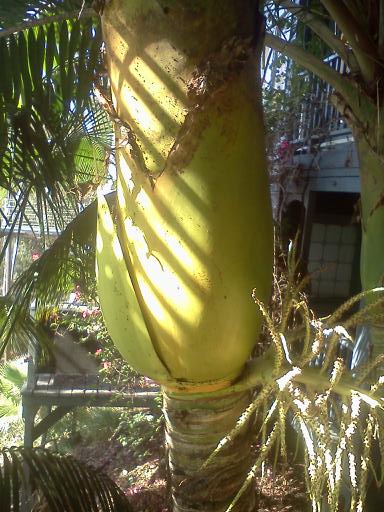
RHOPALOSTYLIS CHEESEMANII
ANOTHER SPECIES OF RHOPALOSTYLIS?
There are certainly varieties of Rhopalostylis from different New Zealand locations. All are a bit different. None are thought to be true different species.
But, there has been a historical controversy over the native population of Rhopalostylis located on Raoul Island, part of the Kermadec Islands of New Zealand. Because of patriotism, New Zealanders would certainly like to consider this population is a species all to itself. But, most people now consider it to be a variety of Rhopalostylis baueri, the Norfolk Island Palm. New Zealanders feel it should be a species because it has more round and larger fruit, and brown hairs present on the crown shaft. Also, some say it’s a more robust growing species. With this said, as it stands presently, this palm is formally Rhopalostylis baueri variety cheesemanii. I’m showing a photo to the right. In the garden, it’s a great palm to grow.
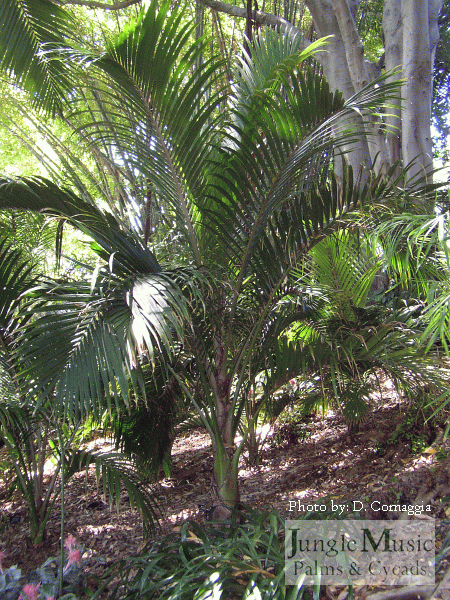
ROYSTONEA BORINQUENA
THE PUERTO RICAN ROYAL PALM
| Locality of Origin: Hispaniola, Puerto Rico and the Virgin Islands Type of Palm / Leaf Type: Pinnate Solitary/Suckering: Solitary Plant Height Mature: 40 to 60 feet Comments on Trunk: Thick gray trunk with diameter of 18 to 28 inches Sun Requirements: Full sun Cold Tolerance: To about 24-25 degrees F. Speed of Growth: Fast Particular Characteristics: This species has long, rather plumose leaves that are 8 to 12 feet long. The crown shaft is green. This species became more sought after the year 2007 when most had severe winter low temperatures. It was found that there was less burn on this species than the R regia. Although many felt this way, it hasn’t been studied. Rarity: Moderately rare – hard to find General Description/Comments: This is an excellent full sun choice where cold might be a concern and where you have ample full sun room. It’s a gorgeous palm but doesn’t have quite the swelling of the base of the trunk as you’d see with the Cuban Royal. In Puerto Rico it’s the main palm lining avenues and streets. Overall, it’s a great palm. |
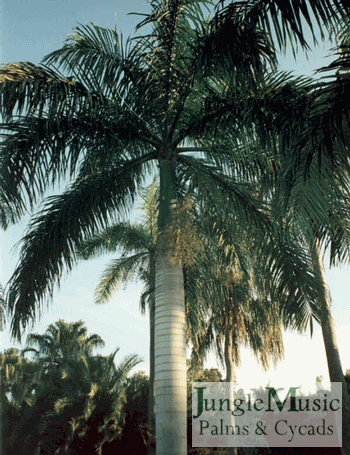
ROYSTONEA OLERACEA
THE SOUTH AMERICAN ROYAL PALM
THE IMPERIAL PALM
Locality of Origin: This species has a large distribution. It is endemic to Columbia, Venezuela and several islands in the Caribbean.
Type of Palm / Leaf Type: Pinnate
Solitary/Suckering: Solitary
Plant Height Mature: This species is one of the tallest trees in the world! It can reach heights well over 100′ tall. On a trip that Jesse and Phil took to New Caledonia we saw a stand of domestic Roystonea oleracea which were approximately 150 years old and planted closely in a grove. These giants were close to 200′ tall. I have never seen anything quite so impressive. I’ll share a photo of this to the right – taken at dusk.
Comments on Trunk: This species makes large vascular trunk which are grayish/white in color. Often times in the wild or tropical climates you will see the trunk covered in green or brownish/green moss. It is truly a sight to see. The diameter can easily reach over 2′ on large, old specimens.
Sun Requirements: Full sun
Cold Tolerance: This species is not as hardy as some other the other species of Roystonea, but can still tolerate into the upper 20’s (28-29) F.
Speed of Growth: Fast rate of growth on this species.
Particular Characteristics: This species is very tropical in appearance. I makes long, plumose leaves (approximately 15′ long) which are dependent to the crown. They have thicker leaves than some other species which adds to their tropical appearance. Opposed to the Cuban Royal, this species seldom has leaves hang down past the median point of the crown. This species does require adequate garden space to grow, and one must be caution of falling leaves as the species get taller (this is the case will ALL Roystonea).
Rarity: Rare
General Description/Comments: This is a fantastic self-cleaning species. It is fast and tropical looking. It is not suited for exceptionally cold climates, but would make an excellent addition to most temperate or hot/hot and humid environments.
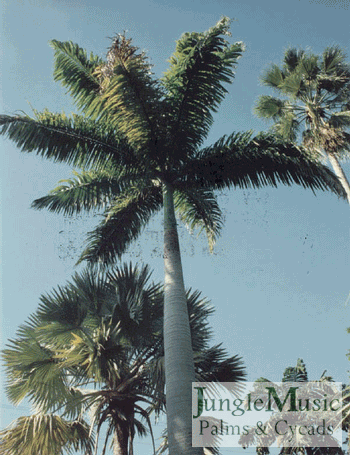
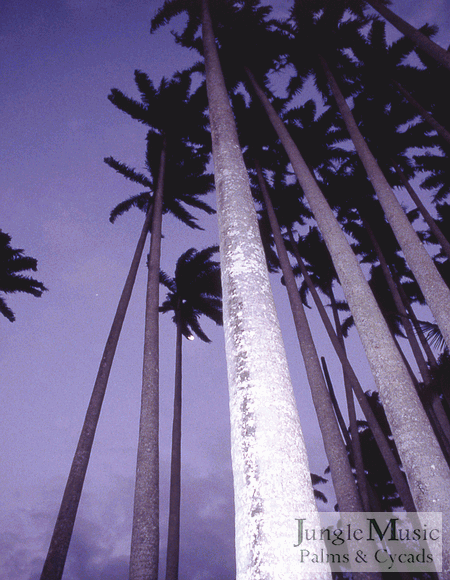
ROYSTONEA REGIA
THE CUBAN ROYAL PALM
Locality of Origin: This species is endemic to Cuba as the name would suggest, but it has also naturalized throughout the Caribbean, the Gulf of Mexico, Central America and southern Florida.
Type of Palm / Leaf Type: Pinnate
Solitary/Suckering: Solitary
Plant Height Mature: This species can grow quite tall, reaching heights over 80′. Even in cultivation, this species will reach well over 50′ in time.
Comments on Trunk: This species may a very large cigar shaped trunk which is vascular/woody and is a light whitish/gray color. The stems are quite large and need space. They can easily get over 20″ and in some cases over 2 feet in diameter.
Sun Requirements: Full sun
Cold Tolerance: This can tolerate into the mid 20’s F, but not much below 25 degrees F. This species will not tolerate these temperatures for prolonged periods of time though.
Speed of Growth: Fast rate of growth
Particular Characteristics: This is the trade mark palm of southern Florida. The are regularly used along avenues and are quite stunning and stately looking. They are often referred to as an ‘avenue palm’ for this reason. They make long, plumose leaves, approximately 12-15′ long. They have beautiful bright green crown shafts which are 6-8′ tall. They are a self-cleaning palm (as all crown shafted species are – with size). Of the ‘Royal Palm’ family, this is one of the easiest species to grow. One of the characteristics of this species is that it does have leaves that hang down below the crown median line. I.e., leaves lower down toward the trunk. The South American Royal doesn’t do this and this is a good way to tell them apart.
Rarity: Moderate
General Description/Comments: This is a fantastic palm and work in most garden designs. A few points to bear in mind about this species is that they get very large and tall. They will need space in the garden. They do no perform well if they are overly shaded. They make large, heavy leaves – when they shed older leaves they can definitely cause damage to whatever lies below! That said, I still highly recommend this species. With adequate space and proper placement there are few palms that you can grow that will offer as much as this species (grows fast, is self-cleaning, is a great canopy former, is hardy to heat and sun, etc.).
The second photo shows a large Royal Palm about two blocks from our nursery.
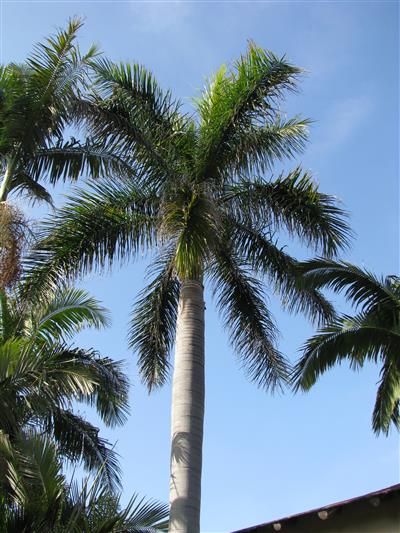
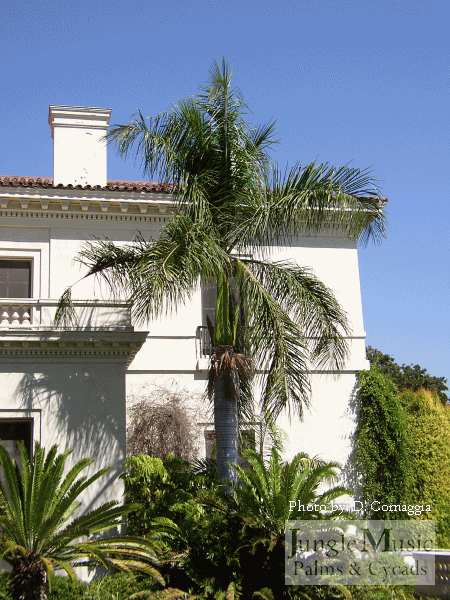
SABAL BERMUDANA
THE BERMUDA PALMETTO
Locality of Origin: This species is endemic to Bermuda.
Type of Palm / Leaf Type: Palmate
Solitary/Suckering: Solitary
Plant Height Mature: In cultivation this species gets 25-30′ tall. Palms in habitat have been recorded as getting over 80′ tall. I speculate that plants this tall are pushing two centuries old.
Comments on Trunk: Trunks species makes large vascular trunks which are light gray color. In cultivation, this species get a trunk about 14-16″ in diameter.
Sun Requirements: Partial to full sun.
Cold Tolerance: This species is hardy to 18-20 degrees F.
Speed of Growth: Slow to moderate rate of growth
Particular Characteristics: This species tends to carry very full, dense crowns of (costapalmate) green to blue/green leaves. They are slow to trunk but are steady growers and make leaves regularly. It is a large palm and, like other large Sabals, requires a garden with some space.
Rarity: Moderate
General Description/Comments: This species is well suited to both tropical and desert garden designs. It is very adaptable and can be grown in a wide array of climates ranging from desert to tropical. Even as a young plant this species is impressive as it makes showy leaves relatively quickly.
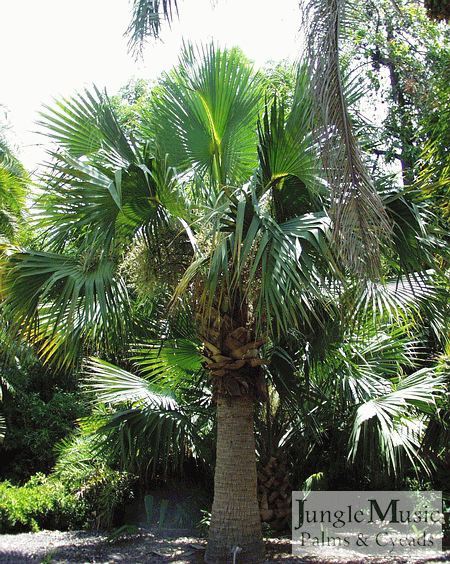
SABAL CAUSIARUM
THE PUERTO RICO PALMETTO
Locality of Origin: This species has a very large distribution. It is endemic to the British Virgin Islands (and nearby Caribbean islands), Hispaniola (Dominican Republic and Haiti) and Puerto Rico.
Type of Palm / Leaf Type: Palmate
Solitary/Suckering: Solitary
Plant Height Mature: This is a very tall species (eventually). It can get up to almost 50′ in the wild, though in a domestic setting more along the lines of 25-30′.
Comments on Trunk: This species makes a very large, columnar trunk which is similar in appearance to a concrete highway pillar. The trunk diameter is approximately 2 feet in diameter, though they can get even a bit larger than that!
Sun Requirements: Partial to full sun.
Cold Tolerance: This species hardy to about 20 degrees F.
Speed of Growth: Slow to moderate to make trunk, though makes leaves relatively quickly.
Particular Characteristics: This is an impressive palm not matter what way you cut it. It is large and stately and makes huge, blue/green costapalmate leaves which could almost cover a small car. The do require a large space to be grown as the make large everything and tend to sprawl a bit if you let them.
Rarity: Moderate
General Description/Comments: This is a beautiful species which I recommend, if you have the space. There is some debate whether this is the same species as, or a cultivar of Sabal domingensis. They do bear many similarities and come from the ‘same’ general localities. Short of genetic testing it is hard to say for sure. Superficially they do bear some morphological and cultural differences, which can be explained by listing one as a ‘cultivar’. To my eye there also seems to be distinct differences in the fruit/seed and inflorescents between the species as well. Highly recommended.
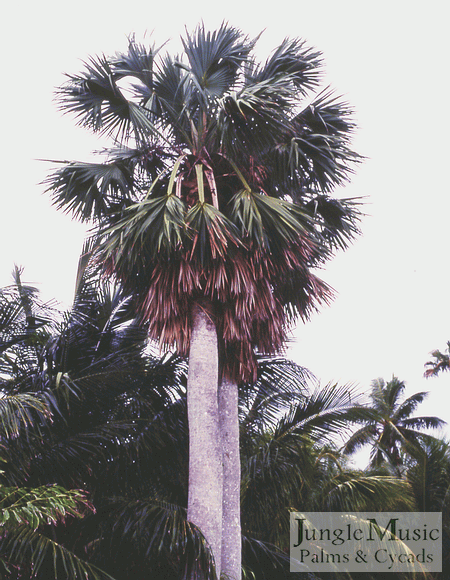
SABAL PALMETTO
THE CABBAGE PALM
| Locality of Origin: Southeastern lowland areas of the United States – up to the Carolinas and south through Florida and in Cuba and various Caribbean Islands. It is very common in areas of Florida to see this palm populating many lowland areas with literally tens of thousands of this species. Type of Palm / Leaf Type: Palmate, a fan palm Solitary/Suckering: Solitary Plant Height Mature: Although rarely seen to this height, especially in gardens, this species can get to 45 feet in habitat. Comments on Trunk: Trunks of this species are usually loaded with old leaf bases. When they get very old and tall, the trunks become clean although rough to the touch. Sun Requirements: Full sun Cold Tolerance: This species is fairly cold hardy and can take temperatures into the upper teens F. Speed of Growth: Average Particular Characteristics: The leaves are green as shown and about three to four feet across. Trunks are about 10 to 12 inches in diameter. When well grown, the full crown of leaves can make a near circular show of leaves. Rarity: Somewhat rare on the West Coast. more common in Florida General Description/Comments: This is a very utilized palm in the Southeast and commonly dug and relocated to other areas in these localities. In the West Coast, it’s much more difficult to find. We’ve found some people who have moved to California have a fond memory of this palm and nothing else will suit them. |
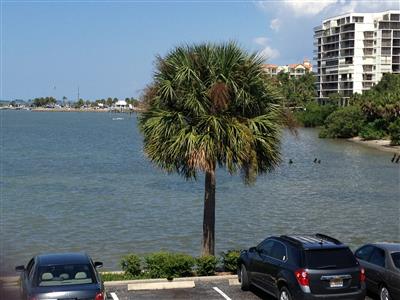
SABAL MINOR
THE DWARF PALMETTO
Locality of Origin: This is a species native to the United States through many of the Southern States (Alabama, Arkansas, Georgia, Florida, Louisiana, Mississippi, North Carolina, Oklahoma, South Carolina, and Texas). NOTE: This species does vary depending on locality.
Type of Palm / Leaf Type: Palmate
Solitary/Suckering: Solitary
Plant Height Mature: This plant is variable depending on sun exposure and cultivar – expect something between 3-6′. Though some cultivars related to this species get taller.
Comments on Trunk: The trunk on this species is acaulescent (having no stem or having a short stem concealed below the ground).
Sun Requirements: Partial to full sun.
Cold Tolerance: This species is hardy to about 5 degrees F. Though this can vary with cultivar type.
Speed of Growth: Slow to moderate rate of growth.
Particular Characteristics: This is an interesting low growing palm. It is successfully being grown all over the word in climates which experience extreme heat and cold. They tend to carry moderately sparse crowns of leaves, though very happy ones can be full. The have a broad costapalmate leaf, which tends to sprawl and is green to blue/green in color. Another interesting characteristic of this palm is that they are exceptionally water tolerant. This is not surprising they can be found in swamps in habitat. They are also tolerant salt water as well, which most genera are sensitive to.
Rarity: Common to Moderate depending on cultivar
General Description/Comments: This is a great short palm and can be enjoyed in diverse climates and garden types. It is slow growing, but steady and is easy to propagate from seed. If you need a smaller palm, have less than ideal growing conditions (though they do fine in great growing conditions too), this might be an excellent species to consider trying. For what it is and its being so small, it is highly recommended
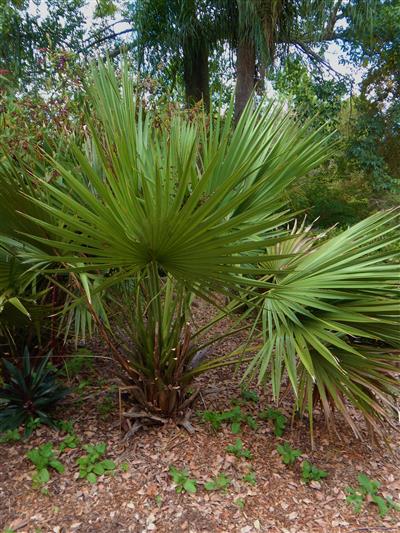
SABAL RIVERSIDE
THE RIVERSIDE PALMETTO
Locality of Origin: The origin of this species is not know. The seeds of this plant were first collected on an estate in Riverside, CA (thus the name), which no longer exists. The original seeds were collected by Ed Moore (1915-2012) – former Palm Society president and a dearly missed friend. The exact lineage of this species is debated. It could be a hybrid or variation of Sabal domingensis, Sabal palmetto or Sabal bermudana. It is unknown at this time. Without genetic testing it is hard to say if the true lineage of this plant will every be known.
Type of Palm / Leaf Type: Palmate
Solitary/Suckering: Solitary
Plant Height Mature: This species can get up to approximately 35′.
Comments on Trunk: Like many of the Sabals, this species bears in intricate latticework of robust retained leaf bases (which can be climbed like a ladder). The are pale and have a slight golden hue to them. They are quite robust and can have a trunk up to 2′ in diameter!
Sun Requirements: Partial to full
Cold Tolerance: This is a very hardy species which can tolerate into the teens (14 -16 degrees F).
Speed of Growth: This is one of the fastest growing Sabals.
Particular Characteristics: This is a beautiful species which will work in most gardens (tropical or other). It is fairly low maintenance, but does have to be trimmed, or it will have a skirt – which is not uncommon for this genus. It produces huge, blue/green costapalmate leaves, which are about 7-8′ in diameter. It addition to be a very cold hardy palm, it is also very tolerant of hot dry climates and works well in desert areas.
Rarity: Rare
General Description/Comments: This is one of the most gratifying Sabals to grow. It will trunk and make leaves more quickly than most species, it is a canopy forming/’statement’ palm and it is adaptable to most climates and garden styles.
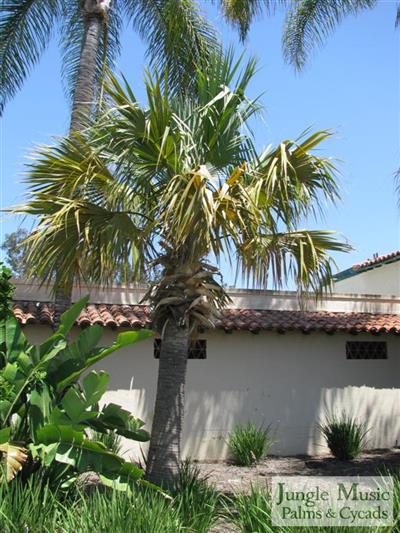
SABAL URESANA
THE SONORAN PALMETTO
Locality of Origin: This species is endemic to northern Mexico.
Type of Palm / Leaf Type: Palmate
Solitary/Suckering: Solitary
Plant Height Mature: This species can get up to 25-30′.
Comments on Trunk: The trunk on this species bears thick, lattice-like retained leaf bases. They are generally light, whitish color and give and interesting framework below the crown. In the wild is is not uncommon to see them with with a clean, vascular trunk – this can be attributed to fires which burn away the retained bases. The trunk diameter is 14 -16″.
Sun Requirements: Full sun
Cold Tolerance: This species is hardy into the upper 20’s (28-29 degrees F) though some people report it taking in to the mid 20’s (25-27 degrees F). I would suggest exercising caution, as I believe this would be pushing the limits of this palm.
Speed of Growth: Slow to medium rate of growth.
Particular Characteristics: This species has stunning white costapalmate leaves. There is a green variation of this species, which amongst collectors is generally less desirable. Though they are similar in color to Bismarckia nobilis, they differ completely in growth habit and general looks (outside of color). They are also slower growing and smaller (in height and trunk diameter). They are very tolerant of heat and make excellent palms for the desert or hot (and dry) climates.
Rarity: Very
General Description/Comments: This is one of my two favorite Sabals. It is botanically unique and stunning to see in ANY landscape. It is tolerant of water, though can go fairly dry as well. Which makes it adaptable to tropical and low-water landscapes alike. Photo in habitat by Jeremy Spath
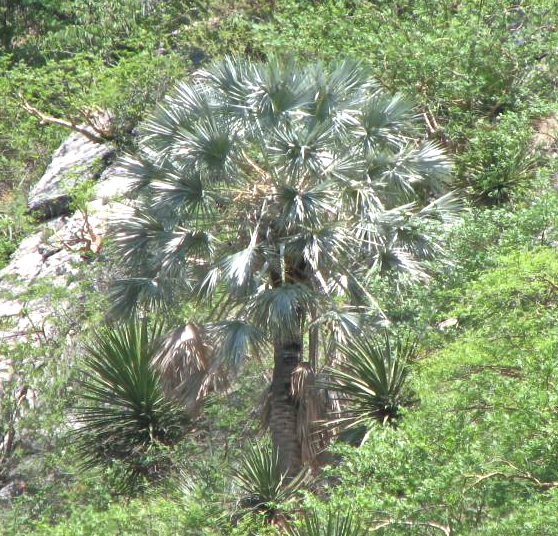
SABAL, OTHER SPECIES
A WHOLE WORLD OF LARGE FAN PALMS
Sabals are a New World fan palm that varies in size from small to large. Most are very cold hardy. Almost all want full sun, but there are a few like Sabal mauritiformis which tolerate part day sun. Sabal bermudana is known for its thick, clean trunk. Sabal uresana has blue leaves. All are easy to grow with cold hardiness of many into the mid to upper teens. There are about fifteen known species of Sabal. We cannot describe them all here. But, if you like them, an Internet search will quickly give you photos and more information. Shown to the right is a more tropical species, Sabal mauritiformis.
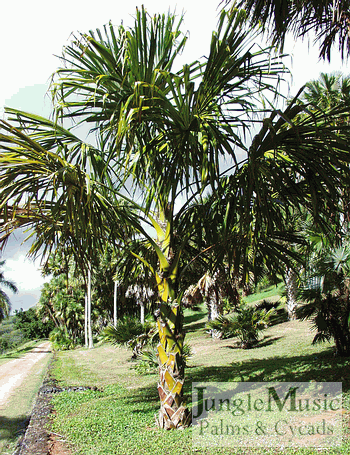
SYAGRUS BOTRYOPHORA
THE PATI QUEEN PALM
Locality of Origin: This species is endemic to Brazil.
Type of Palm / Leaf Type: Pinnate
Solitary/Suckering: Solitary
Plant Height Mature: This species gets up to 40′ tall, though I have seen few exceed 25′ in cultivation.
Comments on Trunk: This species has a very slender trunk for a Syagrus. The vascular trunk is pale and tends not to retain debris, like many other Syagrus species. It is about 7-8″ in diameter, but on robust specimens I have seen the be closer to 8-10″.
Sun Requirements: Partial to full sun.
Cold Tolerance: This species is hardy to approximately 30 degrees F.
Speed of Growth: Medium to fast rate of growth.
Particular Characteristics: This is a very nice species and hardly looks like most of the other Syagrus. It has short, keeled (“v” shaped) leaves which tend to be rigid. It is a good grower, but is sensitive to dry winds and tends to burn during Santa Ana’s without protection. Younger specimens can hold multiple ranks of leaves and be quite full. Older specimens often have more sparse crowns than their younger counterpart, but still are nice. This species seems to do better in more temperate climates, rather than extremely hot/dry or cold environments. It also seems look its best in climates which are high in humidity.
Rarity: Rare
General Description/Comments: This is a great species. It is unique amongst Syagrus and has a delicate elegance to it. With protection it makes an excellent addition to most gardens and will work in compact/small garden spaces. I have seen several in cultivation, but the best looking ones are never getting full exposure to the elements.
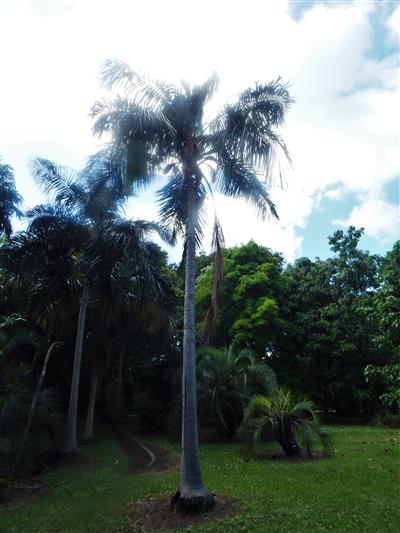
SYAGRUS CORONATA
THE LICURY PALM
Locality of Origin: This species is endemic to Brazil
Type of Palm / Leaf Type: Pinnate
Solitary/Suckering: Solitary
Plant Height Mature: This species can get up to about 20′ (after decades), and about 30′ in the wild, though I have never observed this in cultivation.
Comments on Trunk: This species makes a medium, vascular trunk which is a dark, woody color. They get approximately 10-12″ in diameter. The trait that sets the species apart is that spiraling or corkscrew effect created by the retained leaf bases. This can also be observed in the internodal segments upon closer inspection.
Sun Requirements: Full sun
Cold Tolerance: This species is hardy to the mid 20’s F.
Speed of Growth: Slow to medium growth rate.
Particular Characteristics: This species has beautiful plumose leaves which are blue/green or silver in color. This ornamental species is drought and heat tolerant and makes an excellent species for desert climates. It needs a well drained soil or can get into fungal/rot issues.
Rarity: Rare
General Description/Comments: This is one of my favorite (pure) Syagrus. It is quite ornamental in both its leaves and crown. Though it is fairly slow growing, it is quite sturdy and will work in most gardens (with a little patience). It is better suited for hot climates and for gardens which cater (at least partially) to a Mediterranean or low water landscape. It can work in tropical gardens as well.
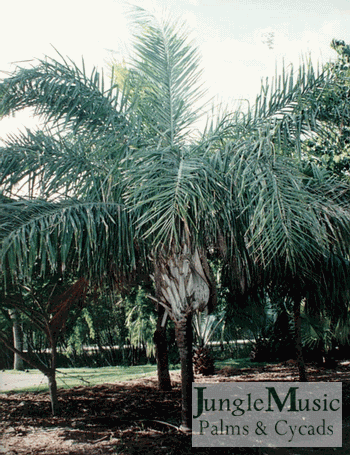
SYAGRUS OLERACEA
THE BITTER COCONUT PALM
Locality of Origin: This species is endemic to Brazil and Paraguay.
Type of Palm / Leaf Type: Pinnate
Solitary/Suckering: Solitary
Plant Height Mature: This species grow to 40-45′ tall, though they reach over 60′ in the wild.
Comments on Trunk: The trunk on this species is narrow for the height it achieves. The base can get 12-14″ in diameter, but is more narrow as you go up the trunk. The crown is wrapped in dark brownish/black fibers, which are quite striking against the pale vascular trunk.
Sun Requirements: Partial to full sun.
Cold Tolerance: This species is hardy to 28-30 degrees F.
Speed of Growth: Moderate to fast rate of growth.
Particular Characteristics: This is an interesting species of Syagrus which you rarely see in cultivation. They carry full crowns of leaves (which are plumose – like many of the Syagrus), which tend to be dependent in nature. Though it does bear some similarities to Syagrus romanzoffiana, it is more tropical looking with fatter leaflets and fuller crowns of leaves.
Rarity: Very
General Description/Comments: This is an easy to grow species, though they do not grow as quickly as Syagrus romanzoffiana or other species of Syagrus which make large palms. It is almost never seen in cultivation, which is unfortunate as it is a far more interesting and beautiful alternative to a queen. Another point of interest is that this species makes a very large seed (about 2″ long), about 2X the size of a Syagrus romanzoffiana.
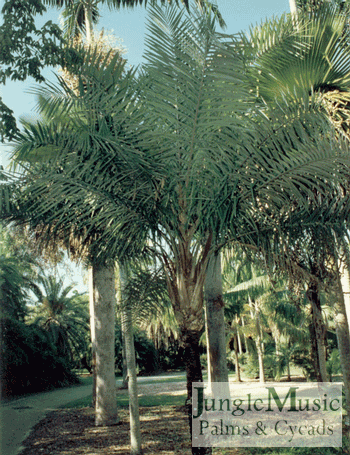
SYAGRUS ROMANZOFFIANA
THE QUEEN PALM
Locality of Origin: This species is endemic to Argentina, Brazil, Paraguay and Uruguay.
Type of Palm / Leaf Type: Pinnate
Solitary/Suckering: Solitary
Plant Height Mature: 60-70′
Comments on Trunk: This species makes a medium to large trunk. They can range in size (depending on culture) from about 12″ to about 20″ on large healthy specimens.
Sun Requirements: Partial to full sun
Cold Tolerance: This species is hardy down to the low 20’s F. In 2007 we had a hard freeze in San Diego county. Some areas saw into the teens. I know of some queens which saw down to about 18 degrees F, were severely burned, but came back around.
Speed of Growth: This species is fast.
Particular Characteristics: This is a fast, aggressive growing palm. It makes long plumose leaves, and generally carry full crowns. They are adaptable to many climates and will tolerate ‘less than ideal’ care (lack of water, fertilizer, fires, etc.). This is a limit to how much abuse they can tolerate, but they are a tough plant nonetheless. This palm is quite common in southern California and can be found just about anywhere. They are excellent canopy formers, and despite being messy and needing regular maintenance are hard to beat as regards rate of growth, toughness and creating shade.
Rarity: Common
General Description/Comments: This is a very easy to grow species, and is found throughout the western seaboard. You can grow them from seeds and they are easily transplanted. As this is the case, they were grown and marketed throughout southern California. The market over the past several years has cooled on them, to the point where there is very little demand for them amongst businesses, home owners and collectors. Their value has also dramatically decreased over the years to the point that most people will cut them down rather than spare the expense of having the dug and moved. Some people are lucky and can find landscape contractors who need them for a job.
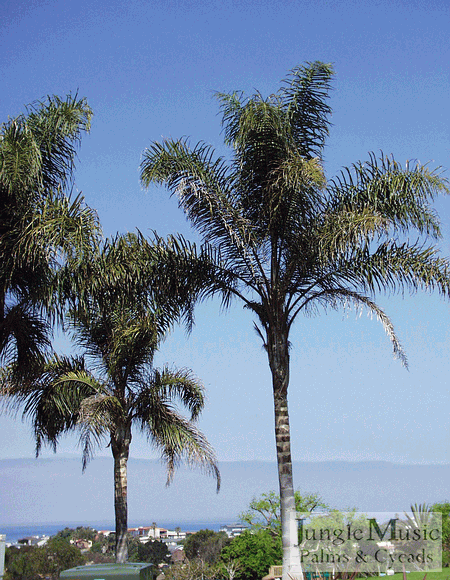
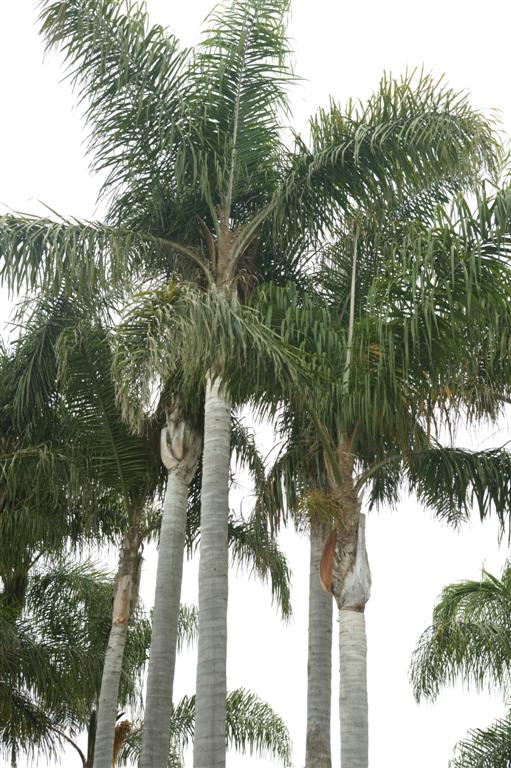
SYAGRUS ROMANZOFFIANA X SYAGRUS SCHIZOPHYLLA
THE COCONUT QUEEN PALM
Locality of Origin: This is a manmade hybrid. It does not have a country of origin. The seed of ALL extant were created in Thailand, by Jack Ingersoll.
Type of Palm / Leaf Type: Pinnate
Solitary/Suckering: Solitary
Plant Height Mature: It is unknown at this point how tall the will ultimately get. I have not observed any much over 20′, but it is speculated that ultimately they will get up to perhaps 30′.
Comments on Trunk: This species has a clean, light vascular trunk which is about 12-14″ in diameter.
Sun Requirements: Partial to full sun
Cold Tolerance: The ultimate cold tolerance of this palm is not entirely known. We do know specimens which have taken down to 20 degrees F. It is hard to say at this point if they will take any colder than that, and if so, for how long.
Speed of Growth: Medium to fast rate of growth
Particular Characteristics: This species is fairly fast growing and seems to be very tolerant of both cold and heat. Making it an adaptable palm for many different climates. It is more comely than either parent and is not as overbearing, nor messy as a queen palm (Syagrus romanzoffsiana). I have seen few palms which carry such full green crowns of leaves, which aren’t finicky about something (even queens seem to be more picky than this hybrid).
Rarity: Ve
General Description/Comments: This is one of my favorite hybrids. It is absolutely beautiful. In fact when I first saw a larger specimen, I immediately bought one and planted it – let me mention that I am not a huge fan of Syagrus romanzoffiana nor Syagrus schizophylla. This species, though it shares aspect of both parent plants is far superior in every way. The long, upright leaves are and full and deep green. They have more narrow, shorter trunks. An additional bonus is that the blossoms are very sweet smelling. We highly recommend this palm. First photo by J.I.
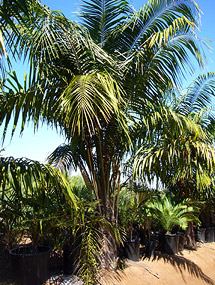
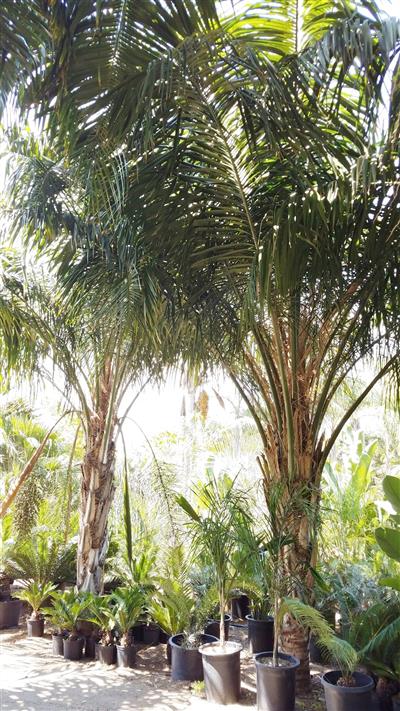
TRACHYCARPUS FORTUNEI
THE CHINESE WINDMILL PALM
Locality of Origin: This species is endemic to China as the name would suggest, but may also have natural stands in southern Japan. It is likely that the species was brought there at some point and later naturalized, though that is unclear at this point.
Type of Palm / Leaf Type: Palmate
Solitary/Suckering: Solitary
Plant Height Mature: This species get up to about 35-40′.
Comments on Trunk: The trunk is covered in long dark fibers from top to bottom. With enough age the fibers will rot off towards the base exposing a vascular trunk, which range from 10-12″ in diameter.
Sun Requirements: Partial to full sun
Cold Tolerance: This is the most cold tolerant species of the genus, and one of the most cold tolerant palms period! They can take into the single digits, approximately 5 degrees F.
Speed of Growth: Slow to medium rate of growth
Particular Characteristics: The ‘Chinese Windmill Palm” has become synonymous with ‘palm tree’ in many localities around the world. This is because it can grow in areas where most palms cannot. It has sturdy stiff leaves which are glaucous on the undersides and think insular fibers which all protect the plant from cold and heat.
Rarity: Common.
General Description/Comments: This species is being grown in more places in the Americas than most palm species. This is due to it adaptability to a wide array of climates. Ranging from extreme (like Arizona and Nevada) heat to extreme cold like Quebec, Canada. Whereas it may not be the most beautiful of the genus, it is certainly the toughest and will work in inhospitable climates for those who would like to grow palms.

TRACHYCARPUS LATISECTUS
THE HIMALAYAN WINDMILL PALM
Locality of Origin: This species is endemic to northern India and Nepal.
Type of Palm / Leaf Type: Palmate
Solitary/Suckering: Solitary
Plant Height Mature: 20-25′, though they reach up to about 40′ in the wild.
Comments on Trunk: This species does have a fibrous trunk and crown as a younger specimen. On more mature specimens, this species will almost completely shed its fiber revealing a vascular stem. The stems are fairly narrow not getting much larger than 7-8″ in diameter.
Sun Requirements: Partial to full sun.
Cold Tolerance: This species is fairly hardy, and will take between 23-25 degrees F.
Speed of Growth: Slow to medium growth rate
Particular Characteristics: This species is very attractive, and is quite unique compared to other species within the genus. First of all it loses almost all of it fiber, which none of the other species do. Second the leaves are completely green (non-glaucous), larger and softer/less rigid than most of the other species. Consequently, this gives the palm a much more tropical and cleanly look than the other species within the genus.
Rarity: Very
General Description/Comments: This is an easy species to grow, and has proven to be faster than some of the other species within the genus. It is apparent that it isn’t as cold hardy as some, but will work in many climates that experience periodic freezes. I do recommend this species and think it is ultimately one of the prettier Trachycarpus you can grow. Photo by Martin Gibbons, shown in photo.
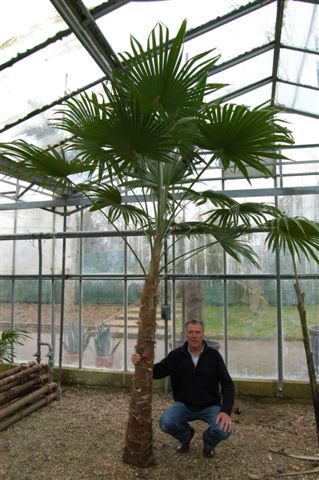
TRACHYCARPUS TAKIL
THE KUMAON PALM
Locality of Origin: This species is endemic to northwestern India and neighboring Nepal toward the base of the Himalayas.
Type of Palm / Leaf Type: Palmate
Solitary/Suckering: Solitary
Plant Height Mature: In the wild, this species can reach heights of up to 40′. In cultivation, this is essentially unheard of – most will not exceed 20-25′.
Comments on Trunk: This species has a fibrous brown trunk. In older specimens, the fiber around the base of the trunk sheds, exposing a vascular stem. The trunk diameter on this species is about 8-10″.
Sun Requirements: Partial to full sun
Cold Tolerance: This species is hardy to about 15 degrees F.
Speed of Growth: Slow to moderate grower.
Particular Characteristics: Historically Trachycarpus takil and Trachycarpus wagnerianus were confused. In seeing larger specimens, it is apparent that they are NOT the same species. As small plants, it can be difficult to tell the two apart – especially when grown in low light. One dead ringer is that the hastula on the Trachycarpus takil tends to be protracted and irregular. This species also has more deeply divided leaves and bears more similarity (in appearance) when mature to Trachycarpus fortunei.
Rarity: Moderate
General Description/Comments: This is is an great fan palm for cold weather climates. We have a customer in Vermont growing this species, which has been featured in Christmas cards with snow on it! Though similar to Trachycarpus fortunei, it is more tropical looking as it’s divisions are broader and the leaves themselves are bigger in scale, relative to trunk size
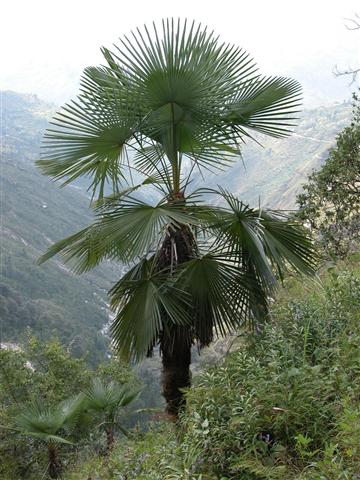
TRACHYCARPUS WAGNERIANUS
THE WAGGIE PALM
Locality of Origin: The native habitat of this species is not known. There is speculation that this species originates from Japan.
Type of Palm / Leaf Type: Palmate
Solitary/Suckering: Solitary
Plant Height Mature: In the ‘wild’, this species can reach a height of 20′. This is not ever really seen in cultivation though. Generally very old specimens reach about 10-15′.
Comments on Trunk: The trunk is covered in a dark brown fiber and gets about 8-10″ in diameter. Very old specimens will start to lose fiber toward the base of the trunk, exposing a vascular stem.
Sun Requirements: Partial to full sun.
Cold Tolerance: This species is hardy down to about 20 degrees F. The are multiple records of this plant seeing colder (upper teens) weather without issue.
Speed of Growth: This species is a slow to moderate grower.
Particular Characteristics: This species is very attractive for the genus. The petioles are shorter, the leaves are compact and very round and are less divided than other species within the genus. This species is generally touted as a “slow” grower which is true in terms of gaining height, but it does make leaves regularly and typically carries a very full crown.
Rarity: Moderate
General Description/Comments: This is an excellent palm for colder (and hot) climates. This species, as well as many other Trachycarpus, are sometimes one of the few palms that people can grow in climates that experience extreme cold. This is not the most hardy of the Trachycarpus, but I do recommend this species for people in more extreme climates or those who have limited space. Highly recommended.

TRITHRINAX ACANTHICOMA AKA TRITHRINAX BRASILIENSIS
Locality of Origin: This species is endemic to Brazil.
Type of Palm / Leaf Type: Palmate
Solitary/Suckering: Solitary
Plant Height Mature: This species can get 20-25′, but is slow to achieve such heights
Comments on Trunk: This palm gets a trunk approximately 12-15″ in diameter. It is armed with long needlelike spines, which will fall away at the base of the stem with age, though this can take several years. It makes large round seeds which are a pale white/yellow color.
Sun Requirements: Partial to full sun.
Cold Tolerance: This species is hardy to 10-15 degrees F.
Speed of Growth: Slow to moderate growing species
Particular Characteristics: This is the only solitary trunked species within this genus. The trunk is more robust than the other species and it gets taller. Additionally it is faster growing than any of the other species within the genus.
Rarity: Moderate
General Description/Comments: This is a hardy species and is the most ‘tropical’ of all the Trithrinax. It is not as sun hardy as the other species, specifically, it does not do as well with extreme heat in full sun. It requires a well drained soil, but is more tolerant of moisture than the other species.

TRITHINAX CAMPESTRIS THE CARANDAY PALM
Locality of Origin: Native to Uruguay
Type of Palm / Leaf Type: Palmate
Solitary/Suckering: Suckering
Plant Height Mature: 15-18′
Comments on Trunk: This species is heavily armed with long (5-6′) sharp spines. The trunks are a pale white on younger specimens, though turn a darker brown color as they mature. On very old specimens the fiber/spines will fall away from the lower potion of trunk, revealing a vascular/woody stem.
Sun Requirements: Full sun.
Cold Tolerance: This species is hardy into the low 20’s.
Speed of Growth: This is a fairly slow growing species, but will grow faster in hotter, more desert-like climates.
Particular Characteristics: This species is nasty from top to bottom. The stems are heavily armed with sharp spines, and each leaf tip is armed with a spine as well. Despite this, the have a beautiful blue color which and are tough as nails. This species really needs heat, and a well drained soil.
Rarity: Rare
General Description/Comments: This is a very hardy palm which really should be utilized more. It is uncommon to see it even amongst collectors. It is not a plant that you would want to touch, but as far as aesthetic appeal, toughness, color and security, it is really tough to beat.
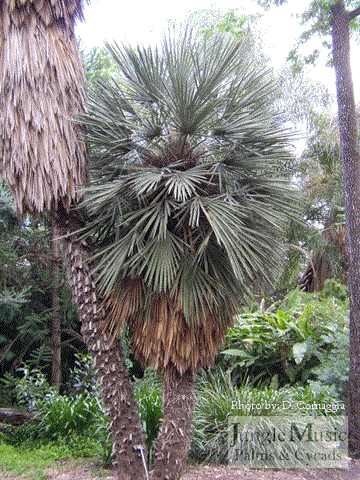
TRITHRINAX SCHIZOPHYLLA
AKA TRITHRINAX BIFLABELLATA
Locality of Origin: This species is native to Argentina, Bolivia, Brazil and Paraguay.
Type of Palm / Leaf Type: Palmate
Solitary/Suckering: Suckering
Plant Height Mature: This species gets about 15′ in cultivation (after MANY decades).
Comments on Trunk: This species produces several, heavily armed (spiny) trunks. Each trunk gets about 10″ in diameter with spines up to 6 inches in length.
Sun Requirements: Full sun is preferable, but they can grow in partial sun as well.
Cold Tolerance: This species is hardy into the mid 20’s.
Speed of Growth: This is a slow to moderate growing species.
Particular Characteristics: This is a very hardy species which will do well in most temperate to hot/arid climates. It leaves vary a bit in color, but are generally a blue/green color. Though it is armed with sharp spines, it is still a softer species than Trithrinax campestris. It needs a sandy, well draining soil.
Rarity: Very
General Description/Comments: This is a great plant for low water gardens and for arid/Mediterranean landscape designs. It can be used in tropical gardens as well, though prefers not to be excessively moist or shaded. Photo by TS at RPS
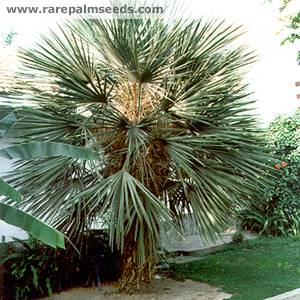
VEITCHIA ARECINA
THE MONTGOMERY PALM
Locality of Origin: This species is endemic to Fiji, Tonga, Vanuatu.
Type of Palm / Leaf Type: Pinnate
Solitary/Suckering: Solitary
Plant Height Mature: This species can reach up to 60′ in the wild, but in cultivation (non-tropics) I have not seen them exceed 25-30′.
Comments on Trunk: This species has a white crown shaft with blackish/brown tomentum (plant hair) toward the top of each leaf sheath. The trunk itself gets about a foot in diameter.
Sun Requirements: Partial to full sun.
Cold Tolerance: This species is hardy for a Veitchia. It will take into the upper 20’s, though I know of a few which have seen colder. Though I would say this is the exception rather than the rule.
Speed of Growth: Fast
Particular Characteristics: This fast growing, solitary species is much like many of the other Veitchias in appearance, though its crown is a bit more glaucous (white) and generally has longer leaves. Like Veitchia Joannis, this species has attractive, dependent (droopy) leaves which add to the tropical appearance of the species.
Rarity: Moderate
General Description/Comments: Until the introduction of Veitchia spiralis, I would said that the arecina was the best of all the Veitchias to grow. Presently I would say that the spiralis has substantially more hardiness and survivability in the west coast, but this is a bit preliminary. With this said, one could try either species.
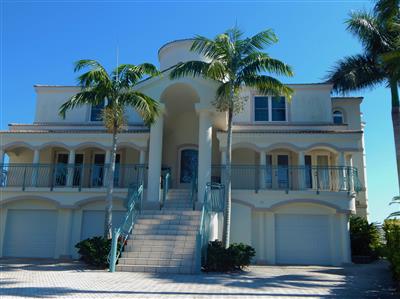
VEITCHIA JOANNIS
THE JOANNIS PALM
Locality of Origin: This palm is native to Fiji
Type of Palm / Leaf Type: Pinnate
Solitary/Suckering: Solitary
Plant Height Mature: This species gets about 20-25′ tall in cultivation.
Comments on Trunk: It has a whitish/green crown shaft with a vascular trunk. The trunks rarely exceed 12″ in diameter; often times they are 10-11″ in diameter.
Sun Requirements: Filtered light to full sun. In the desert much less sun.
Cold Tolerance: This species is hardy down to about 30-32 degrees F. I have heard of some taking a bit colder, but I would not count on this. They are what I would call a moderately cold hardy species.
Speed of Growth: Moderate to Fast growing species
Particular Characteristics: It has long premorse (possessing jagged tips) leaflets and moderately dependent (droopy) fronds. They are a tall, tropical looking tree and are often featured in photos of Fiji (only overshadowed by Coconut Palm photos). They like a well drained sandy or loamy soil.
Rarity: Moderate
General Description/Comments: This is a great self-cleaning species like all other Veitchias. It does not grow as quickly as some of the other species, but is not slow. For coastal or temperate areas, this would be a good plant to try.
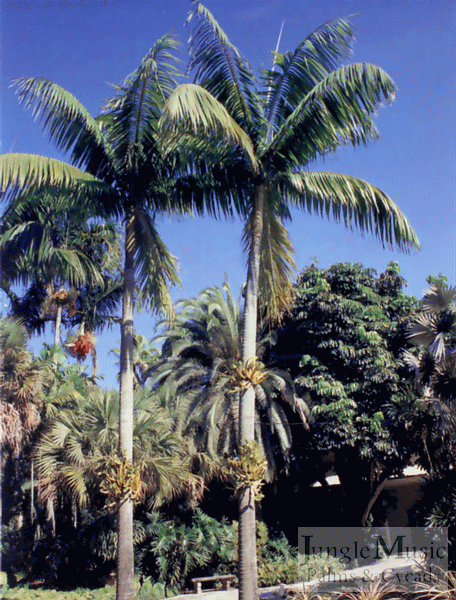
VEITCHIA SPIRALIS
EASIEST TO GROW OF GENUS
Locality of Origin: This species is endemic to both Aneityum and Futuna Islands (neighboring Vanuatu)
Type of Palm / Leaf Type: Pinnate
Solitary/Suckering: Solitary
Plant Height Mature: In the wild this species can get over 60′ tall. In cultivation it is hard to say if it will reach such heights as it is a relatively new introduction.
Comments on Trunk: This species has a beautiful, pale greenish/white crown shaft which is speckled with brown tomentum (plant hair). The trunk are slender, and on mature specimens will probably not exceed 10″ in cultivation.
Sun Requirements: Partial to full sun.
Cold Tolerance: This species will take a freeze and I know of plants taking into the mid 20’s. It is hard to say the extremes this species will take at this point, but it seems to be very hardy for a Veitchia.
Speed of Growth: Moderate to fast species
Particular Characteristics: This is a fairly fast growing species. It is hardy and quite beautiful. Younger specimens tend to have yellow/orange petioles, which will turn a white or green color as they mature. They premorse (possessing jagged tips) leaflets and carry a more erect crown than many of the other Veitchias. This species prefers a sandy or loamy soil that drains well.
Rarity: Very
General Description/Comments: We have grown several species of Veitchias over the years. From what I have seen, this seems to be one of, if not the, best for Southern California. They do not yellow nearly as much as the other species during cold or hot spells. They transition to sun much easier than the other species as well. I highly recommend this species.
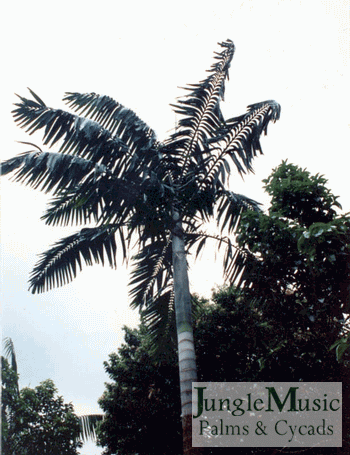
VEITCHIA WININ
THE MALAKULA PALM
| Locality of Origin: Vanuatu Type of Palm / Leaf Type: Pinnate Solitary/Suckering: Solitary Plant Height Mature: 35-40′ Comments on Trunk: This species have a beautiful white crown shaft with brownish/black tomentum at the top of the leaf sheathes. The trunk is woody/vascular and get about 10-12″ in diameter. Sun Requirements: Filtered light to full sun, depending on locality. Cold Tolerance: This species is moderately hardy and will take a freeze (32 degrees F), but not much below that. Speed of Growth: Moderate to fast growing species Particular Characteristics: This species is quite attractive. It has long premorse (possessing jagged tips) leaflets and dependent (droopy) fronds. As it is crown shafted, this is a self-cleaning species which carries relatively full crowns, provided you have adequate weather for them. They like a well drained sandy or loamy soil. Rarity: Moderate General Description/Comments: This is a large attractive palm, which can be grown in most temperate climates. It, like most of the Veitchias, has a very exotic look which will complement a tropical garden design. |
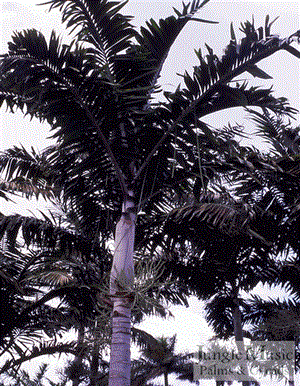
WALLICHIA DENSIFLORA
THE WALLICH PALM
Locality of Origin: This species is native to China, India and Nepal
Type of Palm / Leaf Type: Pinnate
Solitary/Suckering: Suckering
Plant Height Mature: Depending on exposure this species can be 6-8′ tall.
Comments on Trunk: This is a ‘trunkless’ species. This species does not grow a vertical, vascular trunk.
Sun Requirements: Filtered light to partial sun.
Cold Tolerance: This species is hardy from the upper to mid 20’s F.
Speed of Growth: Moderate to slow.
Particular Characteristics: The species is a sub-canopy species, which offers full tropical foliage. It is fairly hardy and does well for areas which do not get severe freezes. It has a premorse (possessing jagged tips) leaflets which are silver on the bottom. The individual leaflets tend to be more wide and tropical looking than Wallichia disticha, and works better to fill in shady, small plantable spaces, rather than be a statement palm all on their own.
Rarity: Very rare
General Description/Comments: This species is quite beautiful and is a great ‘filler plant’. As it is fairly hardy and will work in most gardens which do not experience hard or prolonged freezes. It will add some color as the broad leaflets are silver on the undersides. This species is monocarpic (when it flowers it starts to die), like Wallichia disticha, but this only applies to the stem in flower. I would recommend this species to anyone who has an established garden.
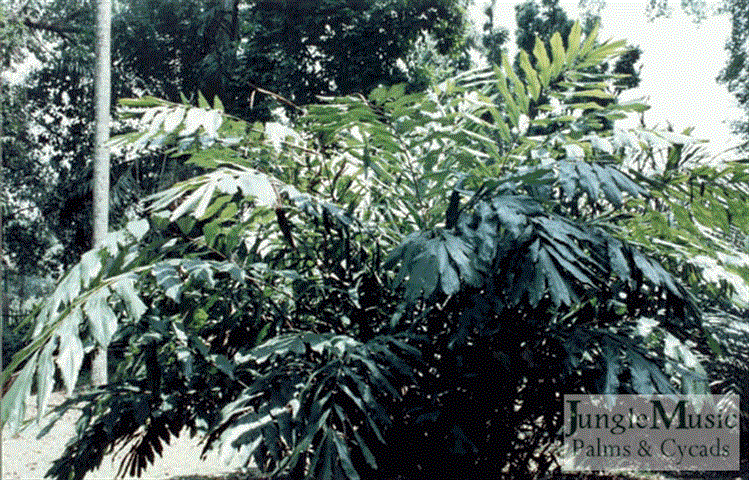
WALLICHIA DISTICHA
THE THAKAL PALM
PALM IN A SINGLE PLANE
Locality of Origin: This species has a large distribution in Asia (Thailand, India and China) and throughout Australasia.
Type of Palm / Leaf Type: Pinnate
Solitary/Suckering: Solitary
Plant Height Mature: This species can get up to 20-25′.
Comments on Trunk: This species has a fibrous trunk which can be vascular toward the base as old fibers fall off.
Sun Requirements: Partial to full sun, depending on locality. Along the coast, full sun recommended.
Cold Tolerance: This species is hardy to 28-30 degrees F. I know of some which have seen colder, but not for prolonged periods.
Speed of Growth: This species is a moderate grower.
Particular Characteristics: One of the most noteworthy characteristics of this palm is that it is distichous (i.e. it grows in two ranks/in a planar fashion). Additionally this species has a premorse (possessing jagged tips) leaflets which are silver on the bottom side. Additionally this species is monocarpic (‘mono’ meaning ‘one’ and ‘carpic’ meaning ‘bodied’), which mean that when it flowers, it starts to die. These species don’t live much beyond 15-20 years.
Rarity: This species is very rare in cultivation and difficult to find. Realize that a plant must seed and die before we can get seeds to grow it.
General Description/Comments: This is a beautiful and interesting species. The only downside to growing it is that they just live for about 20 years. Highly recommended
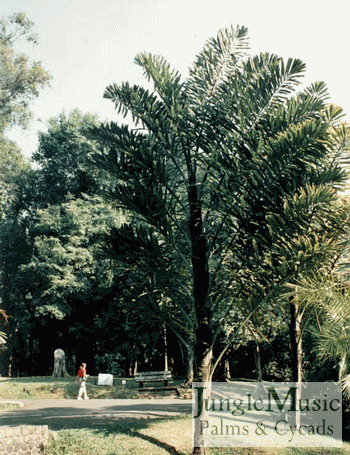
WASHINGTONIA ROBUSTA
THE MEXICAN FAN PALM
Locality of Origin: Mexico, though this palm has naturalized in California and Arizona.
Type of Palm / Leaf Type: Palmate
Solitary/Suckering: Solitary
Plant Height Mature: This palm can reach 100′ tall!
Comments on Trunk: This palm makes a large, vascular trunk, though tends not to be as thick as Washingtonia filifera.
Sun Requirements: Full sun
Cold Tolerance: This palm is hardy to 18-20 degrees F.
Speed of Growth: This species is fast growing.
Particular Characteristics: This palm is fast growing, and often can be found as a volunteer plant in gardens around California, Mexico and Arizona. They are robust (as the name would suggest) and do not require any sort of special care. Generally speaking, I would say they are better suited for inland areas, but they are exceptional plants along the coast as well. They have become the quintessential palm for photos and film of coastal California.
Rarity: Very Common
General Description/Comments: This palm is a fast growing species and readily available in large sizes. This sturdy palm digs well and is accommodating to many diverse climates. It is commonly used as a staple palm all over the western and southern seaboard for this reason. Something to be caution about when growing this species is that they do require regular maintenance. As they are a litter trapping species/petticoat (retained dead leaves which are skirt-like), if they are not properly maintained, they will drop debris and leaves which can cause damage to whatever it falls on. Also, if maintenance is deferred too long, they can become quite dangerous to prune.

WASHINGTONIA FILIFERA
THE CALIFORNIA FAN PALM
Locality of Origin: Southern California, Arizona into northern Mexico
Type of Palm / Leaf Type: Palmate – Fan palm
Solitary/Suckering: Solitary
Plant Height Mature: This species can reach a height of 60 feet or more.
Comments on Trunk: This species make a large vascular trunk which can exceed 2 feet in diameter. It retains old dead leaves and forms the “petticoat” as seen here.
Sun Requirements: Full sun
Cold Tolerance: This species is hardy to about 15 degrees F.
Speed of Growth: This species makes leaves quickly but is slow to produce vertical trunk.
Particular Characteristics: Like its counterpart Washingtonia robusta (the Mexican fan palm), this species does bear a petticoat (retained dead leaves which are skirt-like). They are very drought and heat tolerant palms and thrive in desert climates.
Rarity: Moderately rare and hard to find, especially from true wild collected seeds. It is uncommon to find this species un-hybridized in California and other localities. It commonly hybridizes with Washingtonia robusta giving an impure species. Even in habitat this can happen as the are commonly intermingled. The only sure way to get the true species is to collect seeds in habitat, where there are no Washingtonia robustas.
General Description/Comments: It is a common misconception that this palm is common. It is difficult to find this pure species for sale. This is because of hybridization. If you live in a hot, interior region, this palm will grow well for you. The two photos are from habitat in the Anza Borrego district of Southern CA. The second photo is by Gary Monroe.
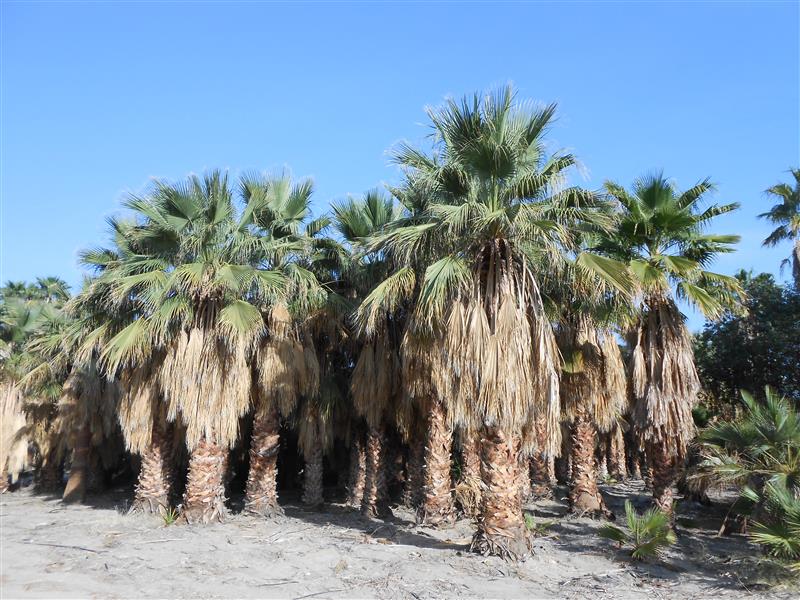

WODYETIA BIFURCATA
THE FOXTAIL PALM
Locality of Origin: Queensland, Australia
Type of Palm / Leaf Type: Pinnate
Solitary/Suckering: Solitary
Plant Height Mature: 20-25′
Comments on Trunk: This palm produces a gray, vascular trunk which tends to swell toward to middle. The crown shaft is often a whitish green color with fine brown or black tomentum (plant hair) toward the top of each leaf sheath.
Sun Requirements: Full sun
Cold Tolerance: This species is hardy to 25 degrees, perhaps a bit lower.
Speed of Growth: This species is a moderate grower. In hotter climates, they tend to grow more quickly than they do in temperate climates.
Particular Characteristics: This leaves on the species are plumose and fluffy. This is why their common name (foxtail palm) comes from, as it is reminiscent of a fox’s tail. They are a nice palm for any garden, and are often used as the focal species in landscape projects. They like a sandy, well drained soil and can run into problems if they are excessively wet or shaded.
Rarity: Slightly rare
General Description/Comments: This species is popular for many reasons. It is fairly quick growing, it is a self-cleaning species, it has a colorful crown and full beautiful leaves. Close to the ocean and salt air they may browntip. In tropical areas, this species thrives. In our area, if you get a lot of heat, it’ll probably do great. Highly recommended
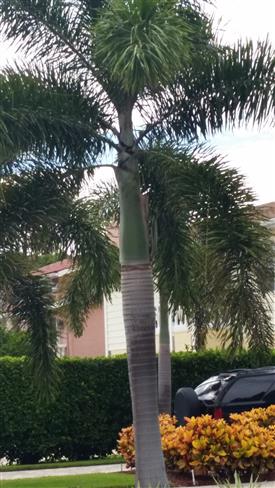
ZOMBIA ANTILLARUM
THE ZOMBIE PALM
Locality of Origin: Dominican Republic, Hispaniola and Haiti
Type of Palm / Leaf Type: Palmate (fan leaf)
Solitary/Suckering: Suckering species
Plant Height Mature: 8′-10′
Comments on Trunk: This species has a spiny, thatch-like trunk. The fibers are pale in color, though this can vary – especially in humid climates.
Sun Requirements: Partial to full sun.
Cold Tolerance: This species is hardy to about 30 degrees F.
Speed of Growth: Zombia is a very slow growing species. It can take several years, even decades (depending on locality) for it to reach a mature height.
Particular Characteristics: This palm tends to sucker moderately, though they can make full, clustered palms. The trunks are one of the more notable features of this palm as they are spiny and light colored (which distinctly contrasts the green foliage). Eventually the spiny fibers will rot away around the base of the trunk, exposing a woody/vascular stem.
Rarity: This is a very rare palm, and is very difficult to find.
General Description/Comments: This species has a full beautiful crown of leaves, which contrast nicely with the pale, spiny trunks. They like a sandy soil which drains well. They are ideally suited for filling in spaces below a canopy, and should be place where one can appreciate their interesting trunks. If you are lucky enough to see them flower, they have beautiful white, pear shaped seeds.


LINKS FOR MORE INFORMATION:
READ MORE ABOUT THE BEST CYCADS FOR SOUTHERN CALIFORNIA
- PALM TREES, CYCADS & TROPICAL PLANT BLOG - October 1, 2020
- TRACHYCARPUS
The Windmill Palm - September 30, 2020 - FAN PALMS –
PALMS WITH CIRCULAR LEAVES - September 29, 2020












